Barcelona – slow love, plus Tossa + Girona
#1
Original Poster
Join Date: Aug 2013
Posts: 747
Likes: 0
Received 0 Likes
on
0 Posts
Barcelona – slow love, plus Tossa + Girona
We just got back from 11 nights in Catalonia, starting with Barcelona, then taking the bus to Tossa de Mar, then to Girona, and returning to Barcelona for the end of the trip. Why “slow love” for Barcelona? Well, we are psychoanalyzing ourselves now to understand our reaction to the city, but it just did not grab us the way that, for example, Seville did. We loved many individual sights but somehow the spirit of the place did not grab us. Tossa and Girona, on the other hand, wowed us. More below.
We flew American from JFK, an easy flight, and spent four nights in Barcelona to begin the trip. I will just summarize the places we liked best instead of giving a day-by-day account. I’ll be very brief for the best known places, there are hundreds of descriptions in cyberspace, no need to waste more electrons.
To begin with the obvious: Sagrada Familia. Mmm. No. I worked hard to learn about Gaudi’s work, read a lot before departure, looked at a lot of pics on the web. But it’s not a style which appeals, to me that is.
Park Guell: a fascinating place, not only because of its design, but also because of the original purpose of the project. [Alert: this is being written by a history nerd; skip if it’s too much.] Eusebi Guell, Gaudi’s client, was one of the wealthiest men in Spain, his fortune based mainly on commerce with Cuba until Spain lost the island to the U.S. in the 1898 war. He married the daughter of another of Spain’s wealthiest men, Antonio Lopez y Lopez, who also amassed immense wealth from Cuban commerce, specifically from slave trading. He strongly defended slavery in the fact of the growing anti-slavery movement in Spain. Spain was the last European country to abolish slavery in 1886, three years after Lopez’ death. In 2018 Barcelona removed Lopez’ statue from the Via Laietana after growing protests.
Back to the park…Guell’s project, a housing development for the very wealthy on a hill overlooking the city, was a failure. Only two lots were ever sold, out of a total of 60. I find it intriguing that such an astute, successful entrepreneur could have invested so much money in such a project with apparently little careful market research. Gaudi’s buildings are immense. The space with the 80-something columns, originally designed to be the marketplace of this elite housing development, must have cost a fortune.

The columns of the marketplace
The engineering involved is impressive, since these columns are supporting the huge terrace above.
The crowds were not too heavy when we visited. The park had closed off the entrance to the left of the original entrance (the site of the “Hansel and Gretel” buildings)...
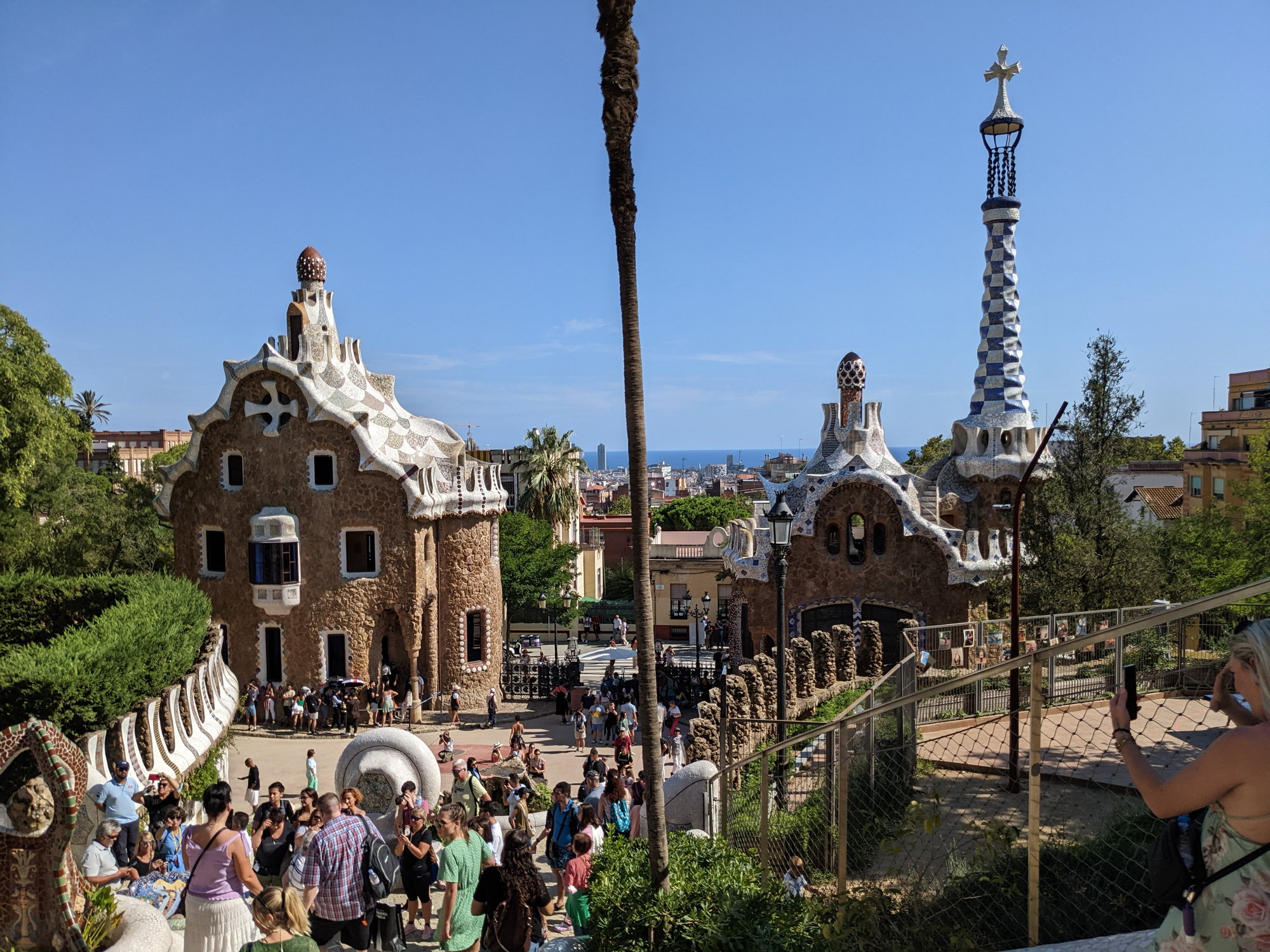
The "Hansel and Gretel" buildings at the main entrance
...and everyone was directed to the entrance to the right. Once inside, we had to follow paths through the beautiful gardens...
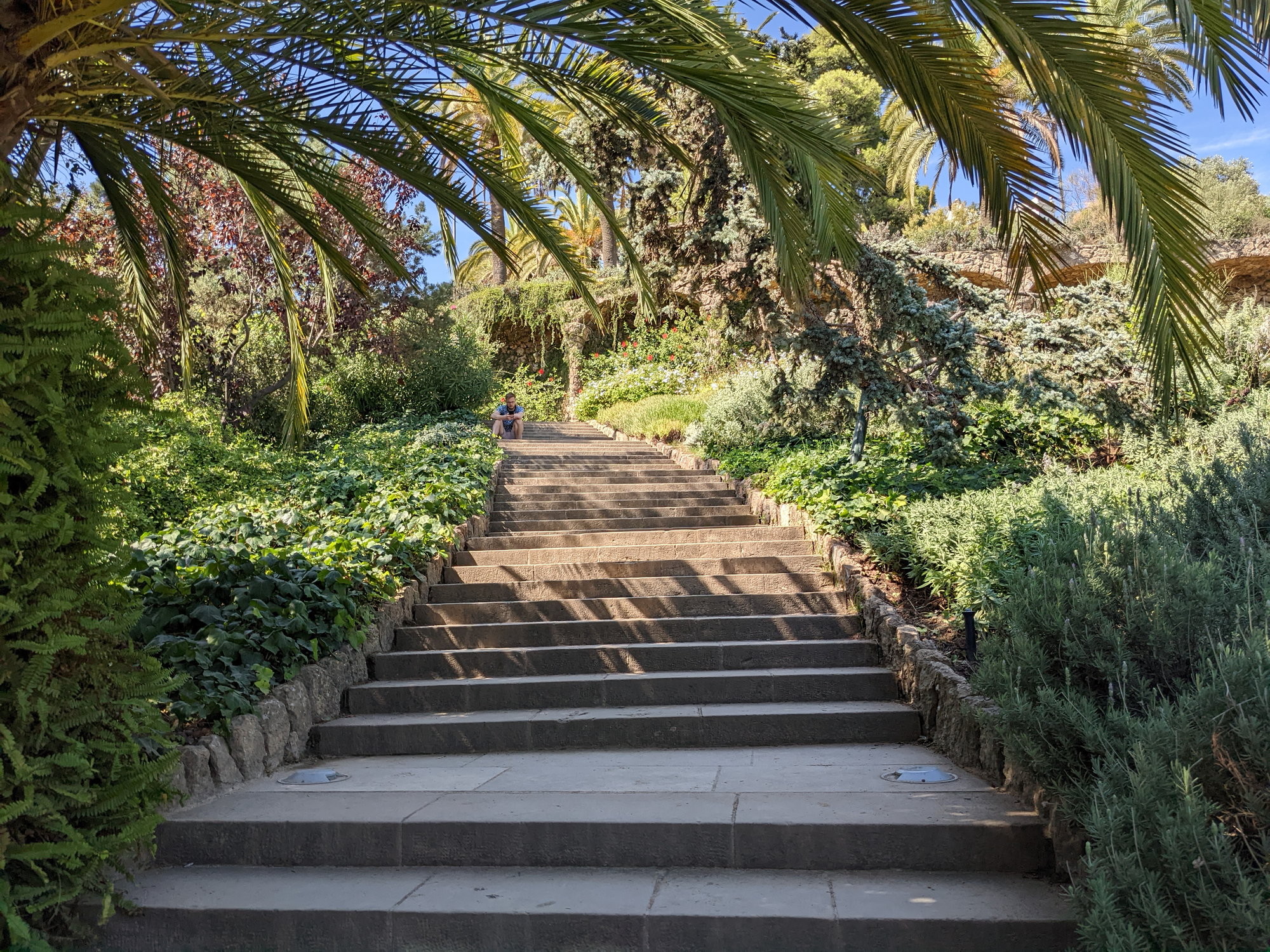
The gardens...on the way to the terrace
....before we could access huge terrace with the serpentine benches. The colorful tile benches are a visual delight...

The serpentine benches of the terrace
...and Gaudi designed religious symbols to be placed all over the tile work of the benches, symbols for the Virgin Mary, the cross, and so on. In fact, he infused the entire park with religious symbolism, with the highest part of the park being topped by three crosses, a sort of Calvary. Gaudi was a deeply religious and very politically conservative man; it’s hard for today’s visitor to reconcile this with his wildly imaginative designs.
During the anti-monarchy, anti-clerical riots of Barcelona’s Tragic Week in 1909, Gaudi sought shelter in the park as the churches and monasteries burned below in the city. Santa Maria del Mar was attacked and the fires burned for days in the church. Luckily, the mobs did not attack Gaudi’s Sagrada Familia—that would happen later, during the 1936 anarchist uprising when rioters invaded his work studio in the church and destroyed most of his models and papers.
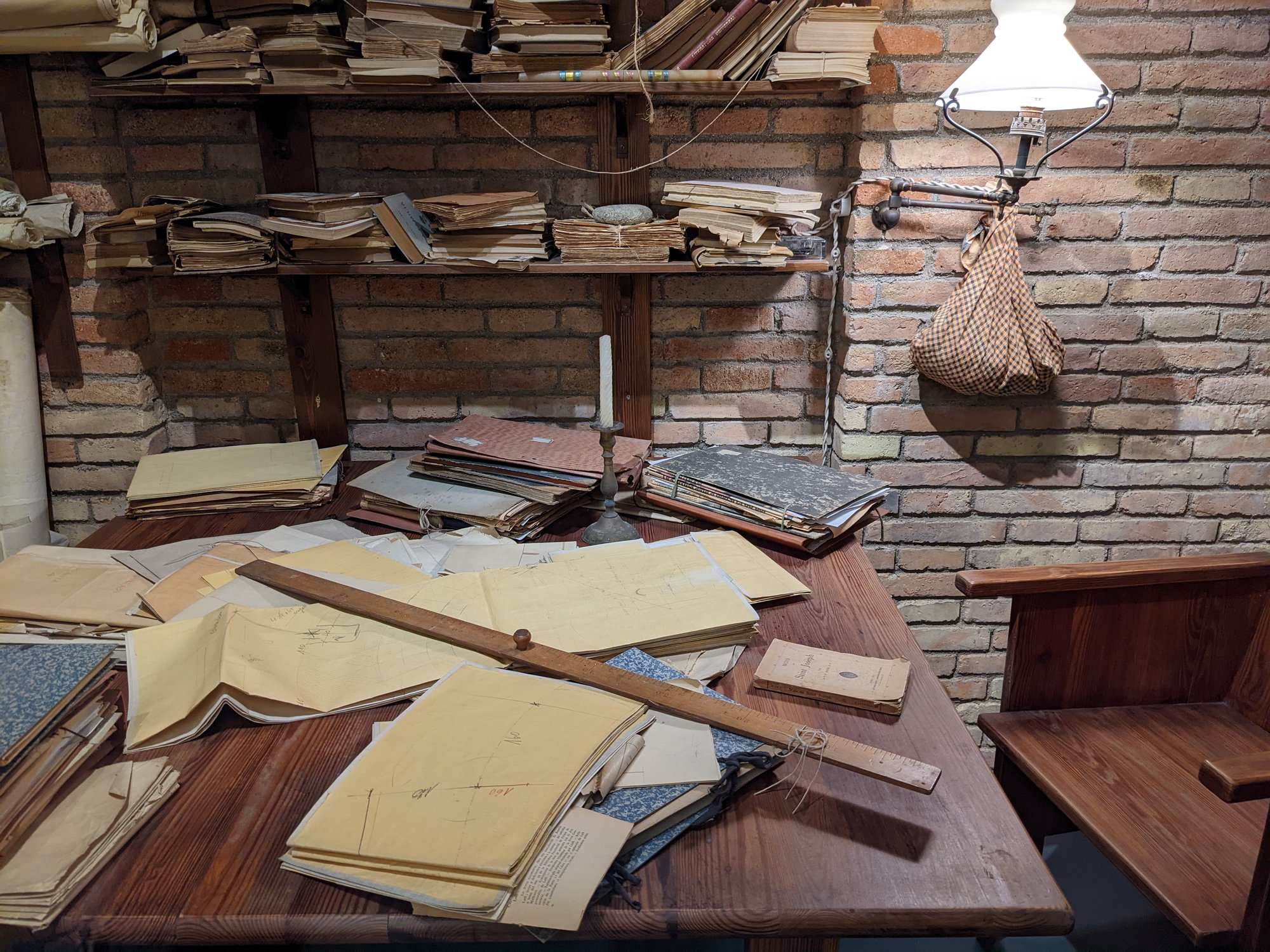
Gaudi's desk and surviving work papers
The surviving papers and his work desk are preserved in the Sagrada Familia museum.
Again, back to the park…

The "Drac" - Dragon
In spite of the crowds, I was able to get a good shot of the iconic dragon on the main entrance stairs (according to the current traffic pattern, visitors must go down these stairs on their way out of the park; it’s not possible to go up the stairs at the very beginning of the visit).
Next up: the Maritime Museum
We flew American from JFK, an easy flight, and spent four nights in Barcelona to begin the trip. I will just summarize the places we liked best instead of giving a day-by-day account. I’ll be very brief for the best known places, there are hundreds of descriptions in cyberspace, no need to waste more electrons.
To begin with the obvious: Sagrada Familia. Mmm. No. I worked hard to learn about Gaudi’s work, read a lot before departure, looked at a lot of pics on the web. But it’s not a style which appeals, to me that is.
Park Guell: a fascinating place, not only because of its design, but also because of the original purpose of the project. [Alert: this is being written by a history nerd; skip if it’s too much.] Eusebi Guell, Gaudi’s client, was one of the wealthiest men in Spain, his fortune based mainly on commerce with Cuba until Spain lost the island to the U.S. in the 1898 war. He married the daughter of another of Spain’s wealthiest men, Antonio Lopez y Lopez, who also amassed immense wealth from Cuban commerce, specifically from slave trading. He strongly defended slavery in the fact of the growing anti-slavery movement in Spain. Spain was the last European country to abolish slavery in 1886, three years after Lopez’ death. In 2018 Barcelona removed Lopez’ statue from the Via Laietana after growing protests.
Back to the park…Guell’s project, a housing development for the very wealthy on a hill overlooking the city, was a failure. Only two lots were ever sold, out of a total of 60. I find it intriguing that such an astute, successful entrepreneur could have invested so much money in such a project with apparently little careful market research. Gaudi’s buildings are immense. The space with the 80-something columns, originally designed to be the marketplace of this elite housing development, must have cost a fortune.

The columns of the marketplace
The engineering involved is impressive, since these columns are supporting the huge terrace above.
The crowds were not too heavy when we visited. The park had closed off the entrance to the left of the original entrance (the site of the “Hansel and Gretel” buildings)...

The "Hansel and Gretel" buildings at the main entrance
...and everyone was directed to the entrance to the right. Once inside, we had to follow paths through the beautiful gardens...

The gardens...on the way to the terrace
....before we could access huge terrace with the serpentine benches. The colorful tile benches are a visual delight...

The serpentine benches of the terrace
...and Gaudi designed religious symbols to be placed all over the tile work of the benches, symbols for the Virgin Mary, the cross, and so on. In fact, he infused the entire park with religious symbolism, with the highest part of the park being topped by three crosses, a sort of Calvary. Gaudi was a deeply religious and very politically conservative man; it’s hard for today’s visitor to reconcile this with his wildly imaginative designs.
During the anti-monarchy, anti-clerical riots of Barcelona’s Tragic Week in 1909, Gaudi sought shelter in the park as the churches and monasteries burned below in the city. Santa Maria del Mar was attacked and the fires burned for days in the church. Luckily, the mobs did not attack Gaudi’s Sagrada Familia—that would happen later, during the 1936 anarchist uprising when rioters invaded his work studio in the church and destroyed most of his models and papers.

Gaudi's desk and surviving work papers
The surviving papers and his work desk are preserved in the Sagrada Familia museum.
Again, back to the park…

The "Drac" - Dragon
In spite of the crowds, I was able to get a good shot of the iconic dragon on the main entrance stairs (according to the current traffic pattern, visitors must go down these stairs on their way out of the park; it’s not possible to go up the stairs at the very beginning of the visit).
Next up: the Maritime Museum
#3
Original Poster
Join Date: Aug 2013
Posts: 747
Likes: 0
Received 0 Likes
on
0 Posts
We went to the Maritime Museum, near the seafront, Sunday morning, our first day in Barcelona. (We arrived at the BCN airport at 6:45 a.m., breezed through customs, walked into our hotel, REC, on the edge of the Barri Gotic and Born, at 8:30 a.m. Lo and behold, not only did they let us into our room very early, but they also upgraded us for free!) If you are visiting Barcelona over a Sunday and Monday, take note of the opening times and days of museums and such. Many places are closed on Sunday, or have limited hours. This museum is one of the few which is open Sundays until 8:00 p.m. It also has a very nice café and restaurant with indoor and outdoor terrace seating.
This is an outstanding museum, housed in the centuries old building, as far back as the 1200s, in which the Catalan kingdom constructed galleys and other types of ships. The building is quite large. The Franco forces bombed it during the civil war, as well as the city's seaport facilities, so much of the structure has been rebuilt.
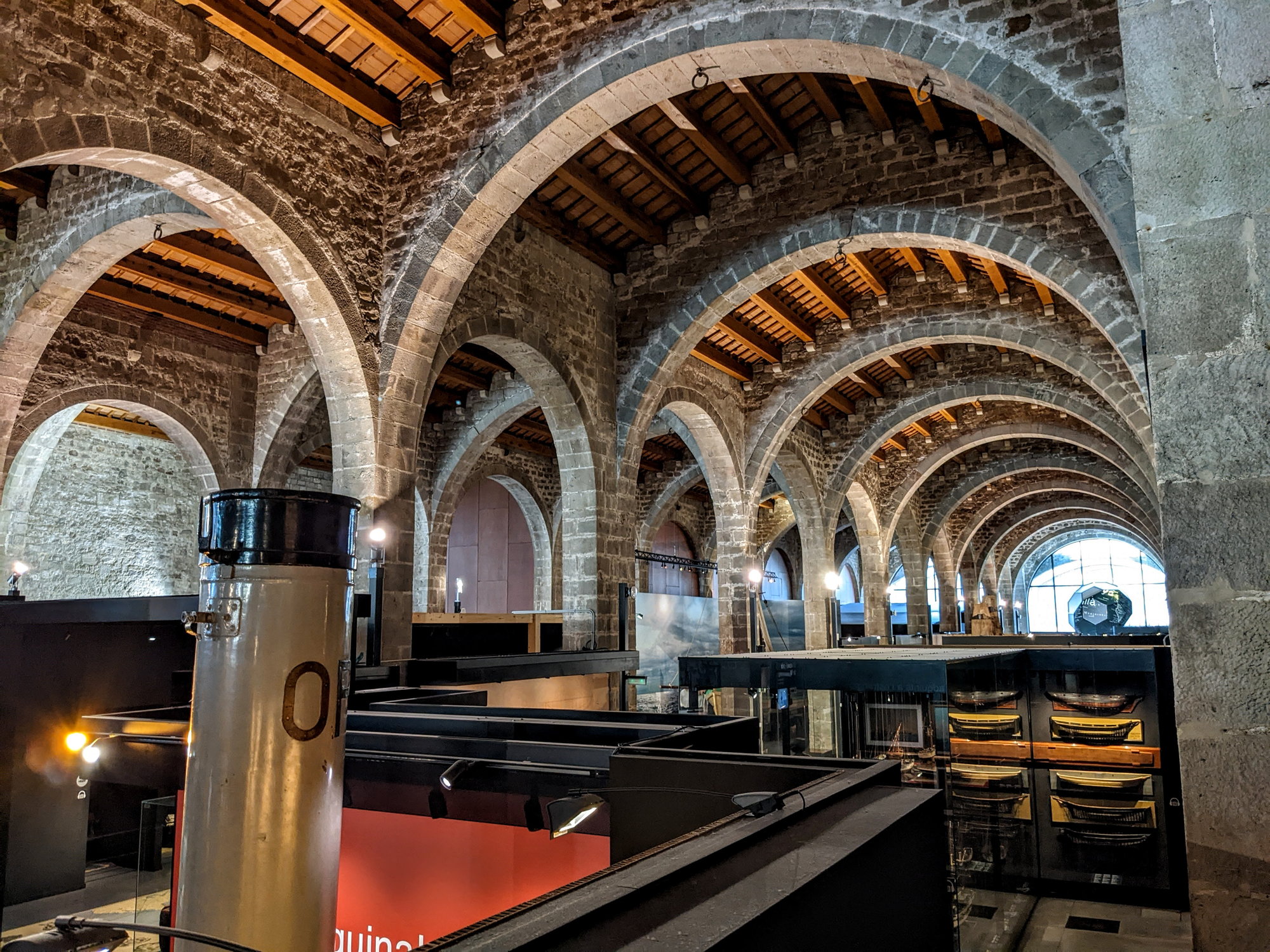
The interior of the Maritime Museum; there are about six of these huge bays, each one large enough to construct a big galley then tow it out to launch at the seafront.

This model gives some idea of the size of the shipyard.
The key attraction of the museum is a full-scale replica of the royal galley which led the Catholic ships of the Holy League fighting the Ottoman navy at the Battle of Lepanto, 1571. This was the “Real” commanded by John of Austria, the illegitimate son of Holy Roman Emperor Charles V.

The rear of the royal galley, Real, showing the elaborate poop. Note the size, look at the walkway for us tourists on the left of the hull.
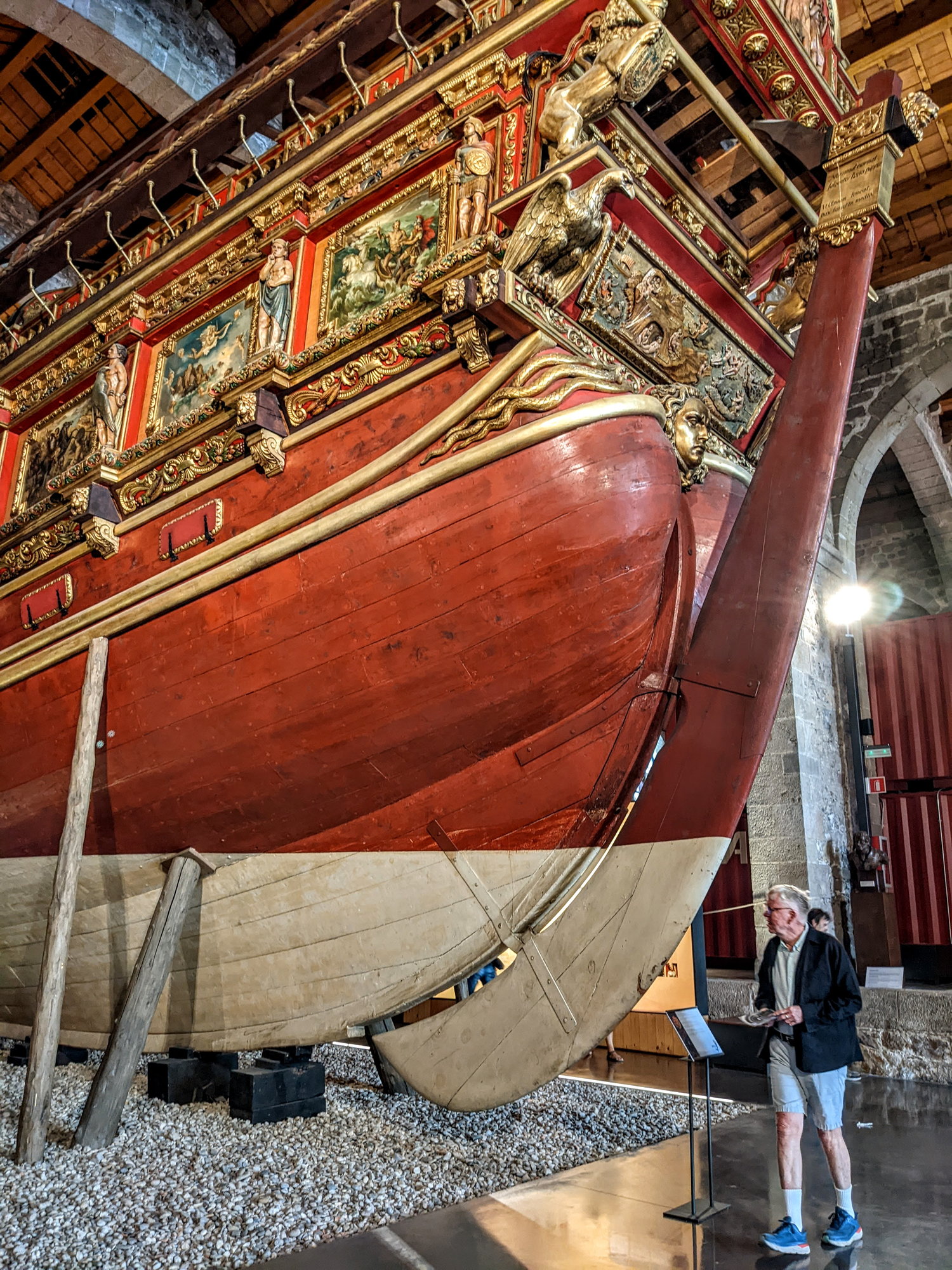
A view of the hull
This connection to the emperor explains the lavish decoration of the captain"s quarters and the poop deck. The museum signs say that the three lanterns symbolized the Trinity.
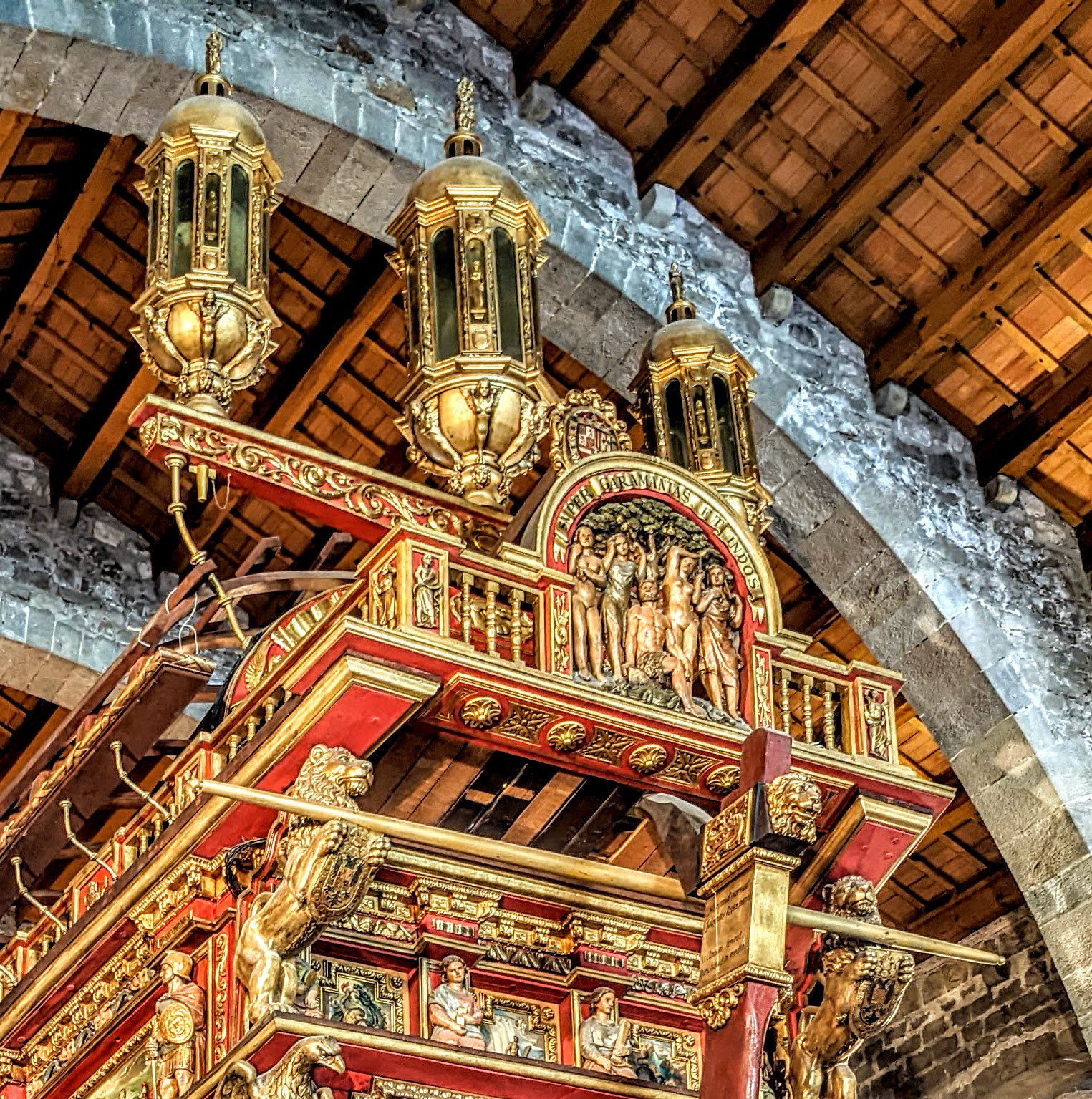
The three "Trinity" lanterns on the poop deck
The Real was 200 feet long. About 300 men rowed the ship.

Scale model of the Real. The blue banner represents the Holy League of Catholic states. The main sail was 60 feet high.
In addition to the 300 rowers, the Real carried 400 soldiers and sailors to the battle.
After filling our brains full of naval battles and miserable rowers and victorious Holy Leaguers, we walked back to our hotel, through a crowded Ramblas. It was a beautiful, bright Sunday mid-day. Our hotel, the REC hotel, was a stone's throw from the Arc de Triomf, which became my favorite Barcelona monument.
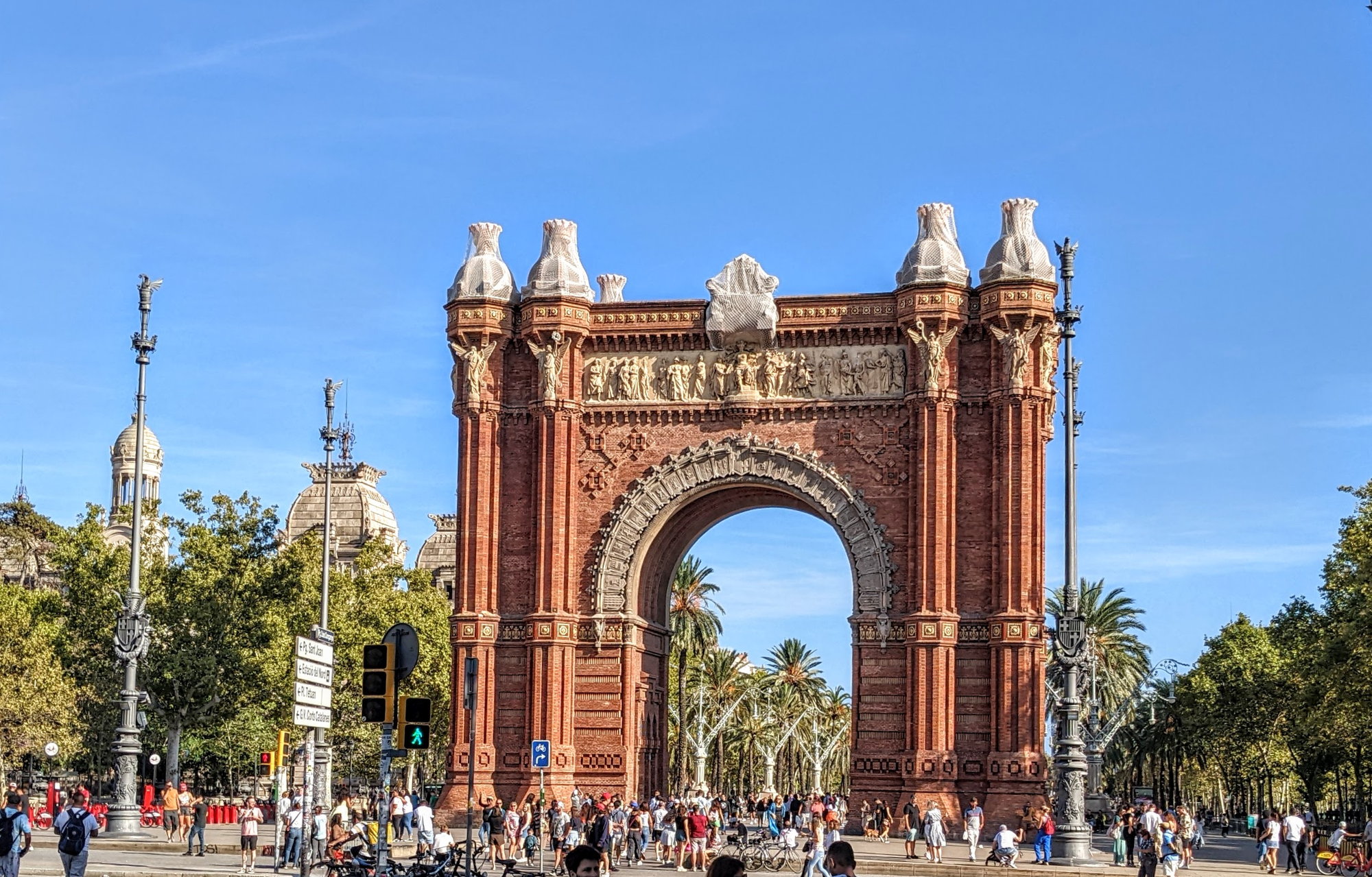
A beautiful Sunday afternoon in our neighborhood.
Next up: a Montjuic day and Barcelona's most beautiful building
This is an outstanding museum, housed in the centuries old building, as far back as the 1200s, in which the Catalan kingdom constructed galleys and other types of ships. The building is quite large. The Franco forces bombed it during the civil war, as well as the city's seaport facilities, so much of the structure has been rebuilt.

The interior of the Maritime Museum; there are about six of these huge bays, each one large enough to construct a big galley then tow it out to launch at the seafront.

This model gives some idea of the size of the shipyard.
The key attraction of the museum is a full-scale replica of the royal galley which led the Catholic ships of the Holy League fighting the Ottoman navy at the Battle of Lepanto, 1571. This was the “Real” commanded by John of Austria, the illegitimate son of Holy Roman Emperor Charles V.

The rear of the royal galley, Real, showing the elaborate poop. Note the size, look at the walkway for us tourists on the left of the hull.

A view of the hull
This connection to the emperor explains the lavish decoration of the captain"s quarters and the poop deck. The museum signs say that the three lanterns symbolized the Trinity.

The three "Trinity" lanterns on the poop deck
The Real was 200 feet long. About 300 men rowed the ship.

Scale model of the Real. The blue banner represents the Holy League of Catholic states. The main sail was 60 feet high.
In addition to the 300 rowers, the Real carried 400 soldiers and sailors to the battle.
After filling our brains full of naval battles and miserable rowers and victorious Holy Leaguers, we walked back to our hotel, through a crowded Ramblas. It was a beautiful, bright Sunday mid-day. Our hotel, the REC hotel, was a stone's throw from the Arc de Triomf, which became my favorite Barcelona monument.

A beautiful Sunday afternoon in our neighborhood.
Next up: a Montjuic day and Barcelona's most beautiful building
#5
Original Poster
Join Date: Aug 2013
Posts: 747
Likes: 0
Received 0 Likes
on
0 Posts
Montjuic
We set aside one day for a leisurely visit to the sights on Montjuic. We began with the Fundacion Miro museum, the highest point on the hill for us, then we planned to walk down the hill to the Museum of Catalan Art, down to the big fountain, and over to the Mies van der Rohe Pavillion.
The Miro museum was built in the 1970s, designed by Miro’s friend Josep Lluis Sert. The building feels inspired by the simple whitewashed structures of the Mediterranean coast. On a bright sunny day the sharp shapes stand out against a brilliant blue sky. Miro donated most of the paintings and sculptures to the museum.
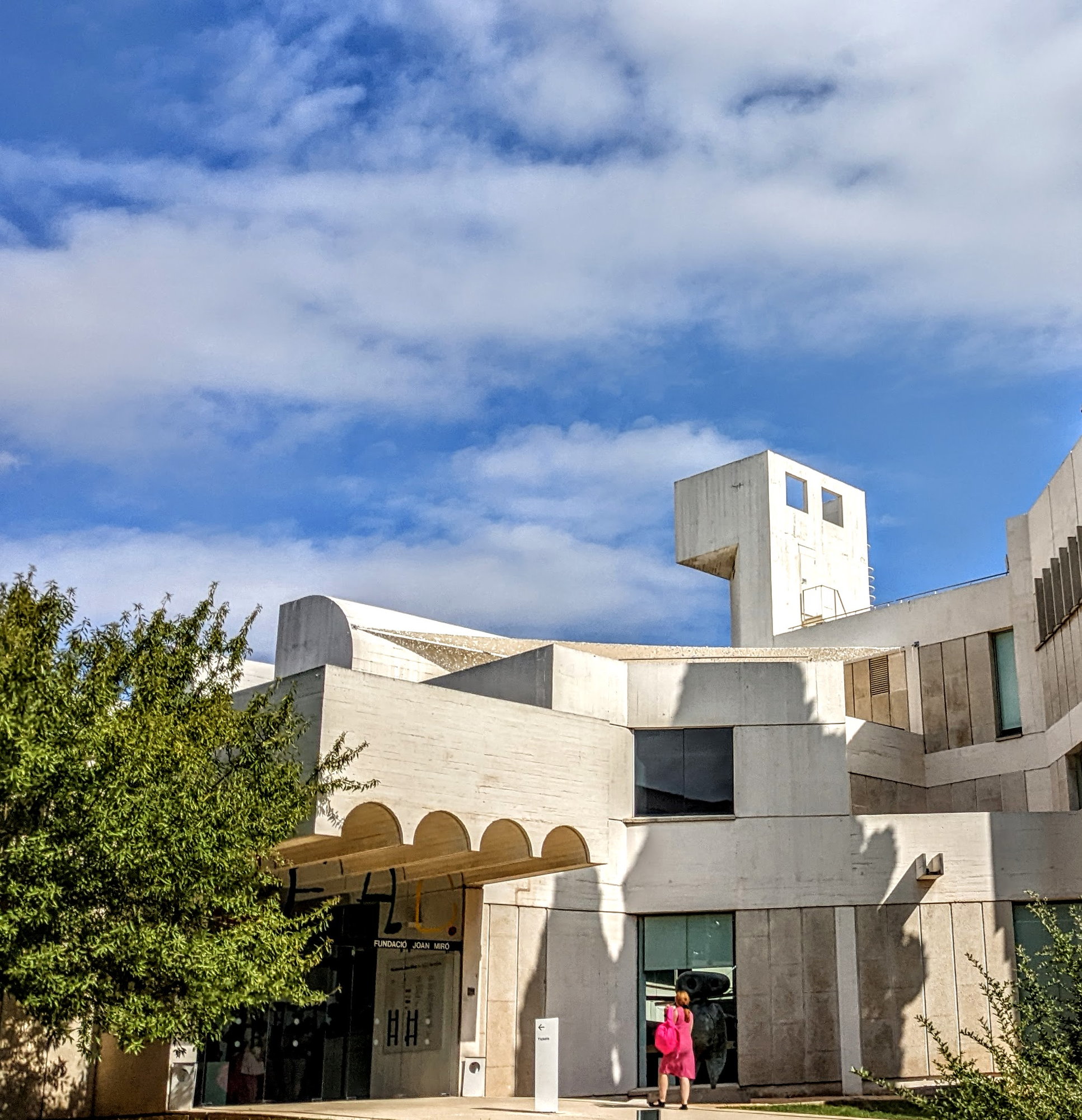
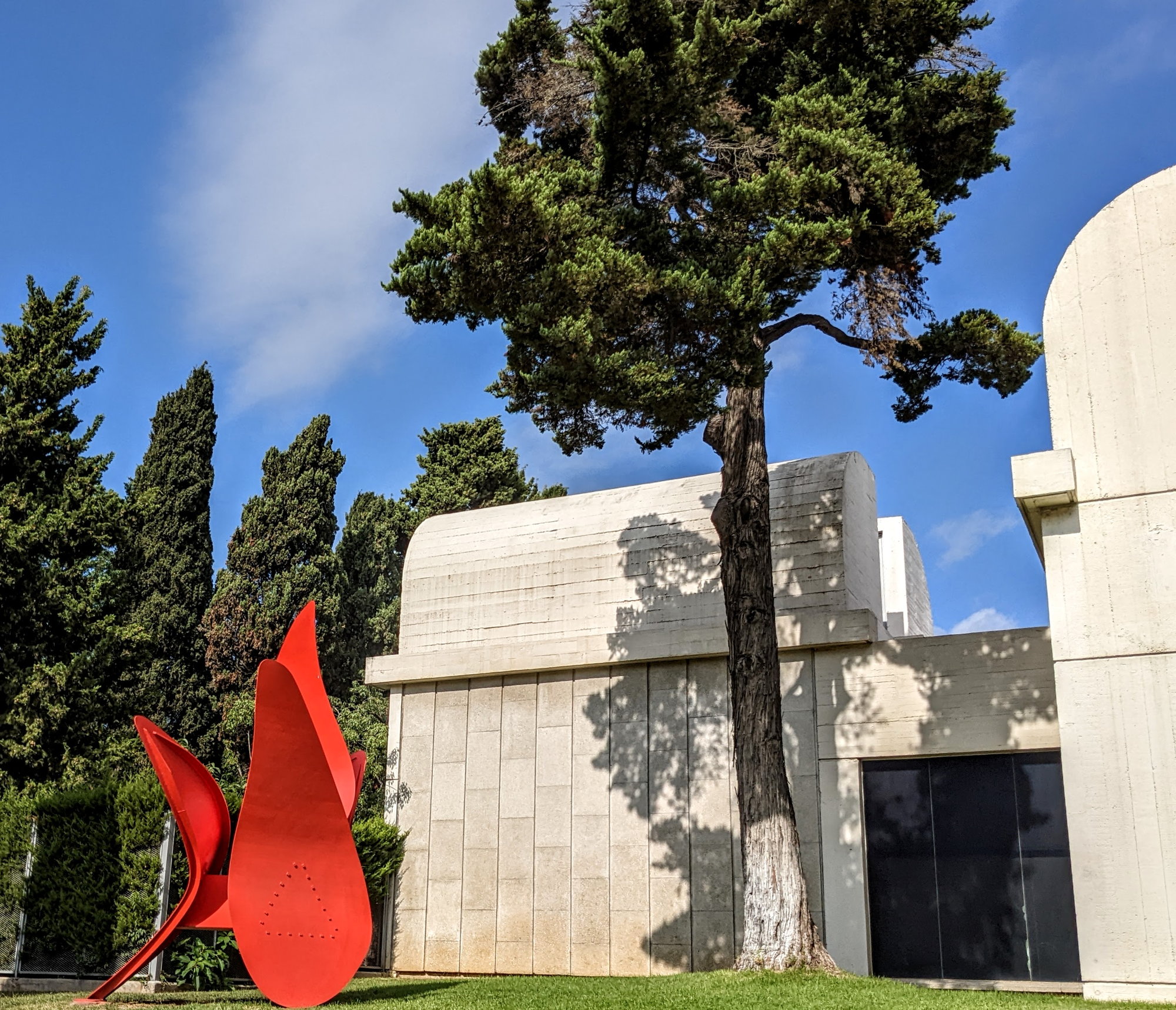
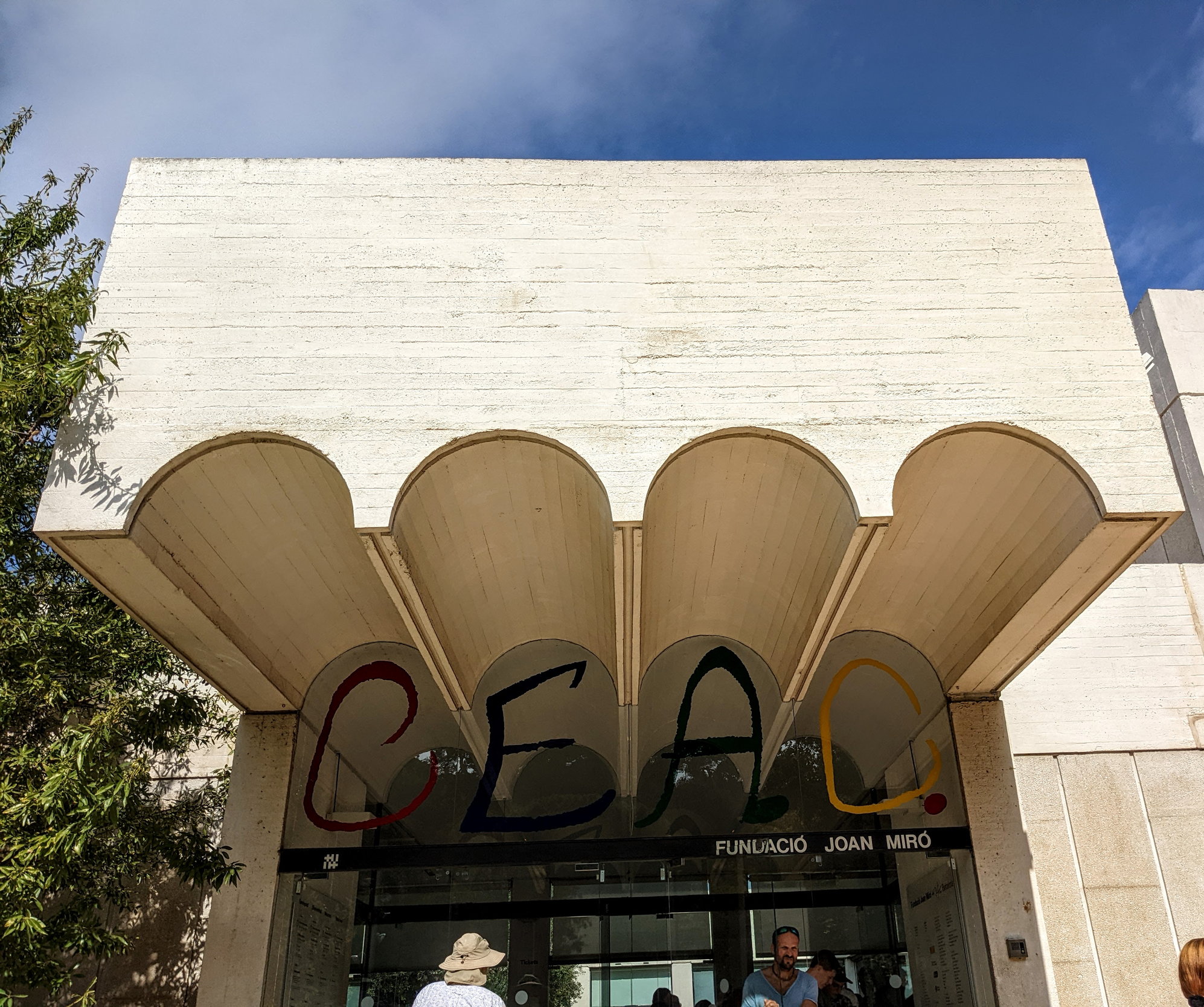
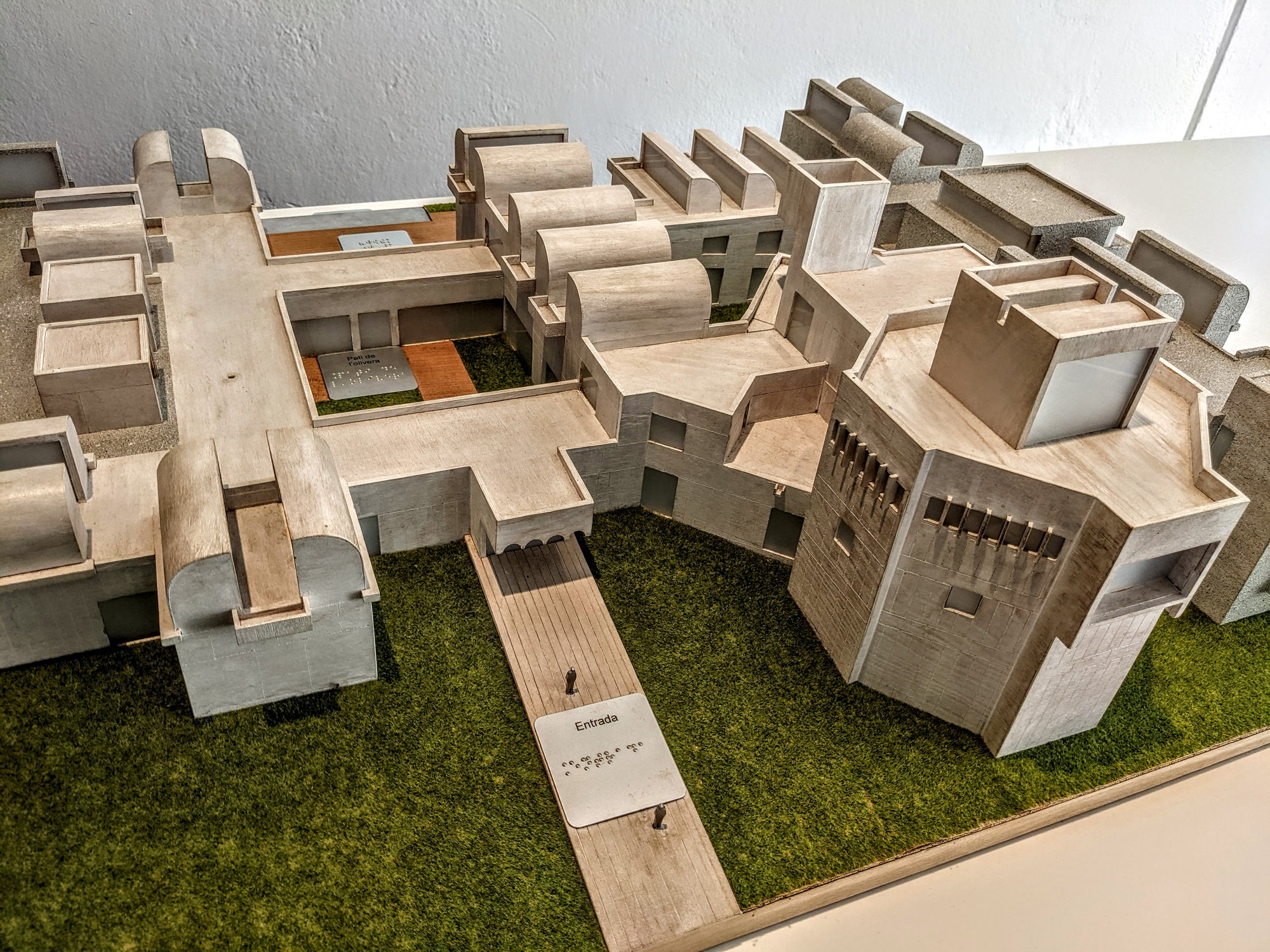
The size and complexity of the museum is not at first apparent from the entrance
Sert is not as well known as Gaudi but he was a major, influential architect. The Franco dictatorship banned him from professional work in Spain so Sert fled to the United States, where he had a distinguished career, becoming dean of the Harvard Graduate School of Design. Although his style seems diametrically opposite to that of Gaudi (who died when Sert was a young man), Sert was well acquainted with Gaudi's buildings and he coauthored a book on his life and work.
Miro's mature works show a childlike playfulness and Miro often uses vivid primary colors. Sometimes he used unconventional materials such as burlap, rope, and tarps. He also created poetic, whimsical titles for many paintings, my favorite title being "Hair Pursued by 2 Planets".

One of the many galleries in the Miro museum
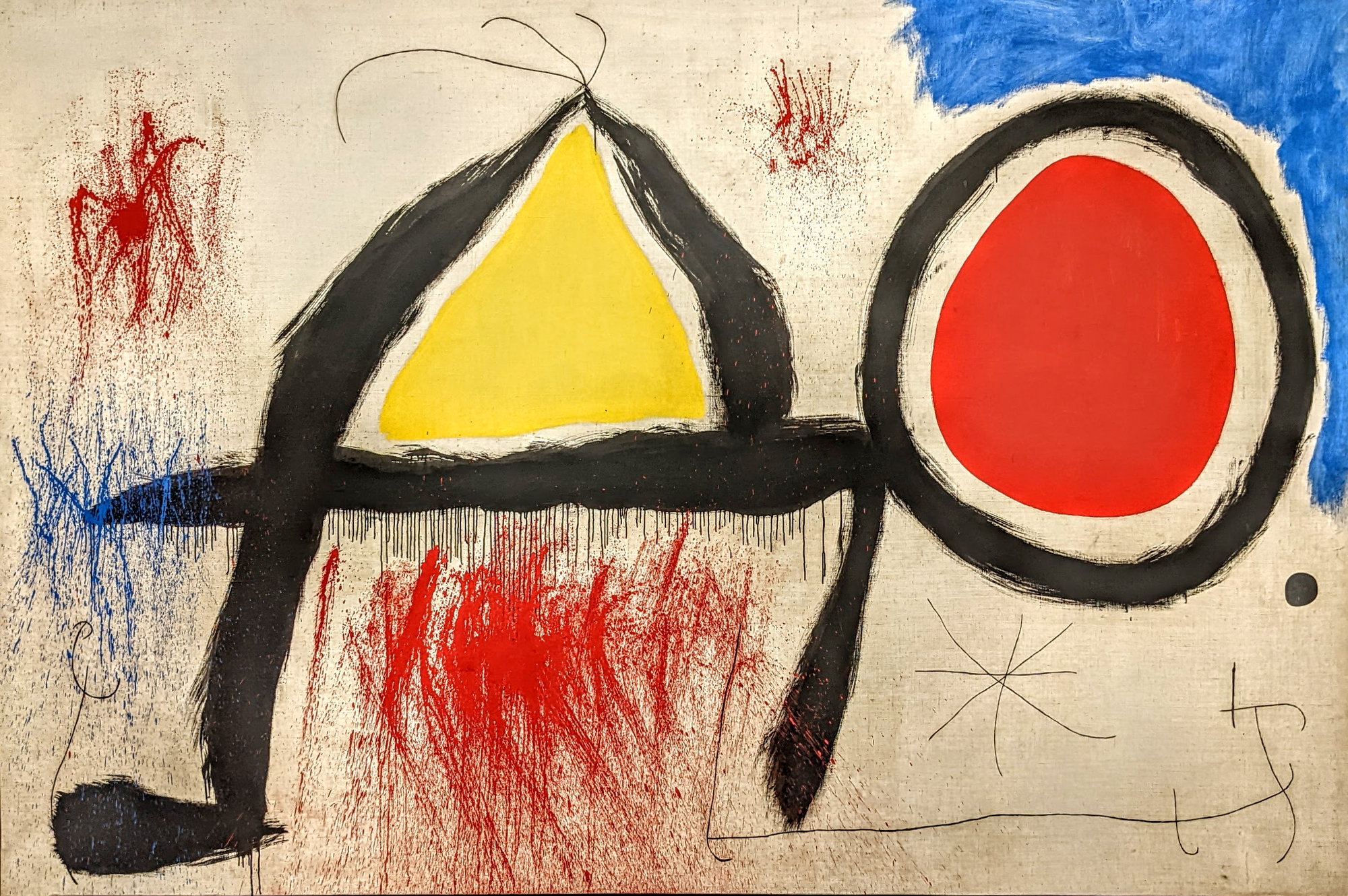
Miro, "Figure in Front of the Sun," 1968
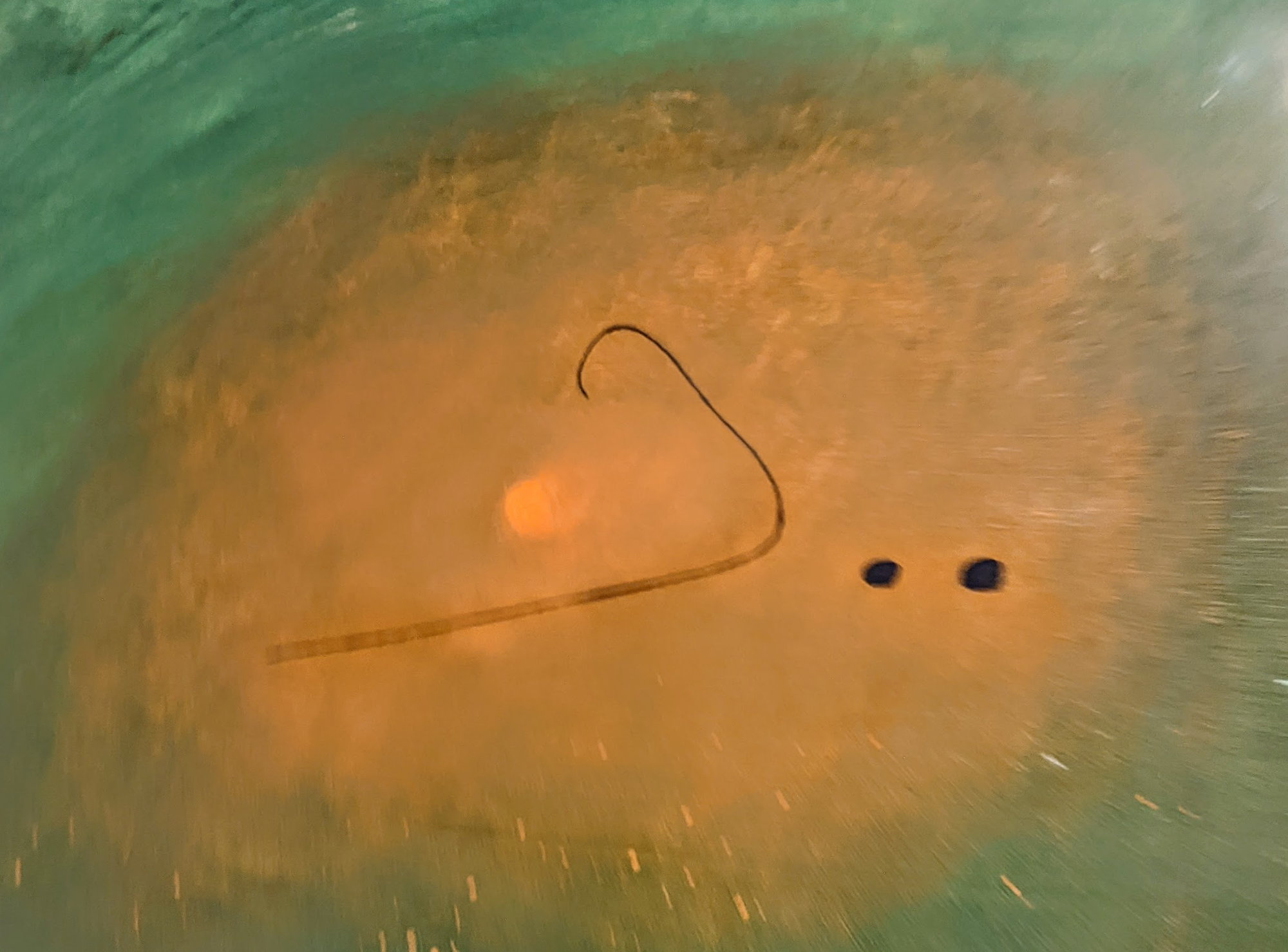
Miro, "Hair Pursued by 2 Planets," (detail) 1968
Miro also created striking sculptures incorporating bits of ordinary objects such as a faucet, realistic parts such as little birds, and semi-realistic human and animal shapes.
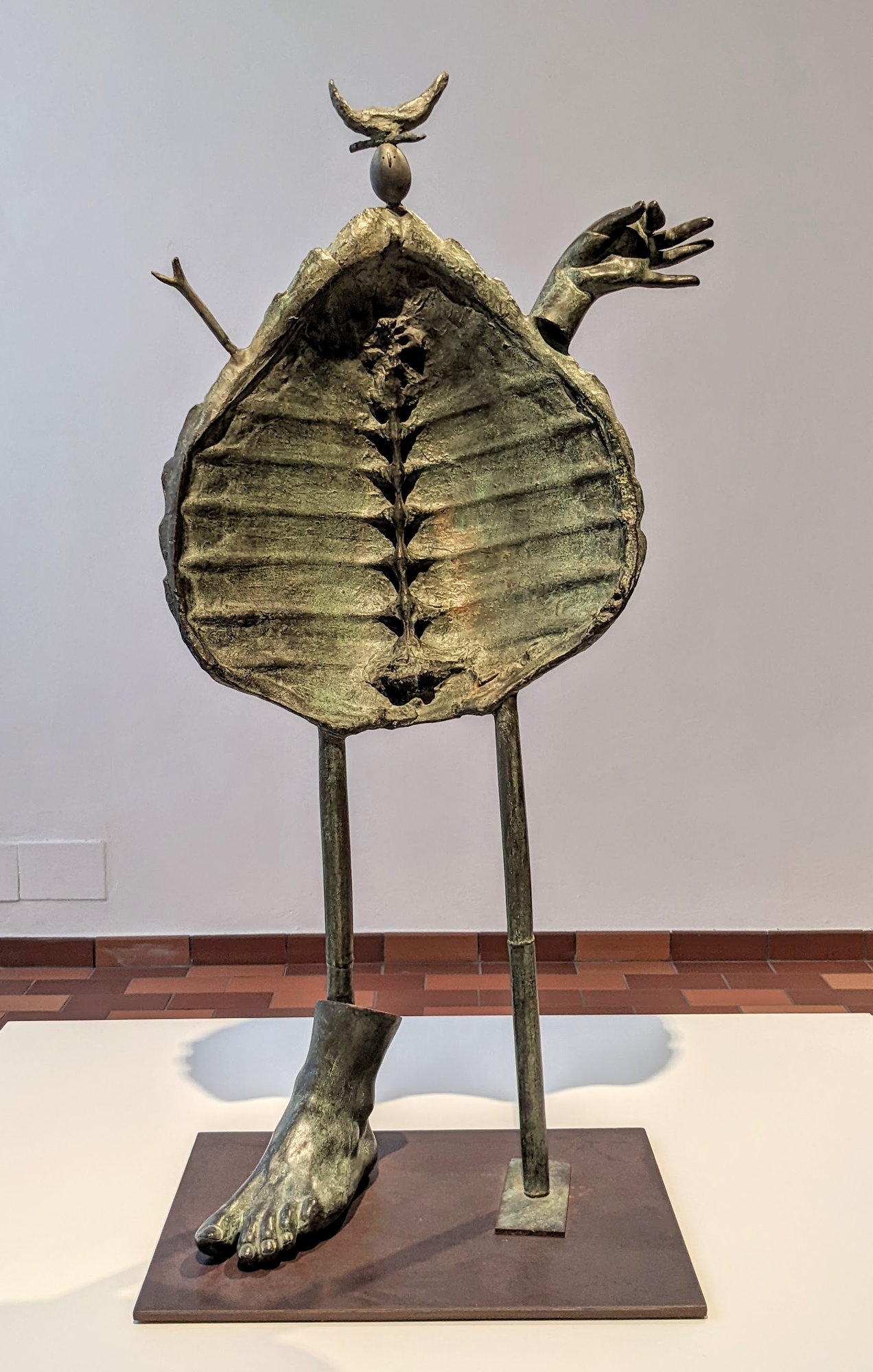
Miro, "Woman and Bird," 1969

Miro, "Pair of Lovers Playing with Almond Blossoms," 1975, the model for a larger sculpture to be placed in central Paris
After we left the museum we walked downhill through part of the Jardins de Laribal, large and lush gardens which were originally part of a private estate. We exited the gardens onto the Passeig de Santa Madrona and continued walking downhill to the National Museum of Catalan Art.
So...was the Miro museum my choice for the most beautiful building in Barcelona? Almost, but not quite. The winner is coming up shortly.
Next: the National Museum of Catalan Art
We set aside one day for a leisurely visit to the sights on Montjuic. We began with the Fundacion Miro museum, the highest point on the hill for us, then we planned to walk down the hill to the Museum of Catalan Art, down to the big fountain, and over to the Mies van der Rohe Pavillion.
The Miro museum was built in the 1970s, designed by Miro’s friend Josep Lluis Sert. The building feels inspired by the simple whitewashed structures of the Mediterranean coast. On a bright sunny day the sharp shapes stand out against a brilliant blue sky. Miro donated most of the paintings and sculptures to the museum.




The size and complexity of the museum is not at first apparent from the entrance
Sert is not as well known as Gaudi but he was a major, influential architect. The Franco dictatorship banned him from professional work in Spain so Sert fled to the United States, where he had a distinguished career, becoming dean of the Harvard Graduate School of Design. Although his style seems diametrically opposite to that of Gaudi (who died when Sert was a young man), Sert was well acquainted with Gaudi's buildings and he coauthored a book on his life and work.
Miro's mature works show a childlike playfulness and Miro often uses vivid primary colors. Sometimes he used unconventional materials such as burlap, rope, and tarps. He also created poetic, whimsical titles for many paintings, my favorite title being "Hair Pursued by 2 Planets".

One of the many galleries in the Miro museum

Miro, "Figure in Front of the Sun," 1968

Miro, "Hair Pursued by 2 Planets," (detail) 1968
Miro also created striking sculptures incorporating bits of ordinary objects such as a faucet, realistic parts such as little birds, and semi-realistic human and animal shapes.

Miro, "Woman and Bird," 1969

Miro, "Pair of Lovers Playing with Almond Blossoms," 1975, the model for a larger sculpture to be placed in central Paris
After we left the museum we walked downhill through part of the Jardins de Laribal, large and lush gardens which were originally part of a private estate. We exited the gardens onto the Passeig de Santa Madrona and continued walking downhill to the National Museum of Catalan Art.
So...was the Miro museum my choice for the most beautiful building in Barcelona? Almost, but not quite. The winner is coming up shortly.
Next: the National Museum of Catalan Art
#7
Original Poster
Join Date: Aug 2013
Posts: 747
Likes: 0
Received 0 Likes
on
0 Posts
The National Museum of Catalan Art
We arrived at the Museum of Catalan Art about 1:00 pm after our walk downhill from the Miro museum. We had lunch in the museum café with friends who were traveling around France and Spain. Then we started exploring this very big and impressive museum. Most of our attention was focused on the Romanesque frescoes.
Some background: The small towns and villages in northern Catalonia had churches and villages with beautiful Romanesque frescoes, many dating back to the 12th century. In the 1920s, authorities in Barcelona and elsewhere who were charged with historical preservation woke up to an alarm bell: the Boston Museum of Fine Arts had just bought from the church of Santa Maria de Mur in Lerida a magnificent fresco, a representation of Christ in Majesty with the four evangelists. Catalan authorities feared that they would soon see the sale of many of these church frescoes. They quickly organized to begin removing the frescoes from the rural churches, replacing them with copies.
The museum has arguably the greatest collection of Romanesque frescoes in Europe. The frescoes were placed on reproductions of the apse or the columns so that they appear “at home”—even though much damage is apparent and many parts of these frescoes are missing, the presentation is nevertheless very impressive.
The photos below show frescoes and statues from two churches in the town of Taull, Sant Climent and Santa Maria de Mur. Taull was prosperous in the early middle ages and used its resources to build these two fine churches. The entire valley around Taull has several excellent examples of Romanesque architecture and frescoes. The valley has been declared a UNESCO World Heritage Site.
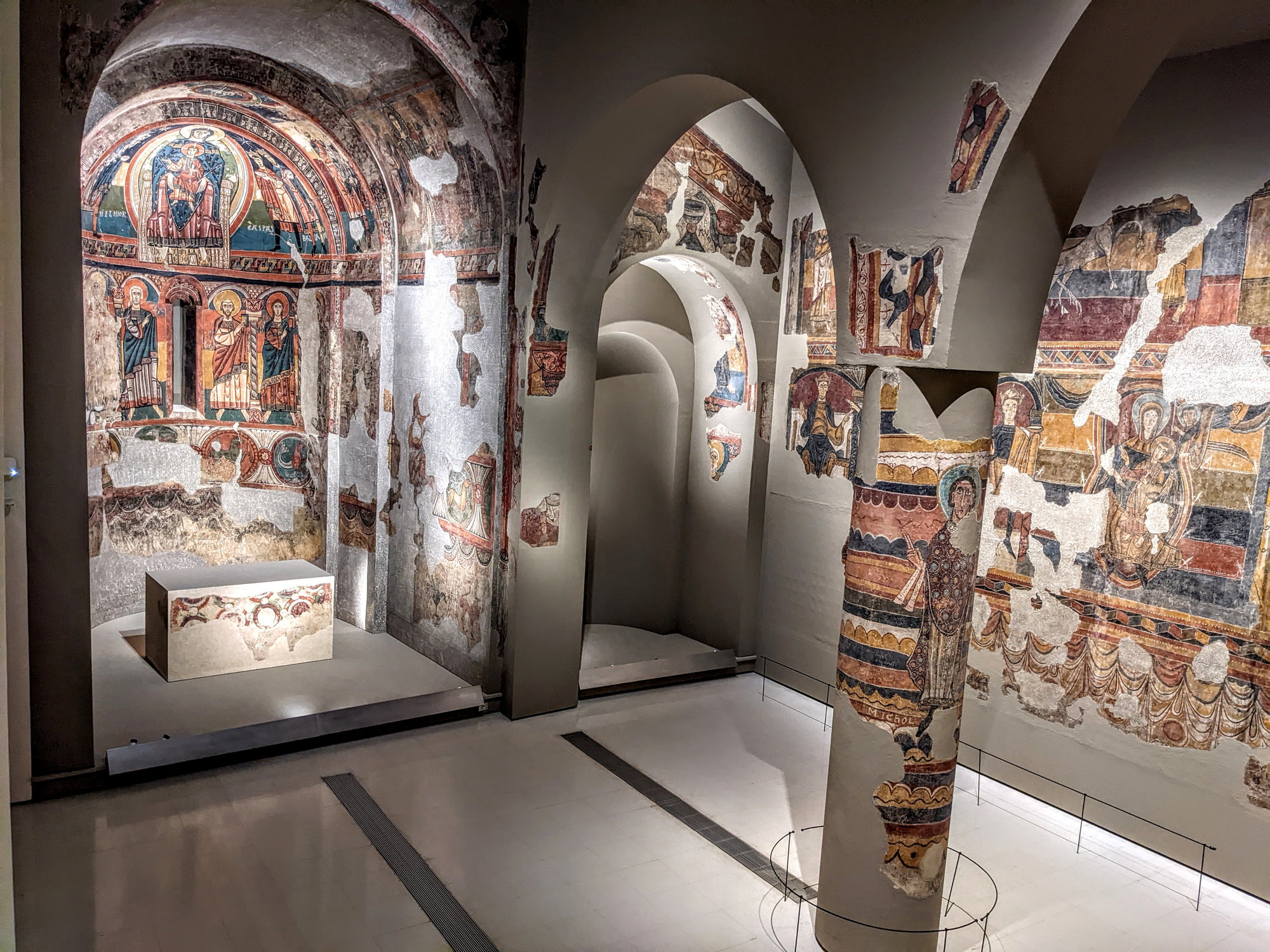
Frescoes from the church of Santa Climent de Taull, ca. 1123
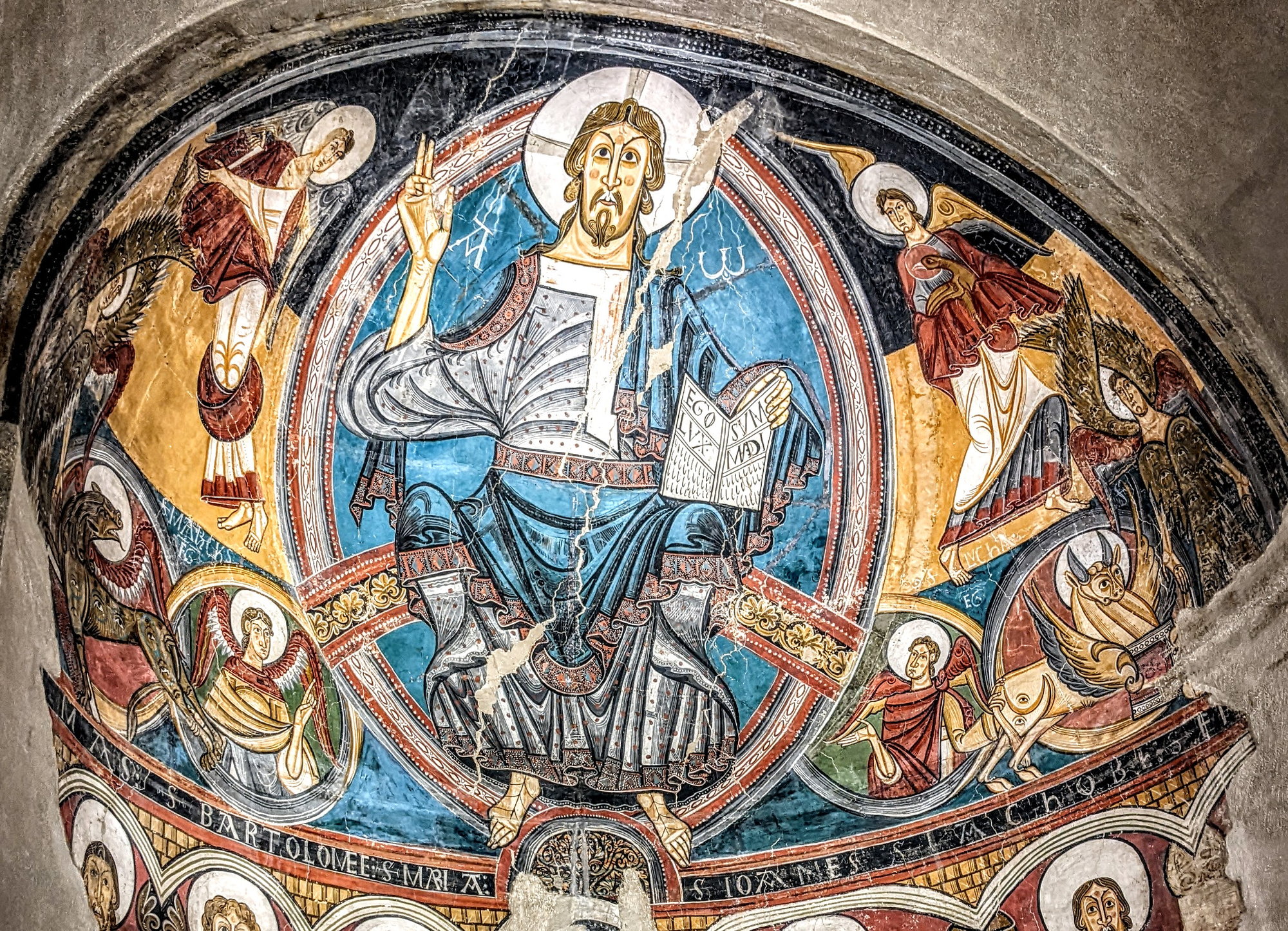
Christ in Majesty, detail of the fresco over the main altar, from the church of Sant Climent de Taull
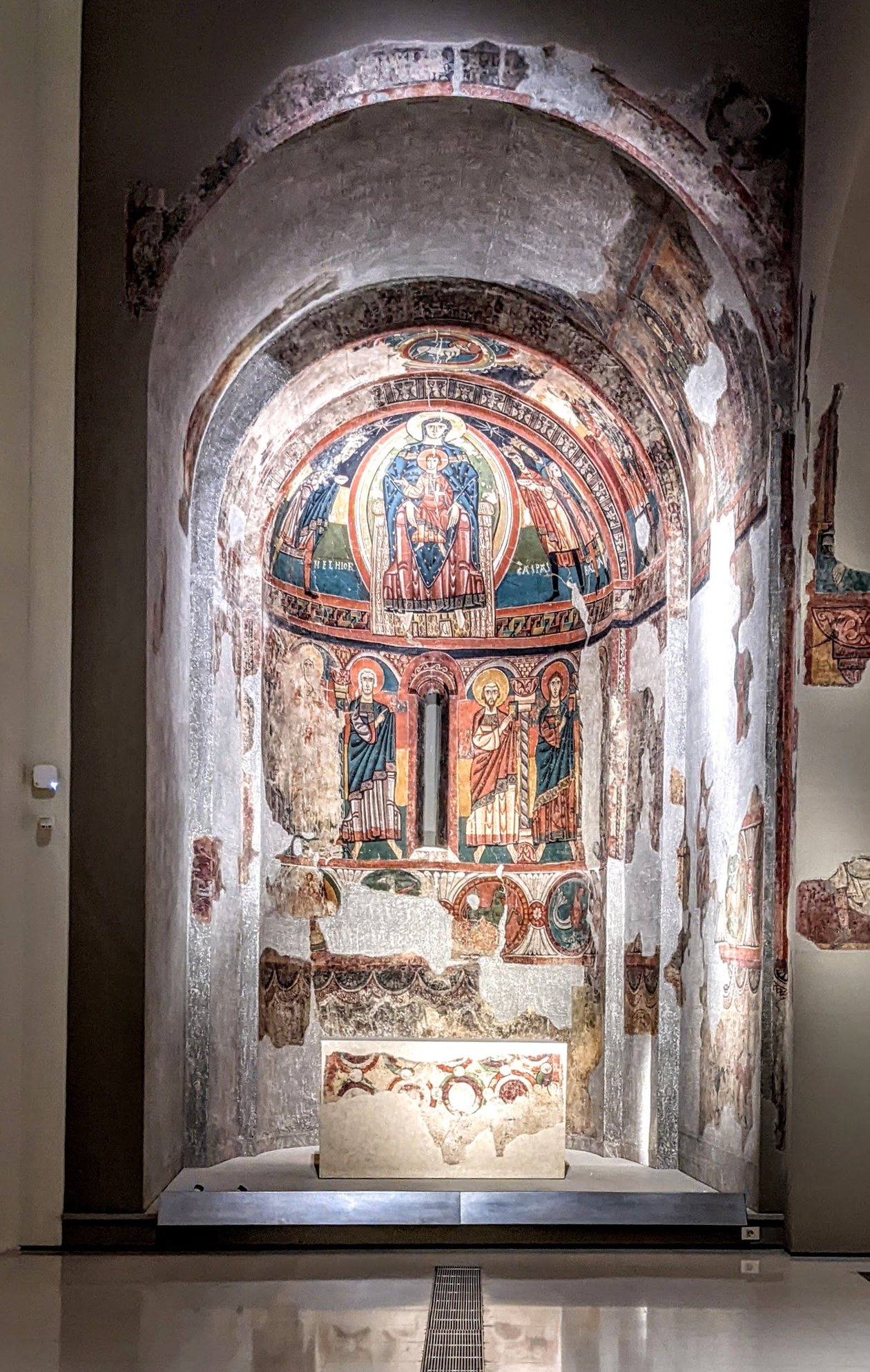
Fresco from Santa Maria de Taull, representing the Epiphany
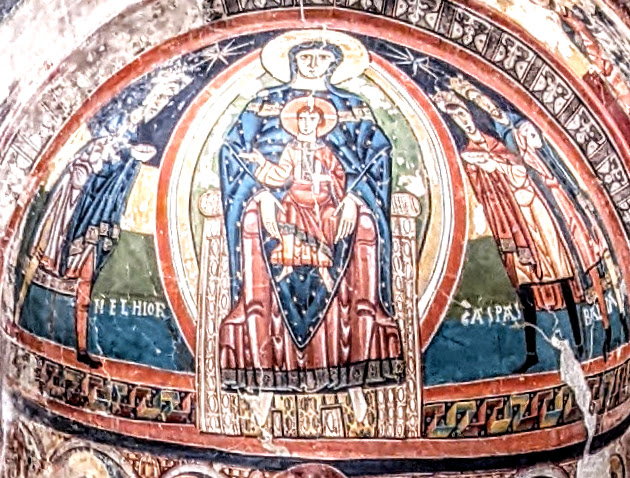
The Epiphany, detail from apse fresco of Santa Maria de Taull; the three Magi come to visit the Baby Jesus, who is presented here as divine
As we were admiring these frescoes we started wondering "how in the world do you remove a fresco?" The answer: very carefully. The museum shows a video of the process: the fresco is cleaned; a kind of special glob is spread over the fresco; a special kind of cloth is then applied and it dries; the cloth is peeled off and the fresco comes with it; then the cloth is applied to a new foundation material and peeled away (why does it come loose, one wonders). Anyway, it works. It's surprising that the special kind of chemicals and materials were available in the 1920s to carry out this process.
The museum also has several baldachins, which were placed over the main altar.

Baldachin, paint on wood, showing Christ in Majesty, from the church of Sant Serni de Tavernoles in the Valira Valley, ca. 13th century
Several statues from these rural churches were preserved and moved to the museum. Below is a group of figures depicting the Descent from the Cross (several of the original figures are missing). This depiction of the Descent is notable because it shows, or showed, the two thieves crucified along with Jesus. Only the figure of Dismas, the repentant thief, has survived. The group also includes Mary and Joseph of Arimathea, who is taking Jesus down from the cross.
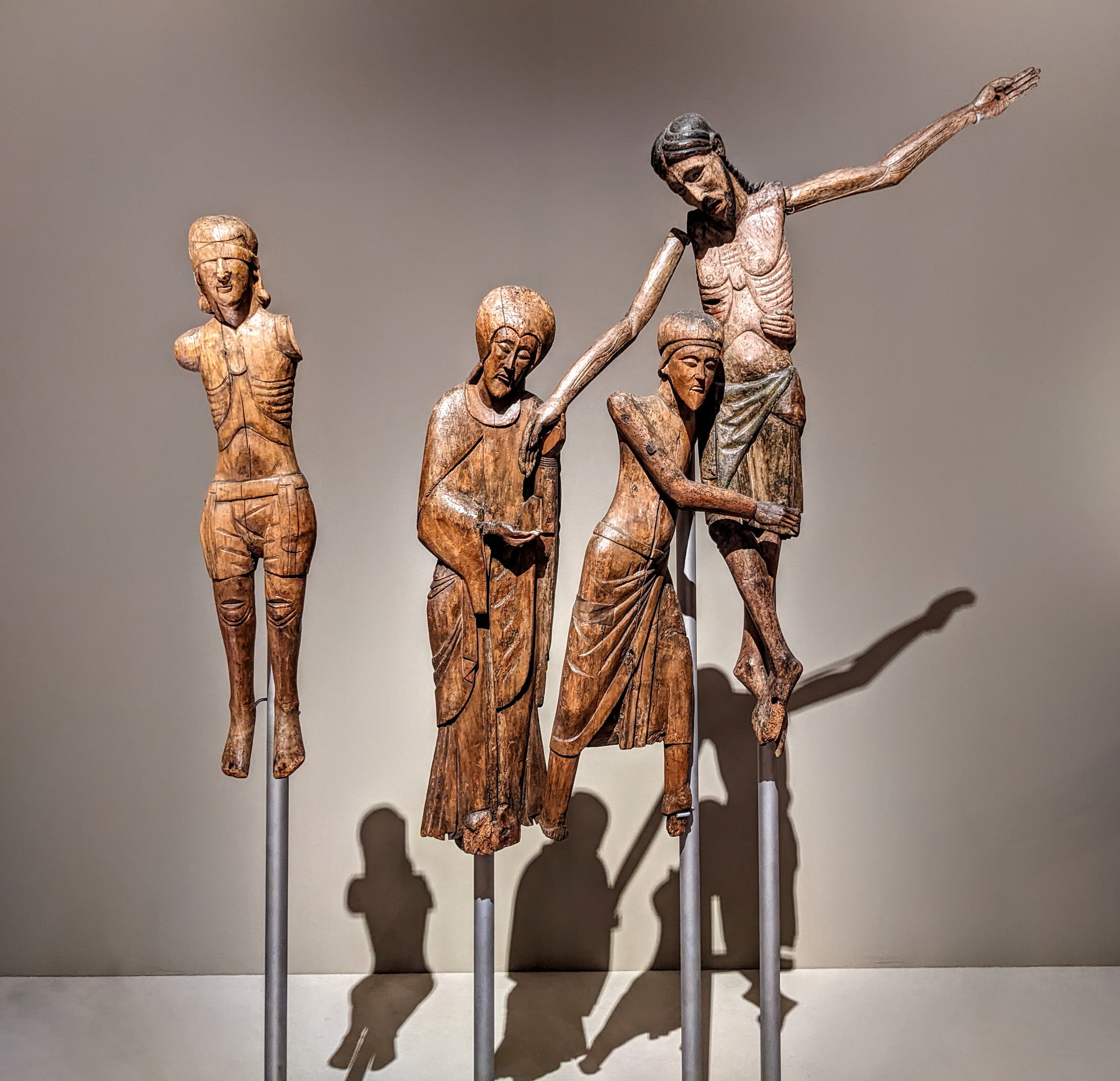
Descent from the Cross, from Santa Maria de Taull
Some of the statues have an abstract, almost modern feeling...
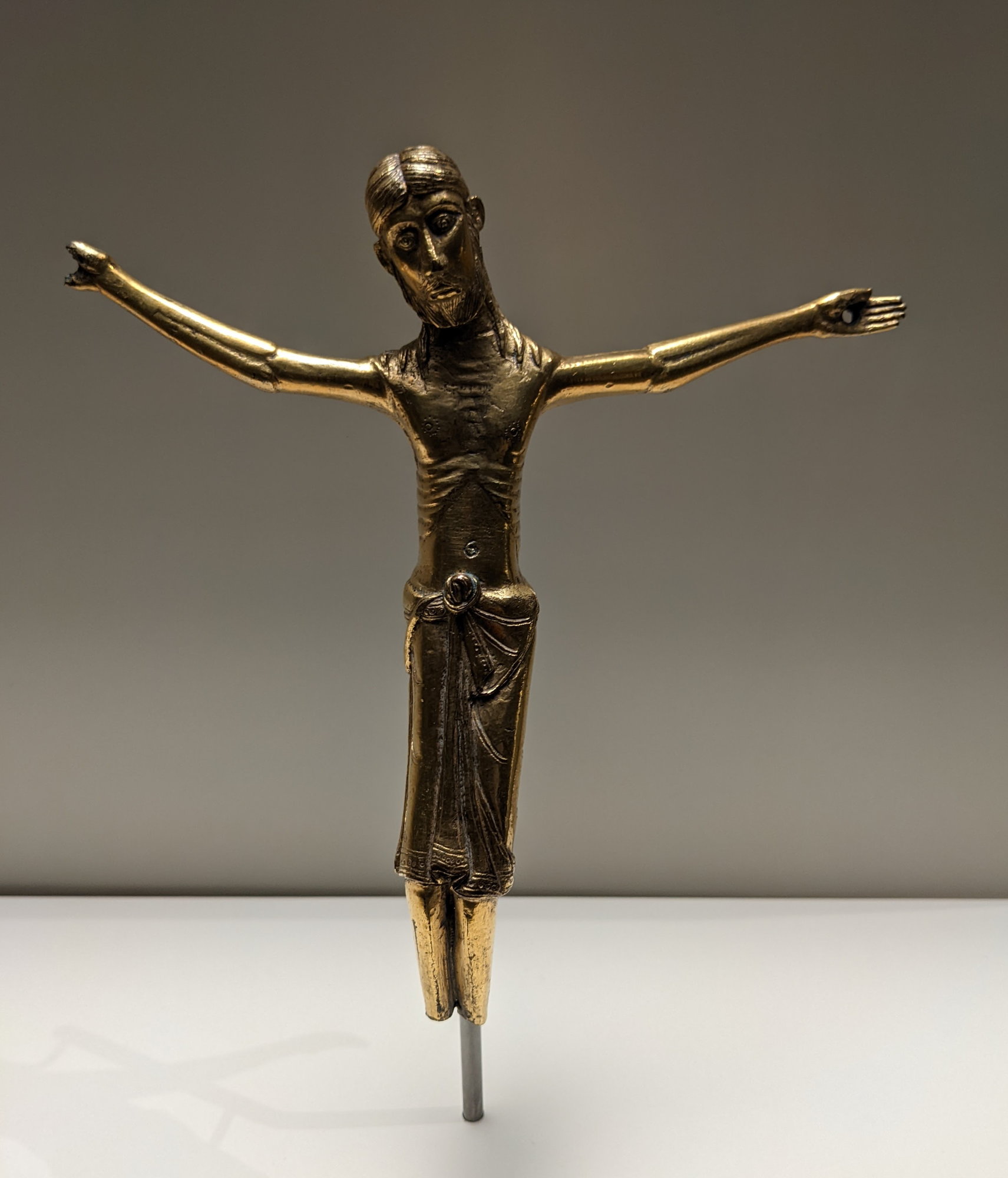
Christ, bronze, ca. 1180, from the church of Sant Miquel de Moror in the village of Sant Esteve de la Sarga
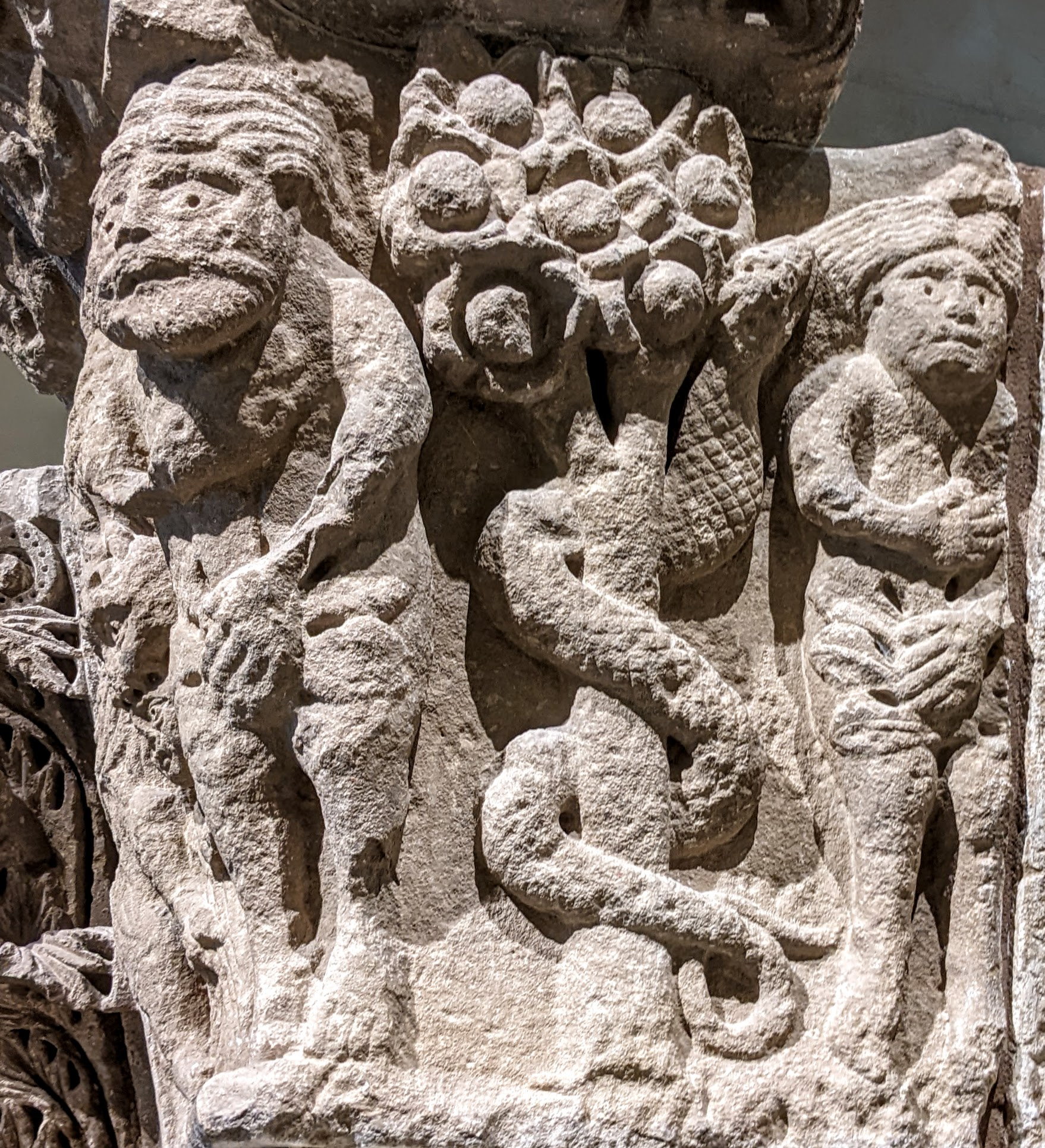
Adam and Eve and the serpent, from the cloister of the monastery of Sant Pere de les Puelles, Barcelona, 12th century
The museum also has magnificent gilded and painted altarpieces.
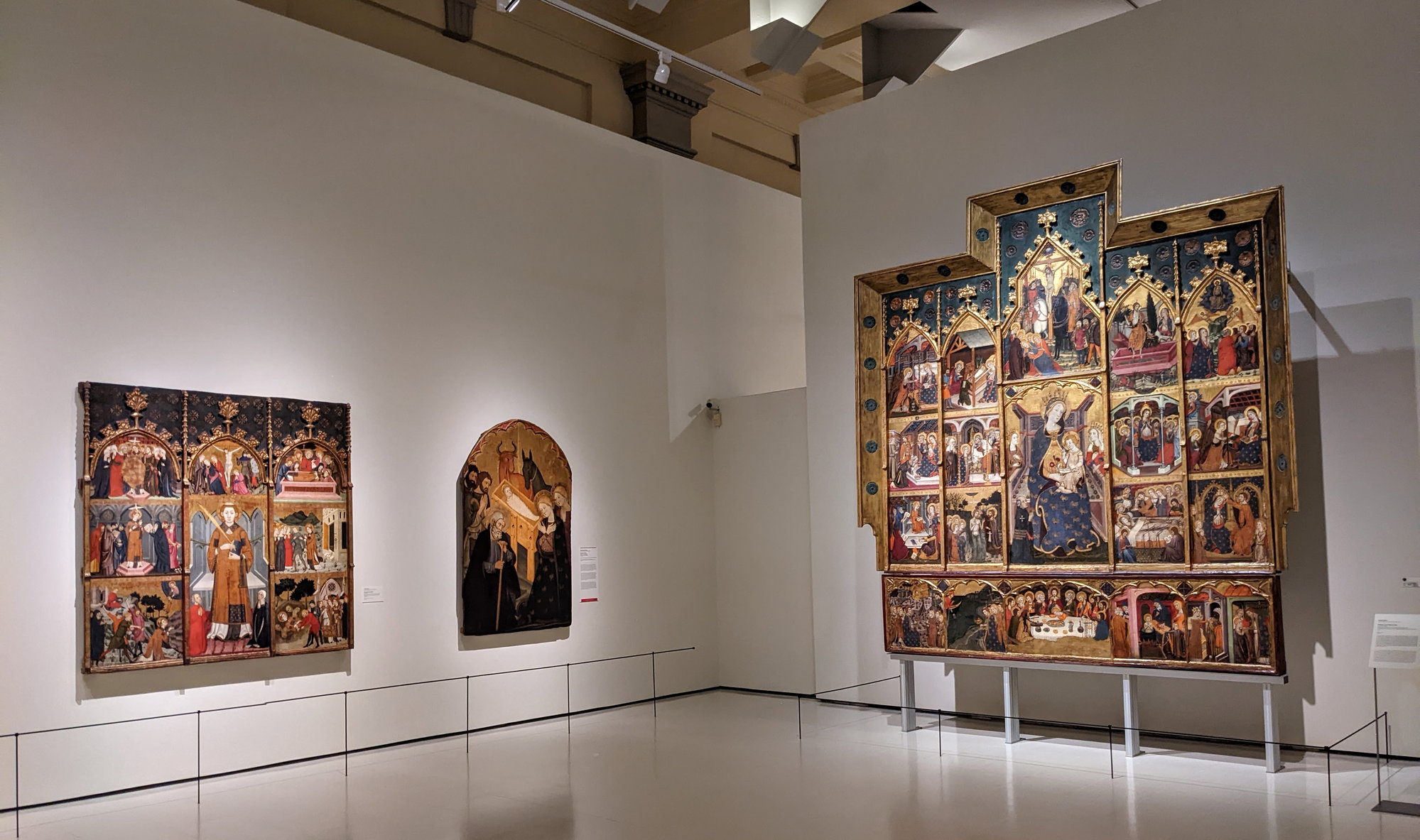
Altarpieces and paintings, 14th cent.
I love this painting, below, of the Adoration of the Shepherds, with the cow and donkey.

Adoration of the Shepherds, 14th cent.
Next: the most beautiful building in Barcelona
We arrived at the Museum of Catalan Art about 1:00 pm after our walk downhill from the Miro museum. We had lunch in the museum café with friends who were traveling around France and Spain. Then we started exploring this very big and impressive museum. Most of our attention was focused on the Romanesque frescoes.
Some background: The small towns and villages in northern Catalonia had churches and villages with beautiful Romanesque frescoes, many dating back to the 12th century. In the 1920s, authorities in Barcelona and elsewhere who were charged with historical preservation woke up to an alarm bell: the Boston Museum of Fine Arts had just bought from the church of Santa Maria de Mur in Lerida a magnificent fresco, a representation of Christ in Majesty with the four evangelists. Catalan authorities feared that they would soon see the sale of many of these church frescoes. They quickly organized to begin removing the frescoes from the rural churches, replacing them with copies.
The museum has arguably the greatest collection of Romanesque frescoes in Europe. The frescoes were placed on reproductions of the apse or the columns so that they appear “at home”—even though much damage is apparent and many parts of these frescoes are missing, the presentation is nevertheless very impressive.
The photos below show frescoes and statues from two churches in the town of Taull, Sant Climent and Santa Maria de Mur. Taull was prosperous in the early middle ages and used its resources to build these two fine churches. The entire valley around Taull has several excellent examples of Romanesque architecture and frescoes. The valley has been declared a UNESCO World Heritage Site.

Frescoes from the church of Santa Climent de Taull, ca. 1123

Christ in Majesty, detail of the fresco over the main altar, from the church of Sant Climent de Taull

Fresco from Santa Maria de Taull, representing the Epiphany

The Epiphany, detail from apse fresco of Santa Maria de Taull; the three Magi come to visit the Baby Jesus, who is presented here as divine
As we were admiring these frescoes we started wondering "how in the world do you remove a fresco?" The answer: very carefully. The museum shows a video of the process: the fresco is cleaned; a kind of special glob is spread over the fresco; a special kind of cloth is then applied and it dries; the cloth is peeled off and the fresco comes with it; then the cloth is applied to a new foundation material and peeled away (why does it come loose, one wonders). Anyway, it works. It's surprising that the special kind of chemicals and materials were available in the 1920s to carry out this process.
The museum also has several baldachins, which were placed over the main altar.

Baldachin, paint on wood, showing Christ in Majesty, from the church of Sant Serni de Tavernoles in the Valira Valley, ca. 13th century
Several statues from these rural churches were preserved and moved to the museum. Below is a group of figures depicting the Descent from the Cross (several of the original figures are missing). This depiction of the Descent is notable because it shows, or showed, the two thieves crucified along with Jesus. Only the figure of Dismas, the repentant thief, has survived. The group also includes Mary and Joseph of Arimathea, who is taking Jesus down from the cross.

Descent from the Cross, from Santa Maria de Taull
Some of the statues have an abstract, almost modern feeling...

Christ, bronze, ca. 1180, from the church of Sant Miquel de Moror in the village of Sant Esteve de la Sarga

Adam and Eve and the serpent, from the cloister of the monastery of Sant Pere de les Puelles, Barcelona, 12th century
The museum also has magnificent gilded and painted altarpieces.

Altarpieces and paintings, 14th cent.
I love this painting, below, of the Adoration of the Shepherds, with the cow and donkey.

Adoration of the Shepherds, 14th cent.
Next: the most beautiful building in Barcelona
#8
Original Poster
Join Date: Aug 2013
Posts: 747
Likes: 0
Received 0 Likes
on
0 Posts
Leaving the museum, we admired the view of the city from the top of the long stairway, then walked down slowly, looking back at this big razzmatazz building. Sort of over the top, but why not.
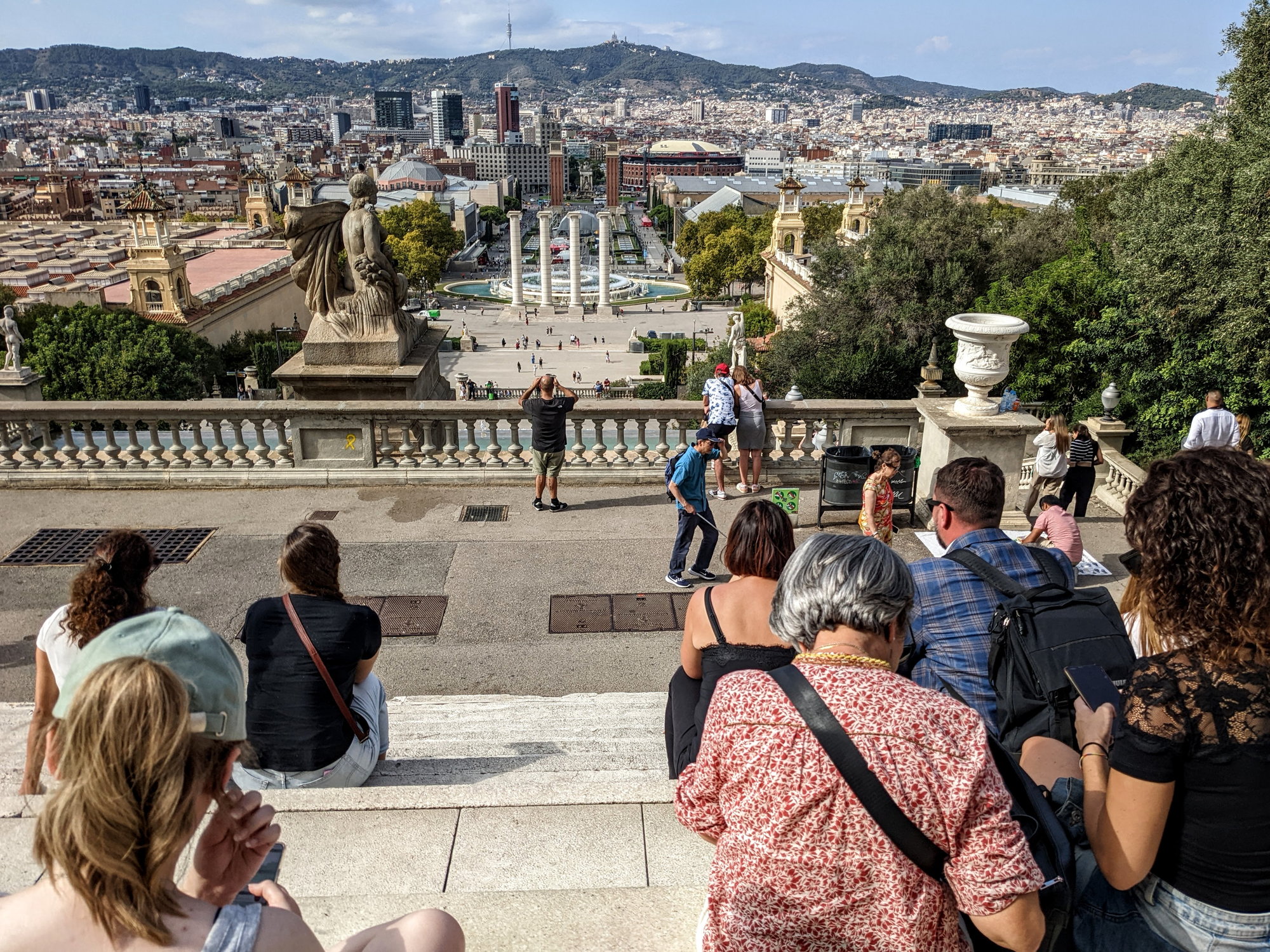
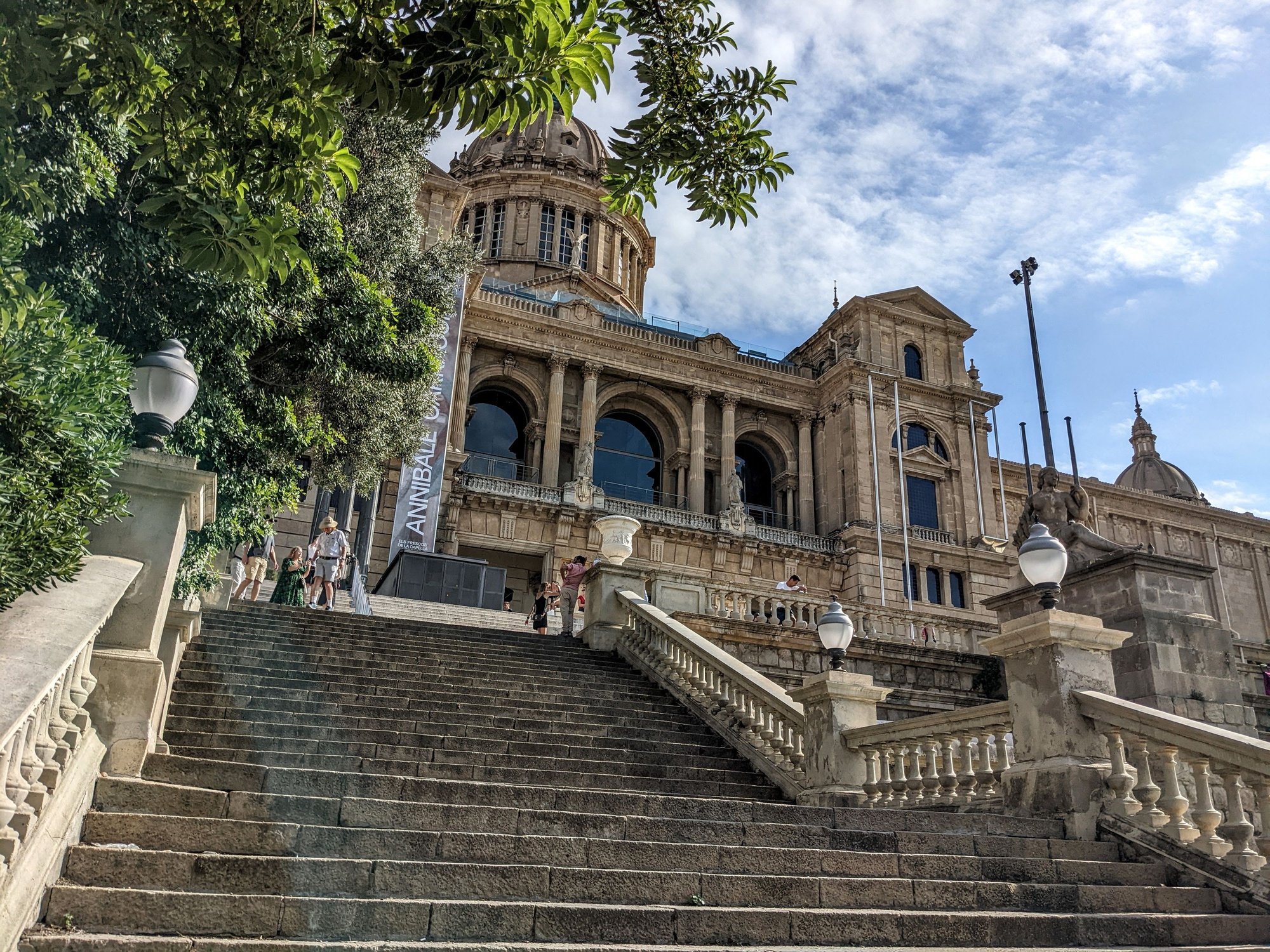

This was the central building for the 1929 world's fair. The city decided not to dismantle the thing afterwards. Most of the pavillions were dismantled, however, which seems to be the usual practice with world's fairs. One important building, however, was rebuilt 50 years after it was dismantled, and this building wins the prize as The Most Beautiful Building in Barcelona, the Mies van der Rohe Pavillion.
At the foot of the immense stairway we turned left and walked to the Mies van der Rohe Pavillion, which was the national pavillion of Germany at the 1929 fair. The pavillion is set back and seems a quiet statement after the big, ornate central fair building which is today the Catalan art museum.

The German government chose Ludwig Mies van der Rohe, a member of the Bauhaus school, to design the pavillion. The work was accomplished quickly: Mies received the contract barely one year before the target date for opening the pavillion in 1929. The building rests on a low platform. Its flat roof is supported by eight chrome-covered columns--the walls themselves are not load-bearing. The function of the walls is simply to carve out space. And one feels, when walking through the building, the one is moving from one airy space to another--hard to describe but definitely different from a conventionally designed structure.
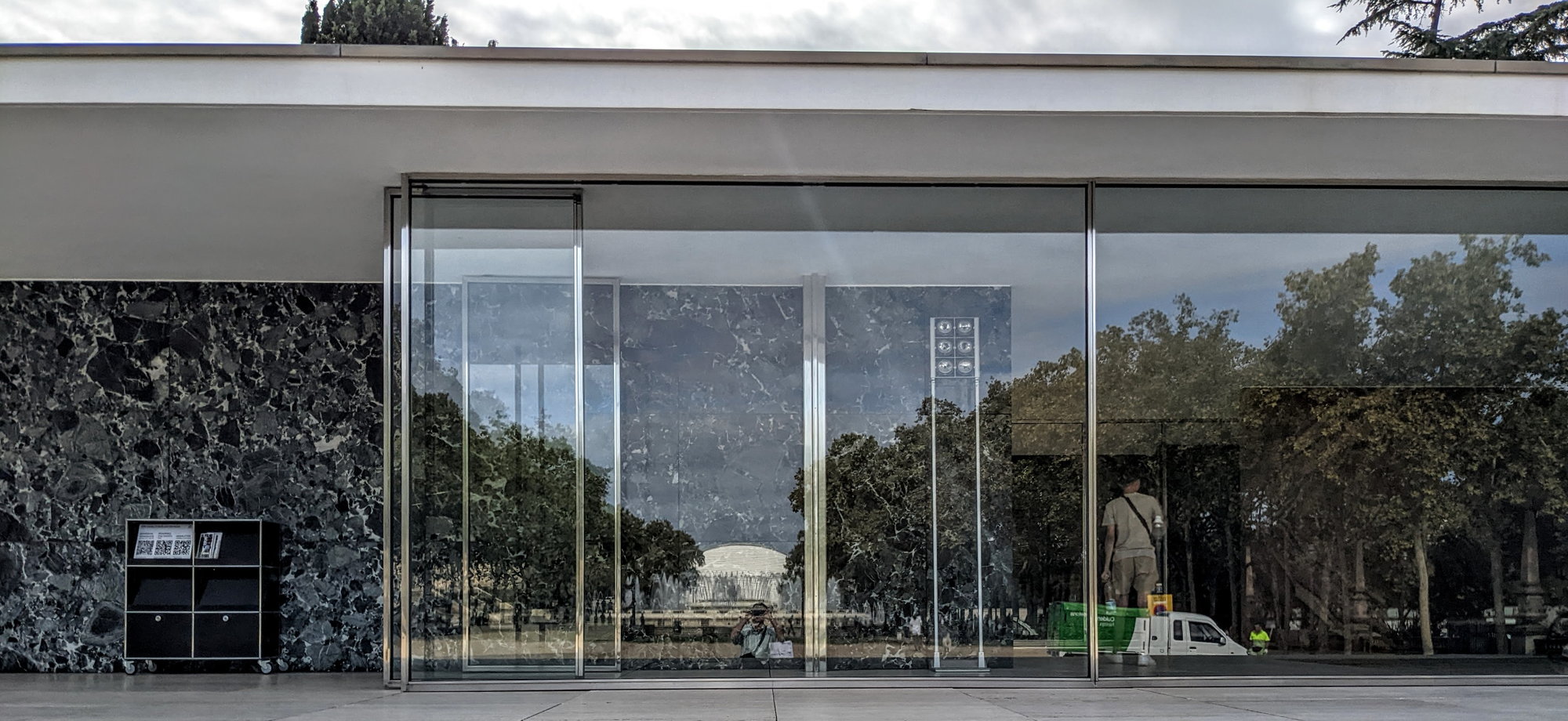
The entrance to the pavillion is to the left, passing behind the glass wall

The main reception hall is to the right; beyond is the reflecting pool and the statue of Dawn by Georg Kolbe (bronze, a recast from the original). This view shows the outer edge of the golden onyx wall.

The main reception hall, with the golden onyx wall and the well-known "Barcelona chairs" designed specifically for the German pavillion

The French ambassador to Spain takes a photo of Kolbe's statue, Dawn. By chance, he was visiting the pavillion when we were there.
During our visit, we notice a person whom we assumed to be a guide, explaining the building to three VIPs in power suits. Much later, when we were leaving the building we noticed that they were also leaving, about to get into a very impressive black limousine. So I walked up to the woman whom I thought was a guide and asked her a question about the design of the building. She was most helpful, very friendly, switching at once to flawless English. She also explained that one of the VIPs was the French ambassador to Spain (the tallest, most elegant of the three...of course). As we thank her for the information and were about to leave, I asked if she was a professor or an architect and she replied that the was the director of the Mies van der Rohe Pavillion museum! She is Dr. Anna Ramos, a delightful, brilliant person. Gracias Dr. Ramos!
The pavillion has several open spaces and two reflecting pools. Because of the pavillion's design, the interior spaces flow smoothly into the outside.
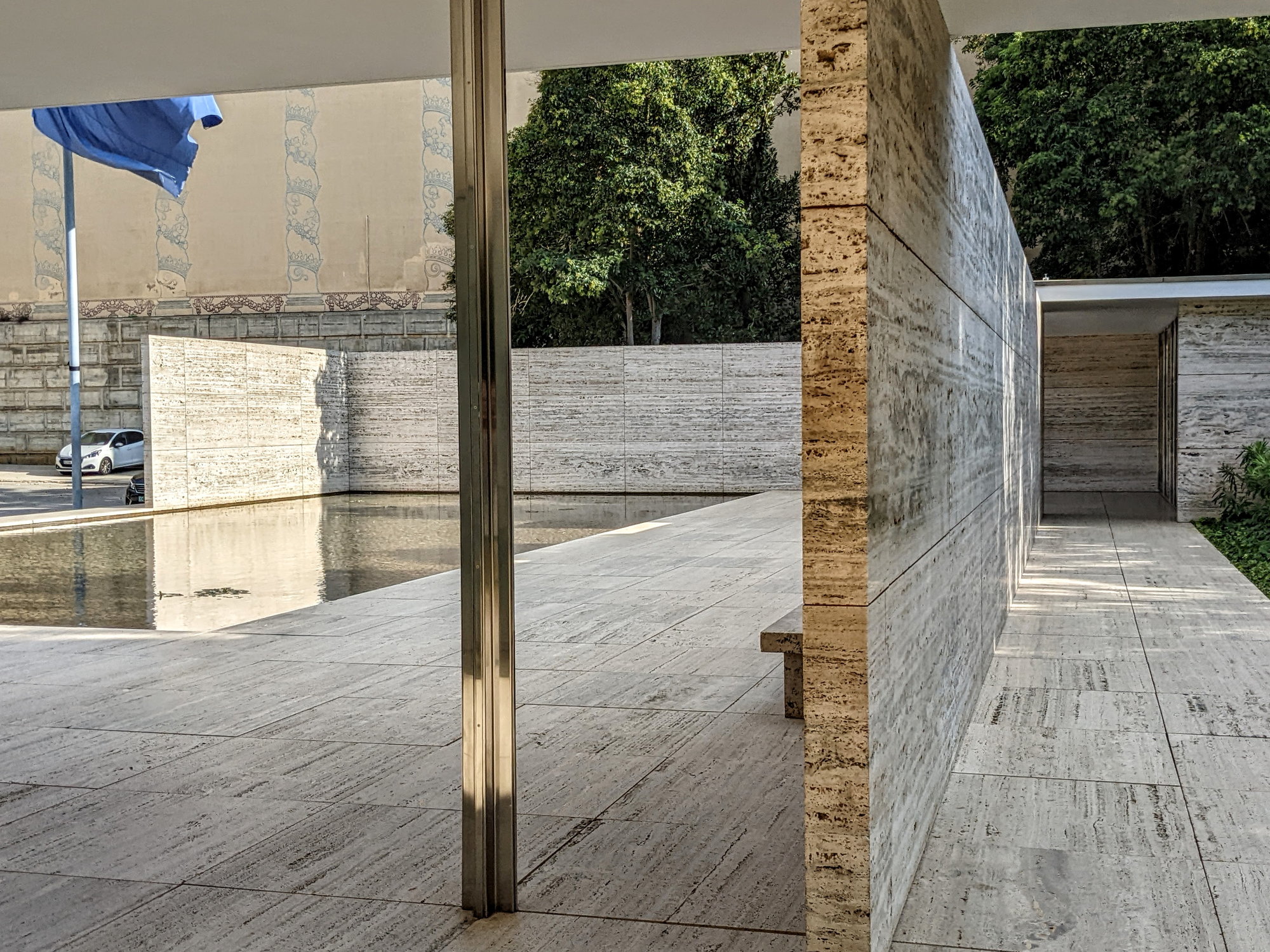
From the pavillion looking out toward the large reflecting pool on the left
The open spaces have an almost Japanese sense of design....

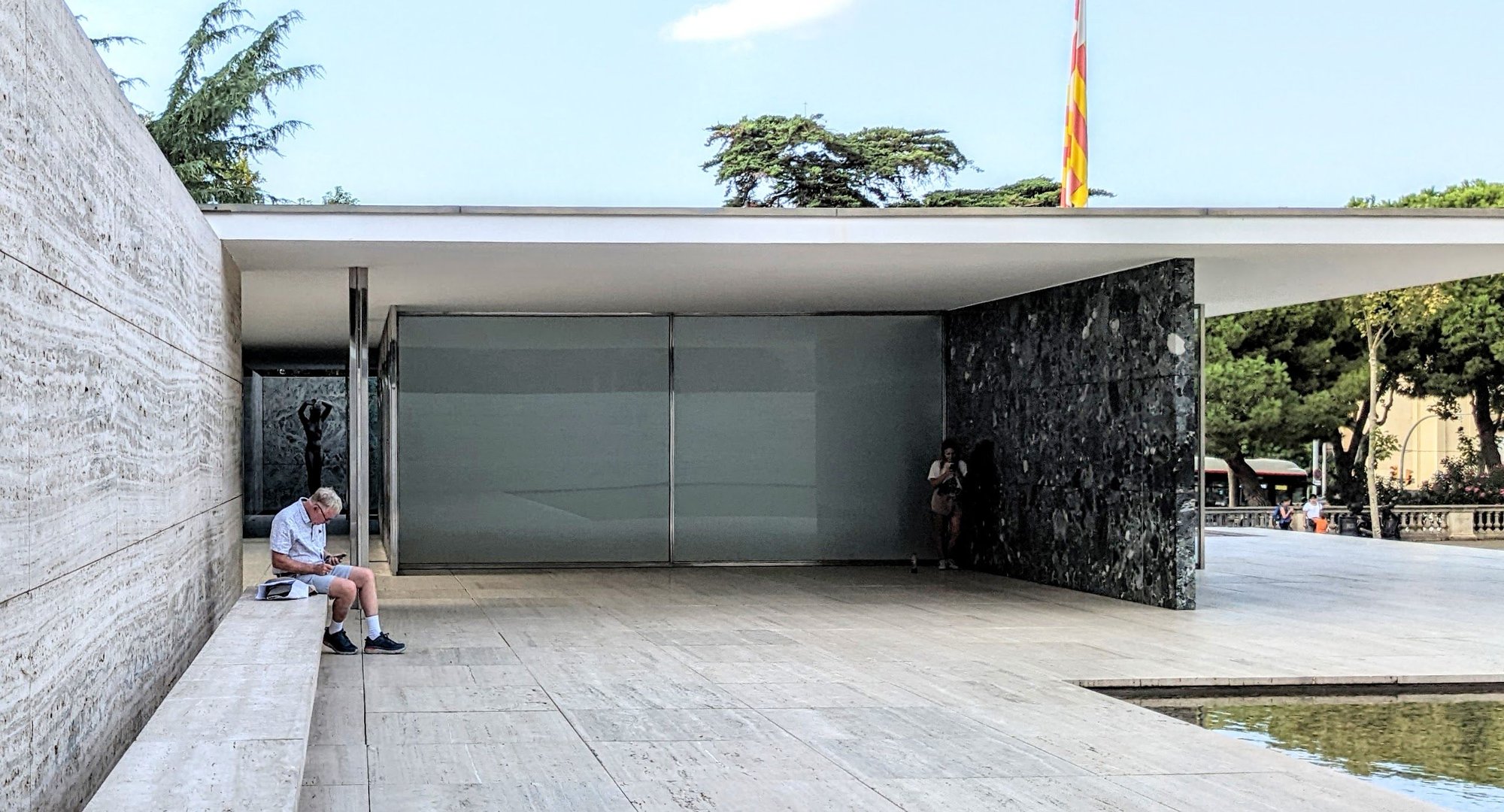
The architects who rebuilt the pavillion in the 1980s searched for materials similar in spirit to those of the original 1929 structure. Travertine, marble and onyx and three of the most beautiful materials used.
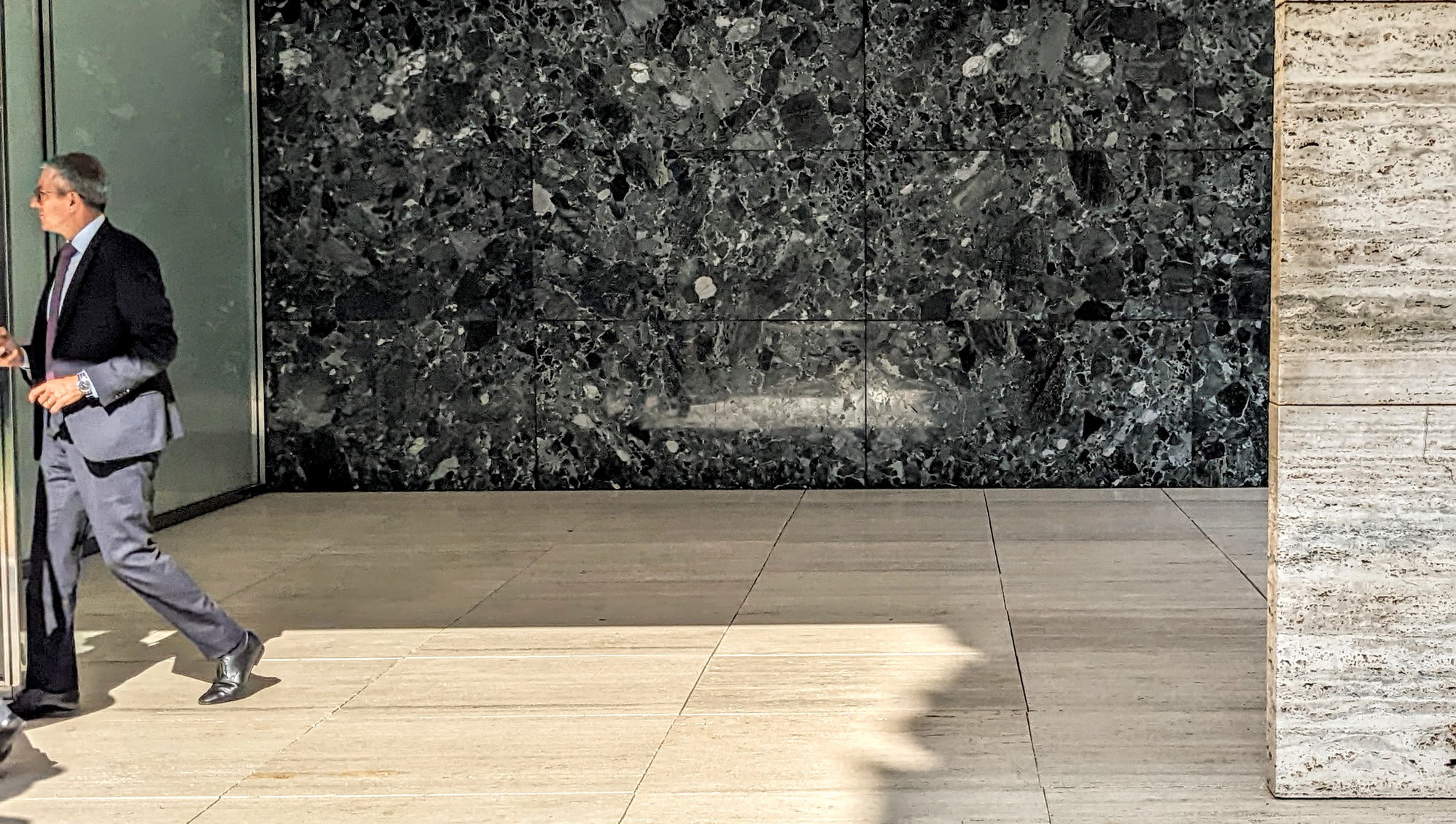
Green marble from Greece, travertine from Italy
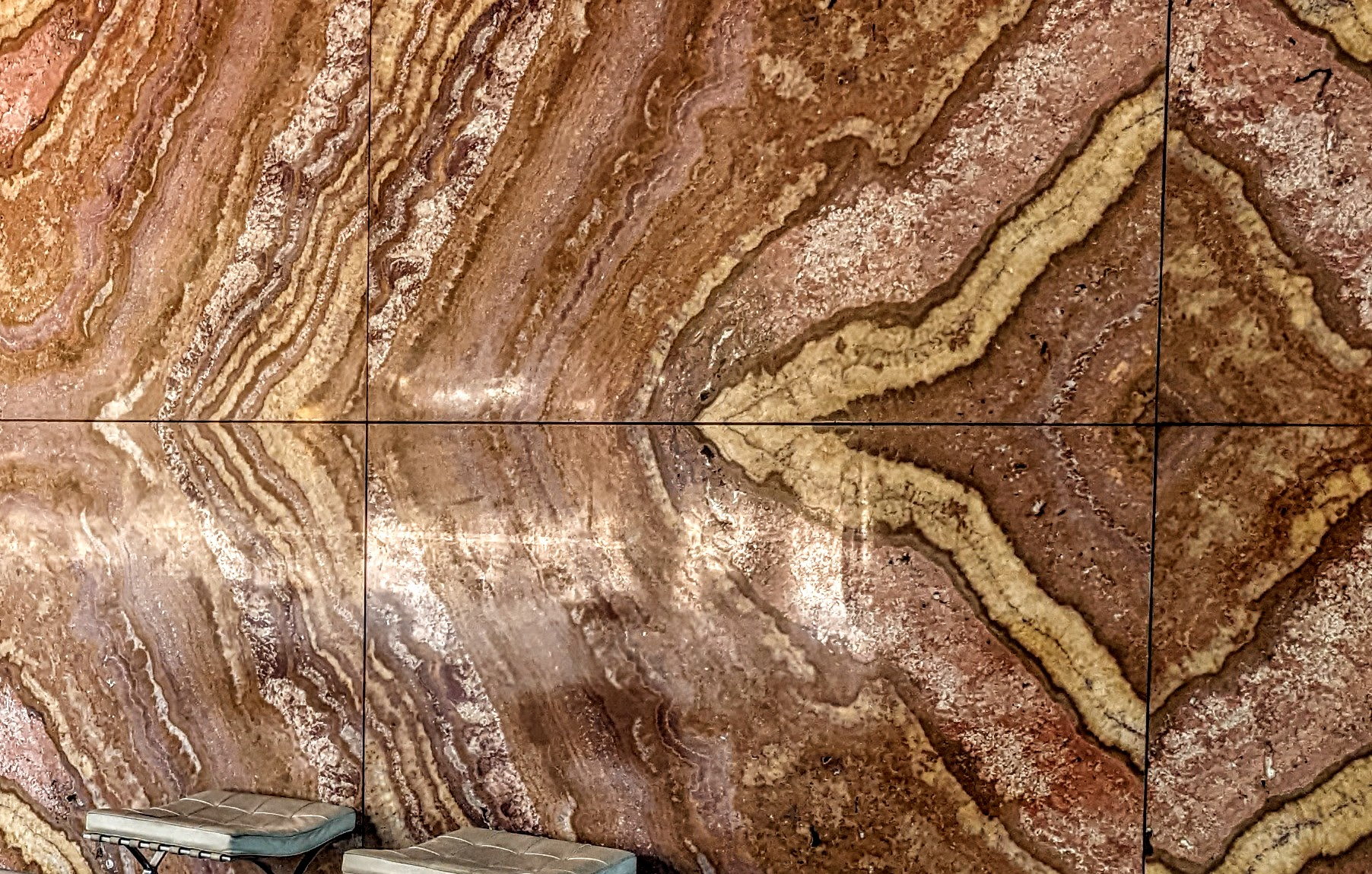
Onyx from Algeria
The fates of the original 1929 building and of the people connected with it show the turmoil of the following decades: King Alfonso XIII and German Commissioner for the fair, Georg von Schnitzler, are shown in the photo below at the dedication of the building in 1929. Alfonso would be overthrown two year later in the 1931 revolution; he fled to Paris and died in exile. Von Schnitzler, an executive of I. G. Farben, worked closely with the Nazis and was tried as a war criminal and jailed; he died in Switzerland.
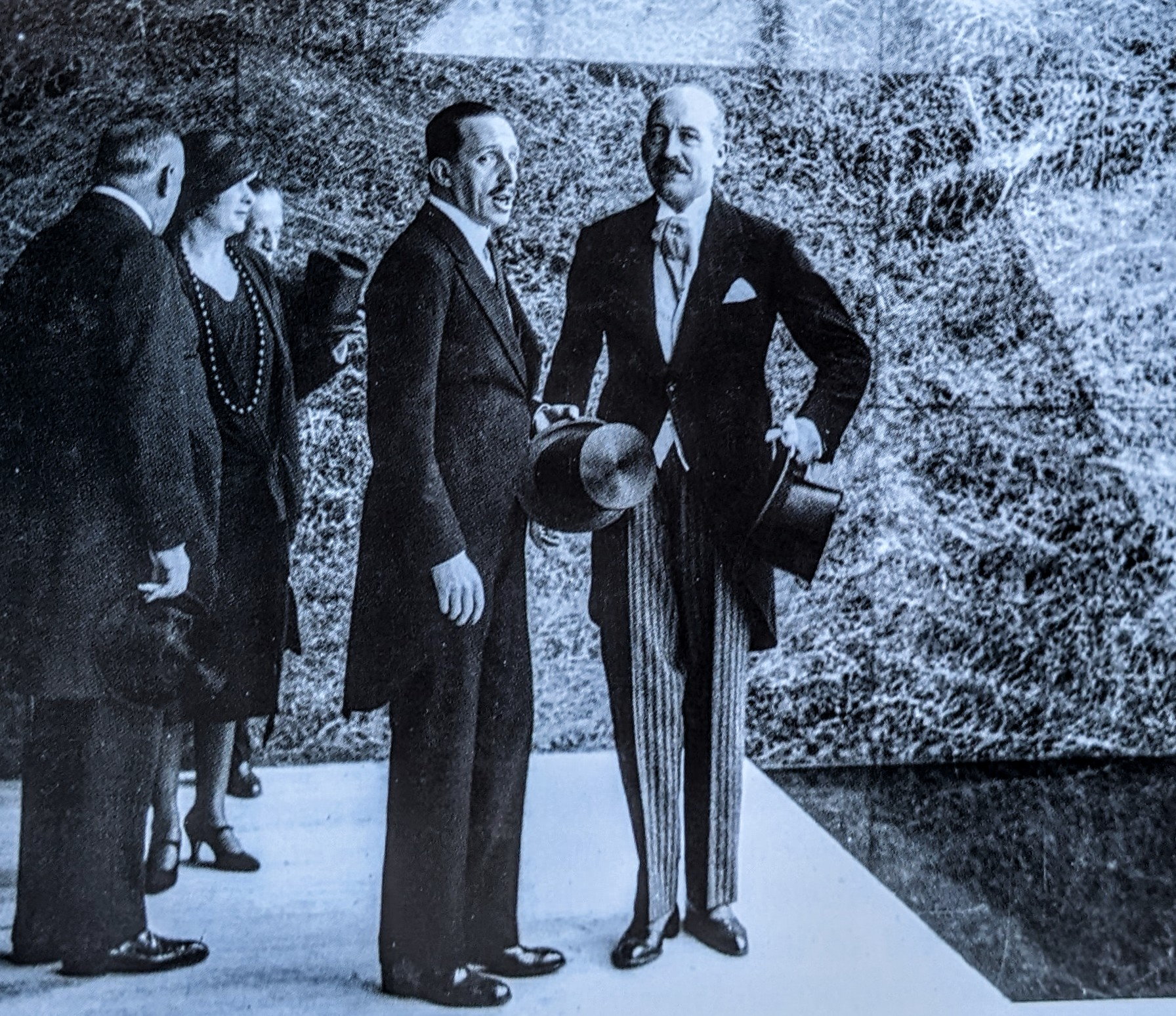
The 1929 opening of the pavillion: King Alfonso XIII in center, German commissioner Georg von Schnitzler on right
In the 1930s, Mies left Germany for the United States, becoming head of the Illinois Institute of Technology in Chicago.
Next: Picasso



This was the central building for the 1929 world's fair. The city decided not to dismantle the thing afterwards. Most of the pavillions were dismantled, however, which seems to be the usual practice with world's fairs. One important building, however, was rebuilt 50 years after it was dismantled, and this building wins the prize as The Most Beautiful Building in Barcelona, the Mies van der Rohe Pavillion.
At the foot of the immense stairway we turned left and walked to the Mies van der Rohe Pavillion, which was the national pavillion of Germany at the 1929 fair. The pavillion is set back and seems a quiet statement after the big, ornate central fair building which is today the Catalan art museum.

The German government chose Ludwig Mies van der Rohe, a member of the Bauhaus school, to design the pavillion. The work was accomplished quickly: Mies received the contract barely one year before the target date for opening the pavillion in 1929. The building rests on a low platform. Its flat roof is supported by eight chrome-covered columns--the walls themselves are not load-bearing. The function of the walls is simply to carve out space. And one feels, when walking through the building, the one is moving from one airy space to another--hard to describe but definitely different from a conventionally designed structure.

The entrance to the pavillion is to the left, passing behind the glass wall

The main reception hall is to the right; beyond is the reflecting pool and the statue of Dawn by Georg Kolbe (bronze, a recast from the original). This view shows the outer edge of the golden onyx wall.

The main reception hall, with the golden onyx wall and the well-known "Barcelona chairs" designed specifically for the German pavillion

The French ambassador to Spain takes a photo of Kolbe's statue, Dawn. By chance, he was visiting the pavillion when we were there.
During our visit, we notice a person whom we assumed to be a guide, explaining the building to three VIPs in power suits. Much later, when we were leaving the building we noticed that they were also leaving, about to get into a very impressive black limousine. So I walked up to the woman whom I thought was a guide and asked her a question about the design of the building. She was most helpful, very friendly, switching at once to flawless English. She also explained that one of the VIPs was the French ambassador to Spain (the tallest, most elegant of the three...of course). As we thank her for the information and were about to leave, I asked if she was a professor or an architect and she replied that the was the director of the Mies van der Rohe Pavillion museum! She is Dr. Anna Ramos, a delightful, brilliant person. Gracias Dr. Ramos!
The pavillion has several open spaces and two reflecting pools. Because of the pavillion's design, the interior spaces flow smoothly into the outside.

From the pavillion looking out toward the large reflecting pool on the left
The open spaces have an almost Japanese sense of design....


The architects who rebuilt the pavillion in the 1980s searched for materials similar in spirit to those of the original 1929 structure. Travertine, marble and onyx and three of the most beautiful materials used.

Green marble from Greece, travertine from Italy

Onyx from Algeria
The fates of the original 1929 building and of the people connected with it show the turmoil of the following decades: King Alfonso XIII and German Commissioner for the fair, Georg von Schnitzler, are shown in the photo below at the dedication of the building in 1929. Alfonso would be overthrown two year later in the 1931 revolution; he fled to Paris and died in exile. Von Schnitzler, an executive of I. G. Farben, worked closely with the Nazis and was tried as a war criminal and jailed; he died in Switzerland.

The 1929 opening of the pavillion: King Alfonso XIII in center, German commissioner Georg von Schnitzler on right
In the 1930s, Mies left Germany for the United States, becoming head of the Illinois Institute of Technology in Chicago.
Next: Picasso
#9
Original Poster
Join Date: Aug 2013
Posts: 747
Likes: 0
Received 0 Likes
on
0 Posts
The Picasso Museum is housed in five medieval palaces in the old quarter. Many of the rooms, especially those housing Picasso's ceramics, are ornate and very beautiful.


The museum's collection is an interesting one--strong in his very early works and also in his later years but not much for his middle decades.
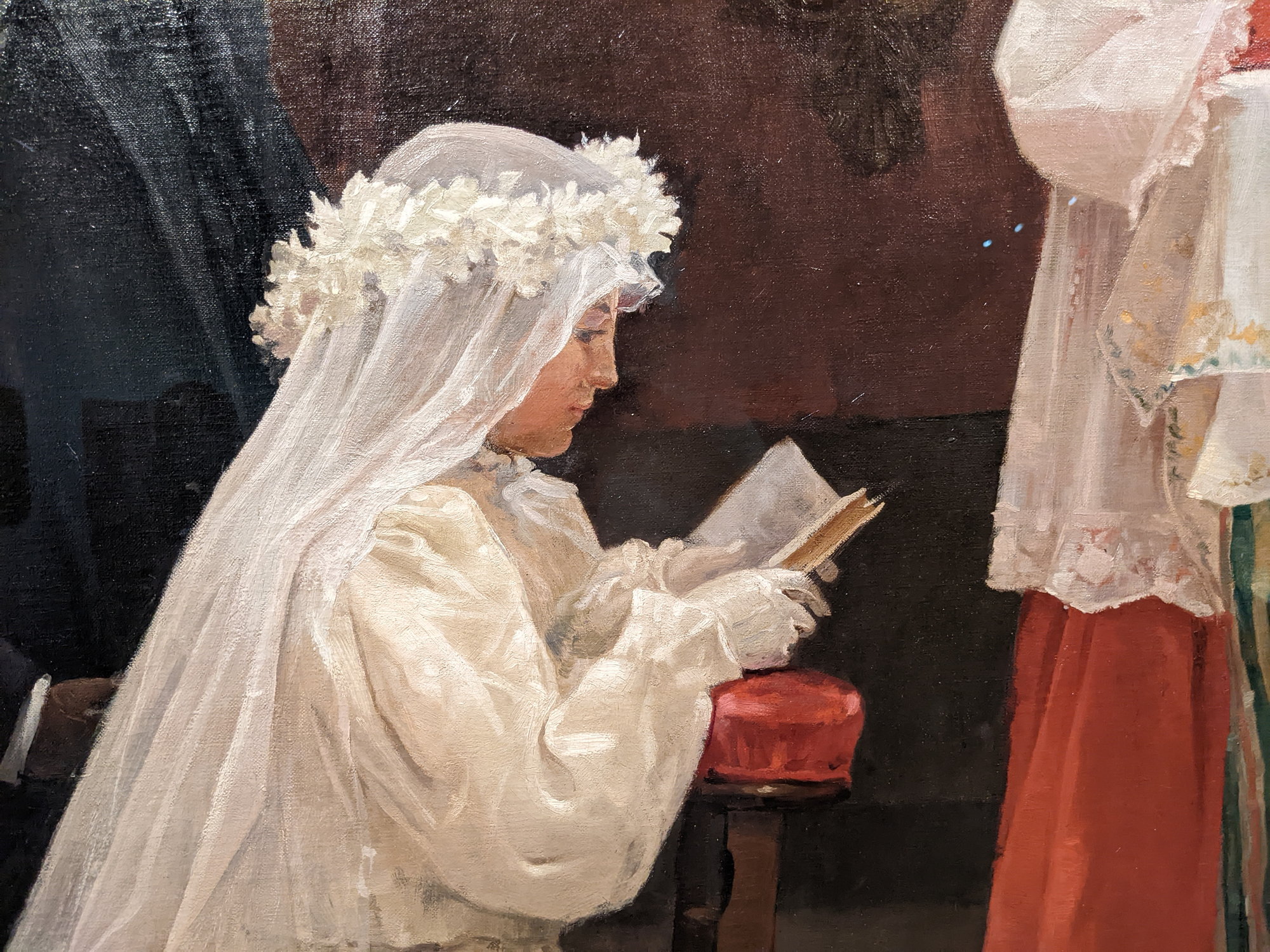
Detail of Picasso's "The First Communion," painted when he was 14
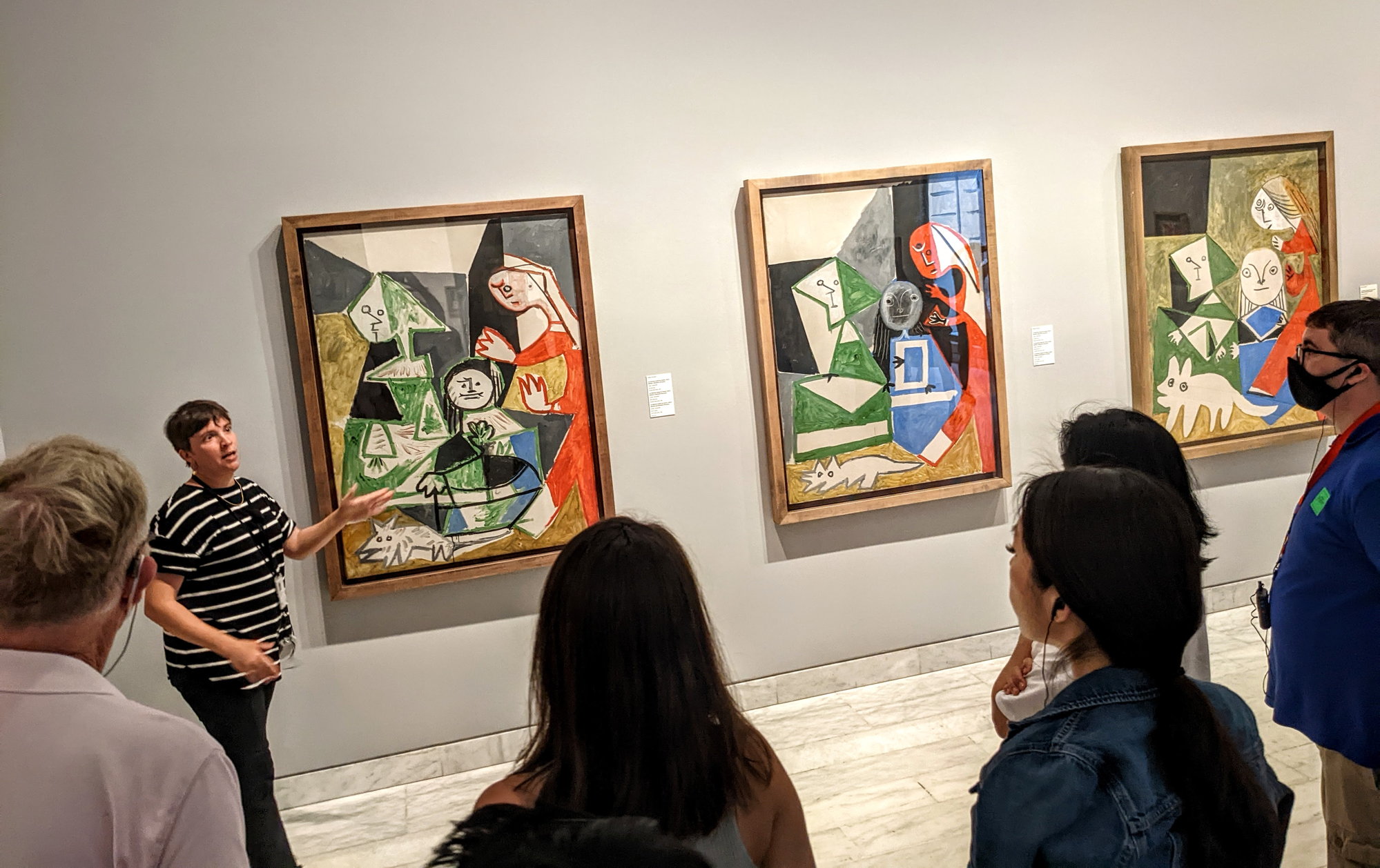
Our excellent guide explains Picasso's series of variations (more than 50) on Velasquez' "Las Meninas"
[Note to readers: my computer is acting strangely, deleting my drafts, so I am going to post small bits quickly one by one so they don't disappear...]


The museum's collection is an interesting one--strong in his very early works and also in his later years but not much for his middle decades.

Detail of Picasso's "The First Communion," painted when he was 14

Our excellent guide explains Picasso's series of variations (more than 50) on Velasquez' "Las Meninas"
[Note to readers: my computer is acting strangely, deleting my drafts, so I am going to post small bits quickly one by one so they don't disappear...]
#11
Original Poster
Join Date: Aug 2013
Posts: 747
Likes: 0
Received 0 Likes
on
0 Posts
A word and a couple of pics of our hotel...we stayed at the Hotel Rec Comtal, bordering the old quarter. Half a block from the Arc de Triomf and a few doors down from what became our favorite restaurant, Elsa y Fred. It's a new building with sort of hip, edgy style which we enjoyed.
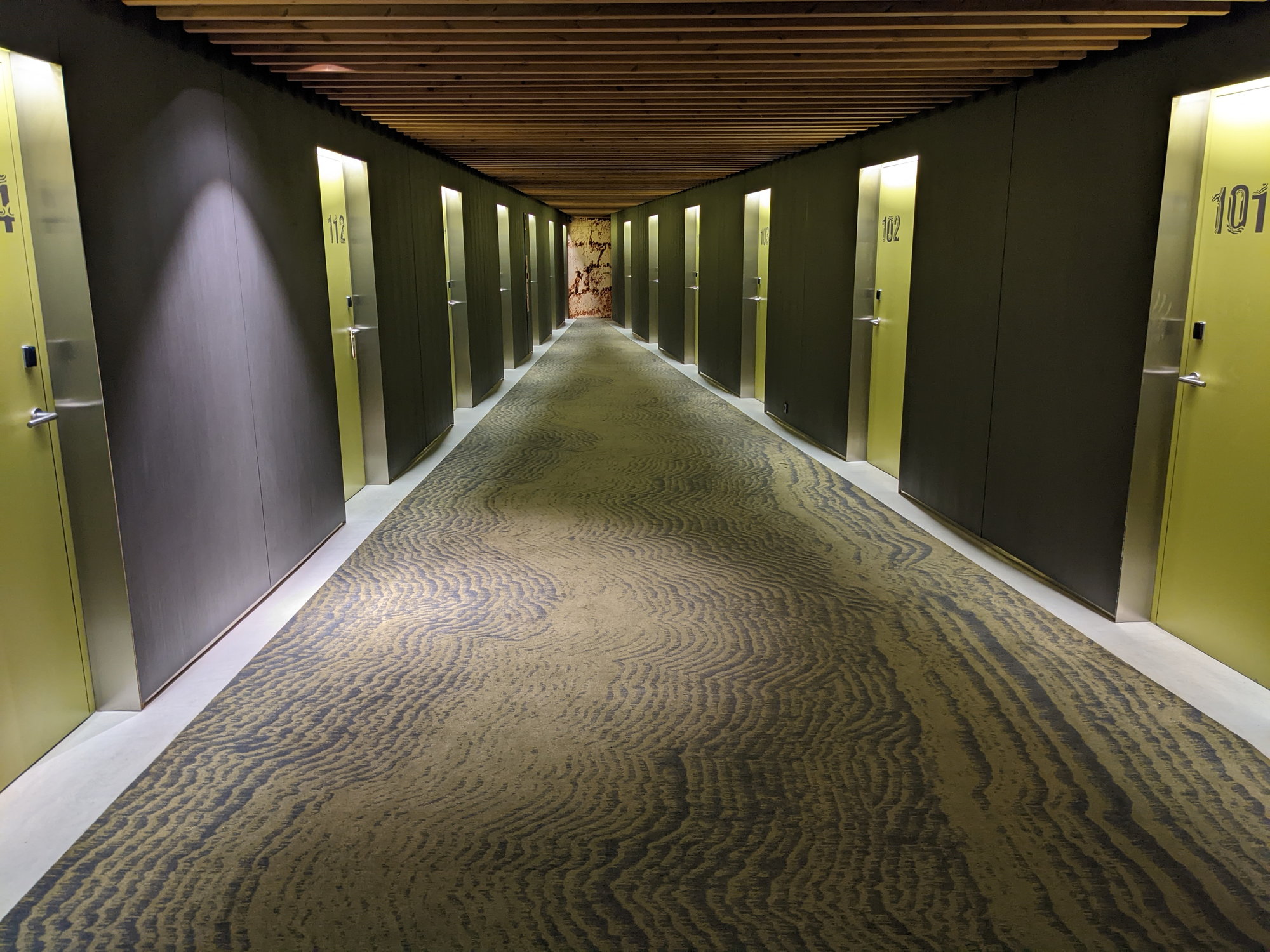
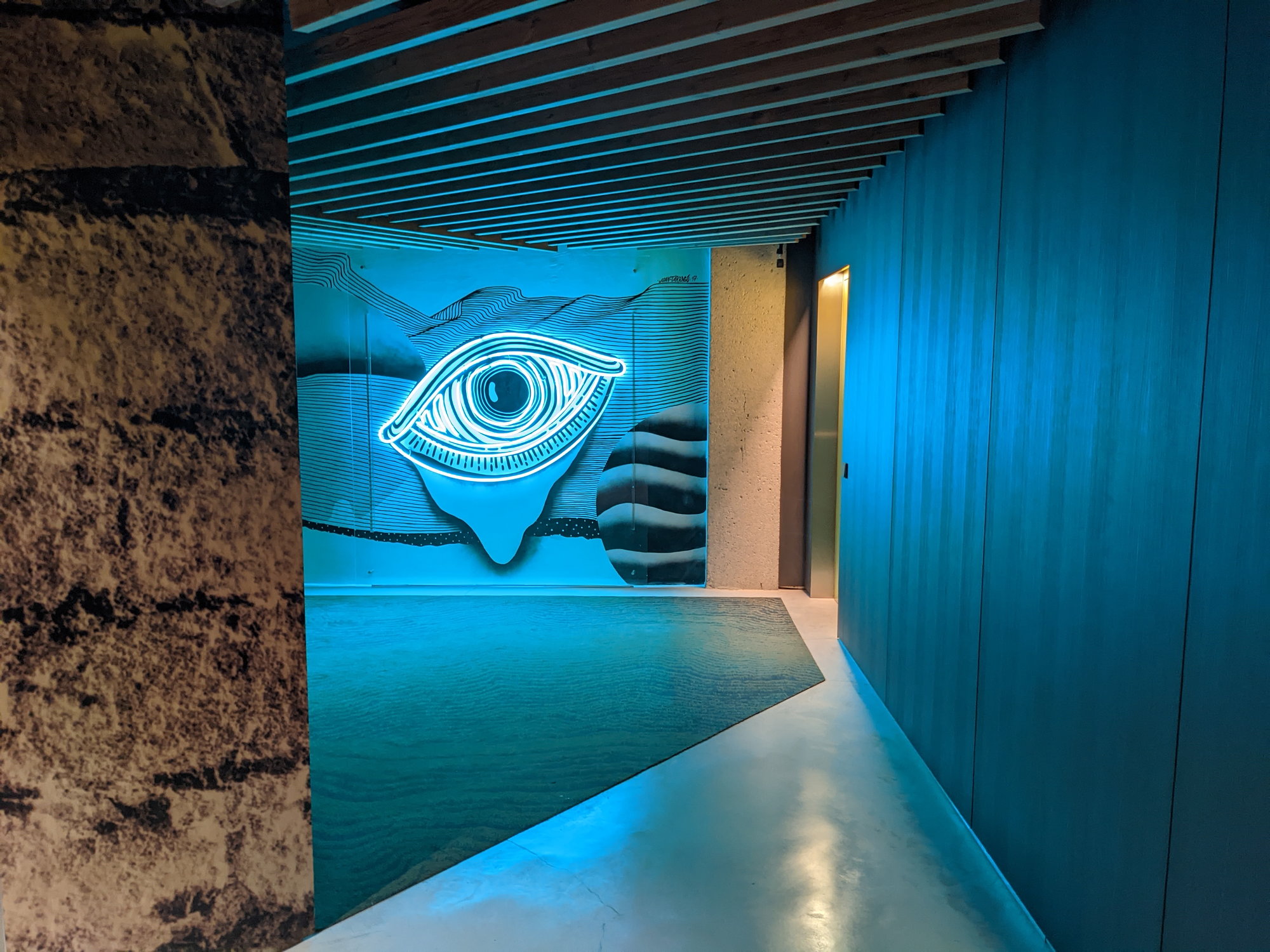
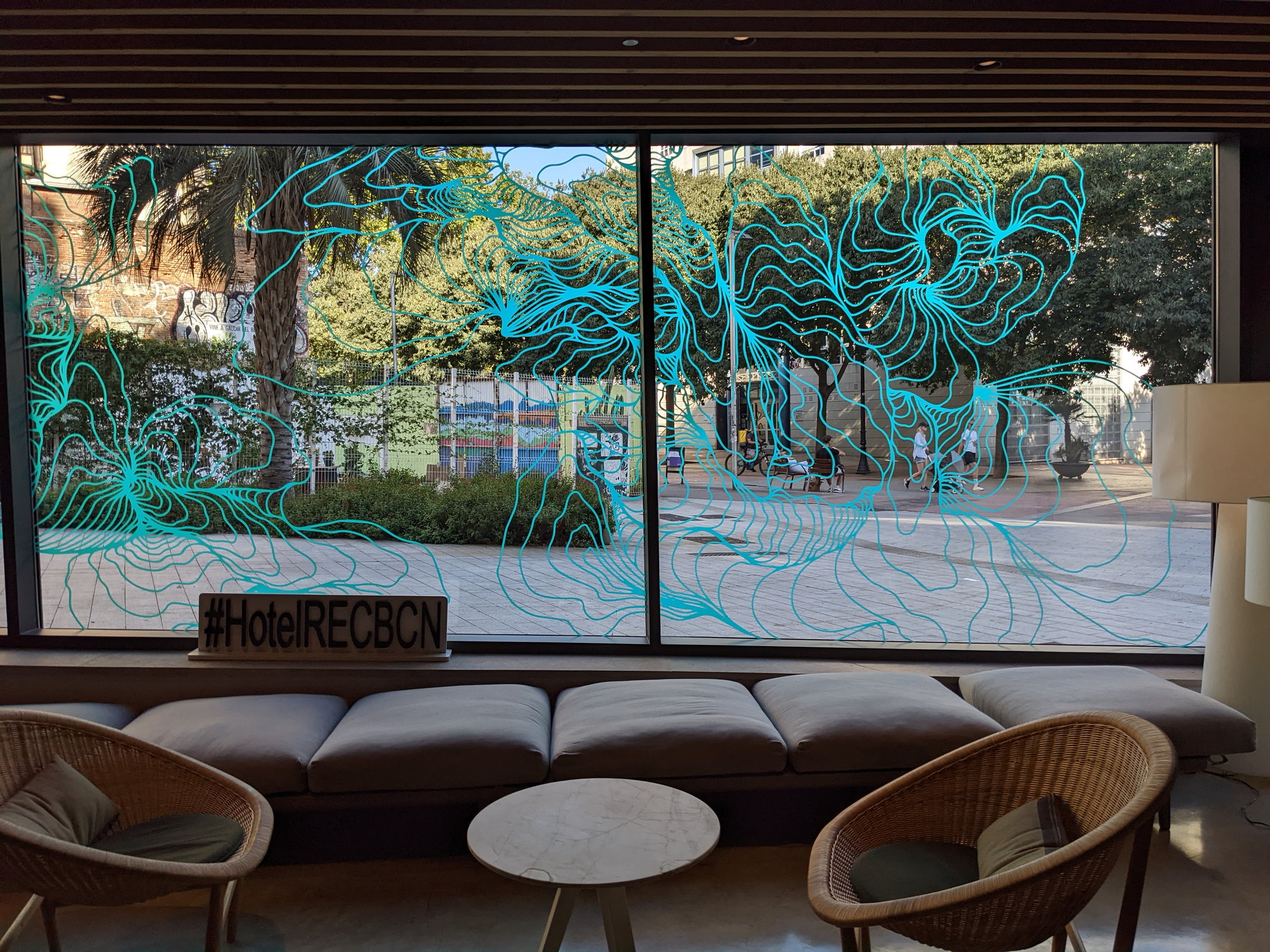
In the evening we liked to walk around the Arc de Triomf toward the Ciutadella park, beautifully illuminated at night.
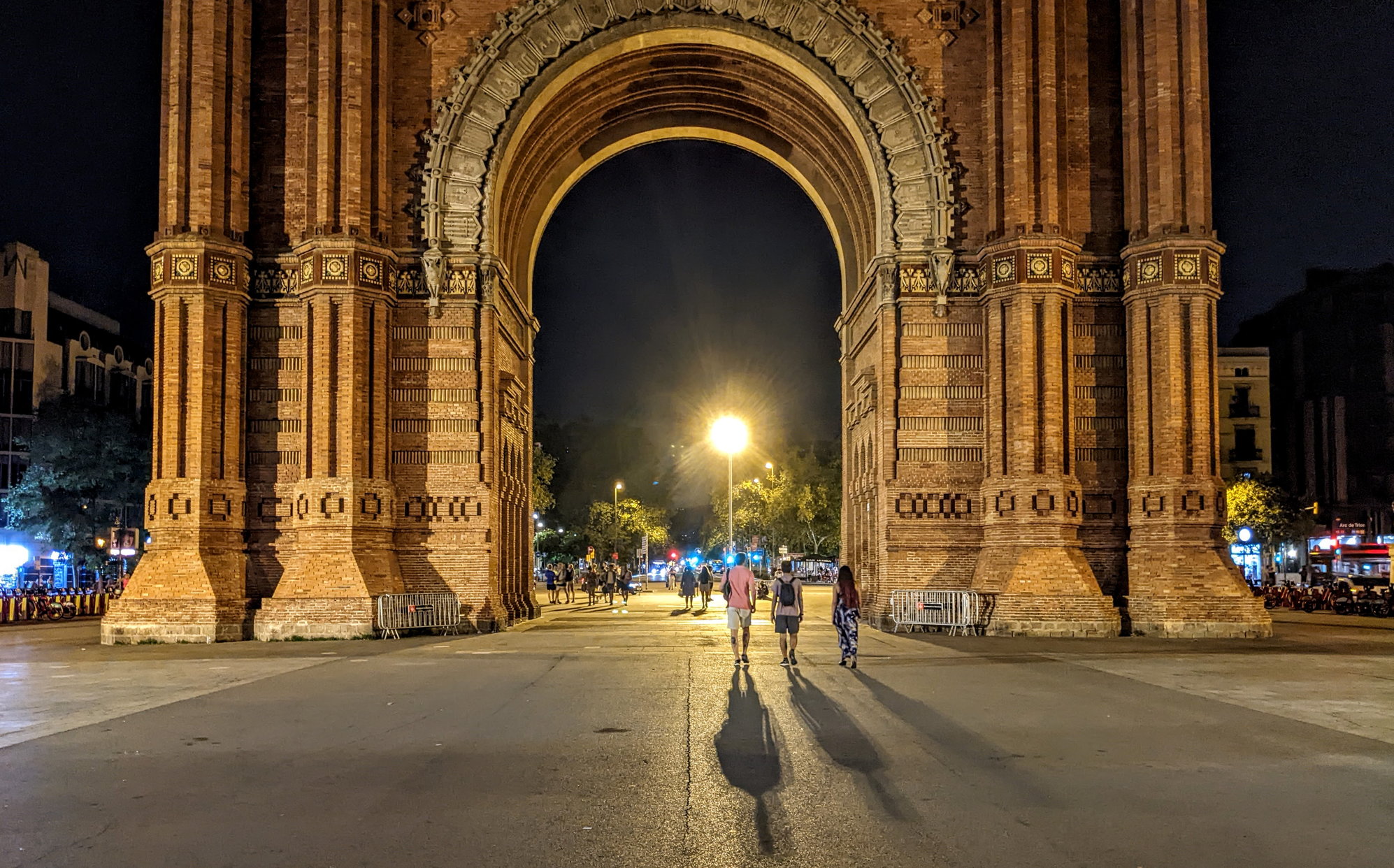
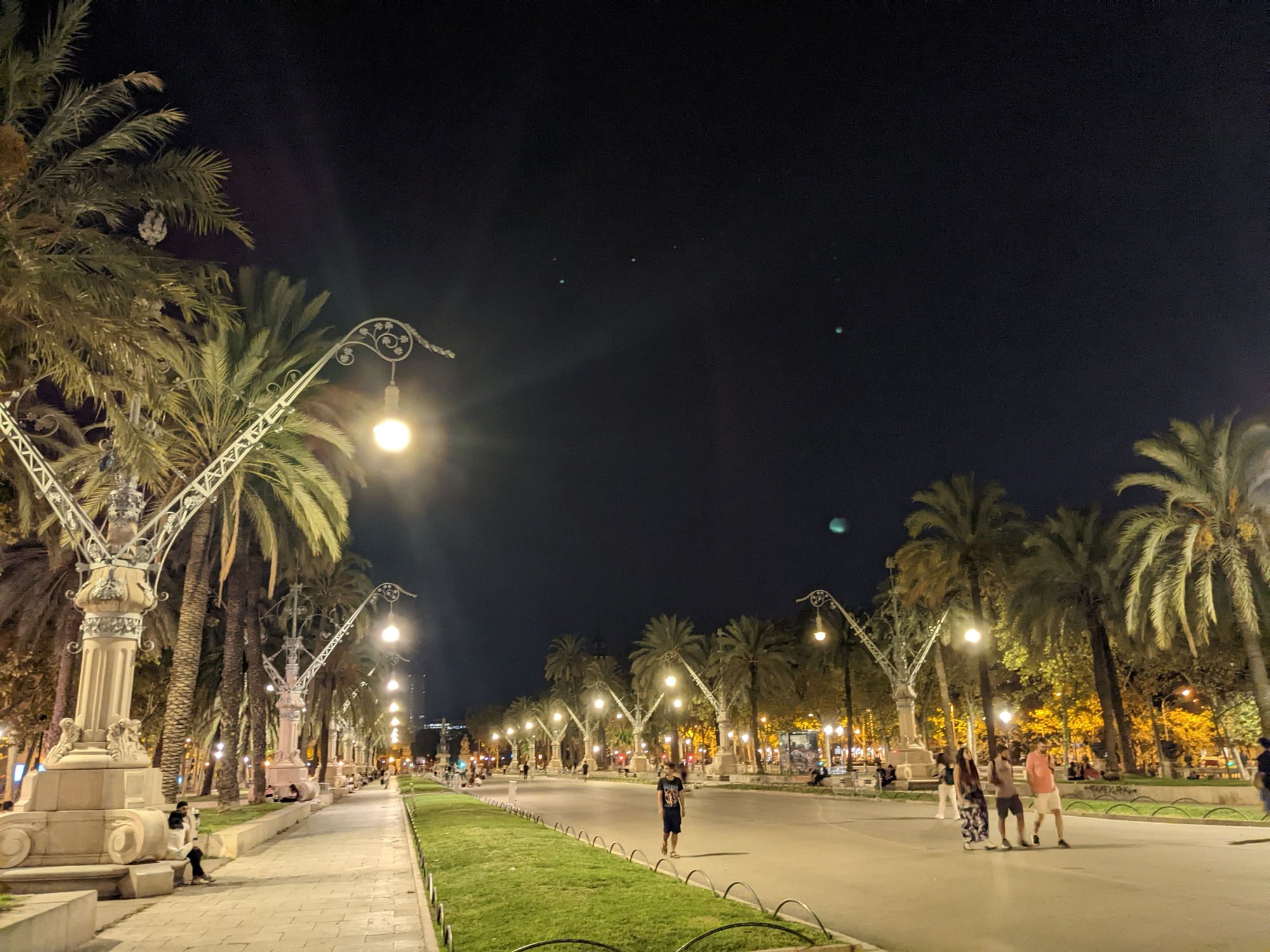



In the evening we liked to walk around the Arc de Triomf toward the Ciutadella park, beautifully illuminated at night.


#15
Original Poster
Join Date: Aug 2013
Posts: 747
Likes: 0
Received 0 Likes
on
0 Posts
We booked an English language tour of the Palau de la Musica, which a friend had visited earlier and urged us to see. It's a prime example of the "modernisme" style of architecture prevalent in Barcelona at the beginning of the 20th century. The interior practically blazes with color.
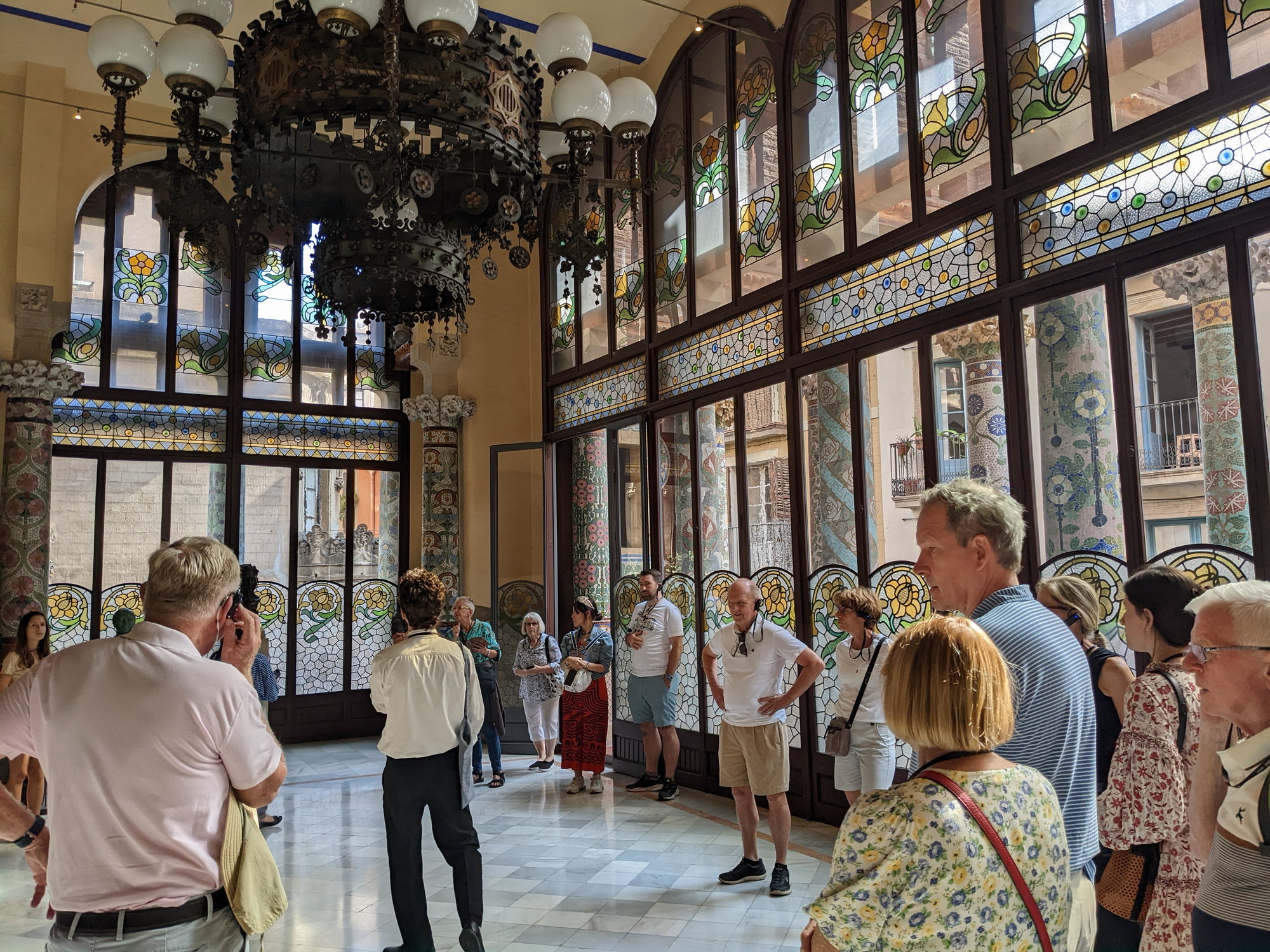
Our group assembles in the foyer for the tour
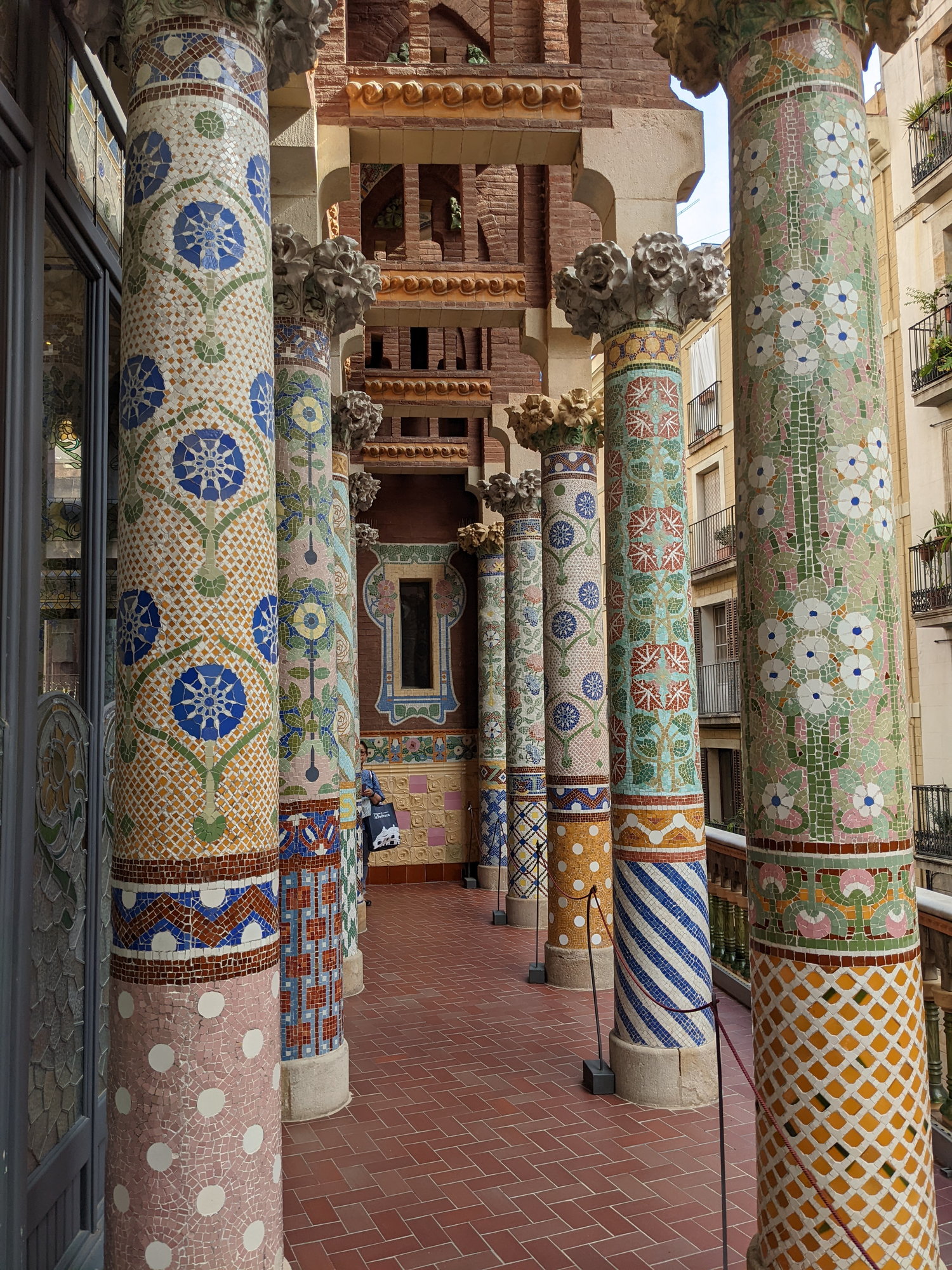
The columns on the porch outside the foyer

The interior with the sunburst skylight
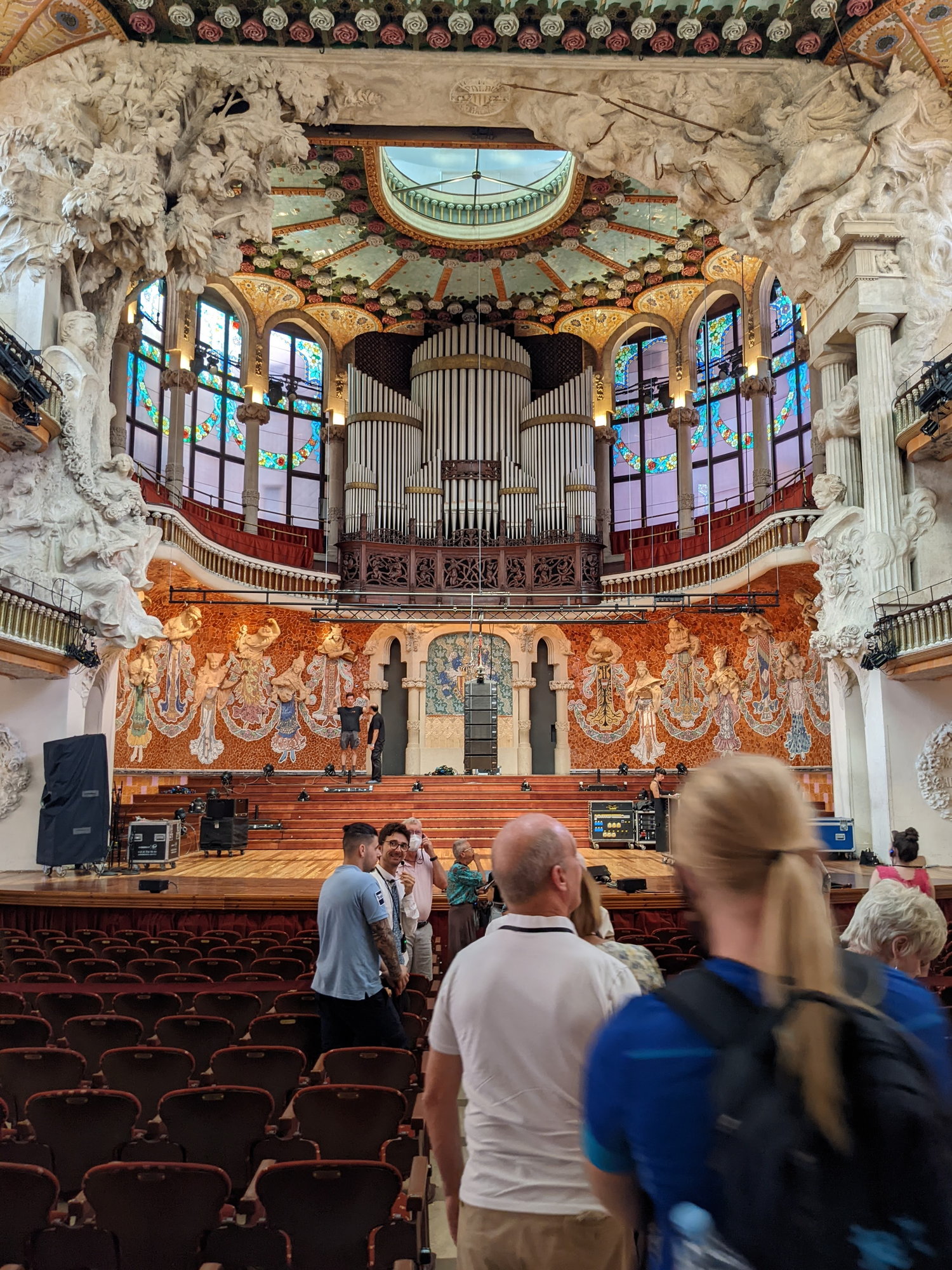
The stage with the great organ, which has 3,000 pipes according to our guide
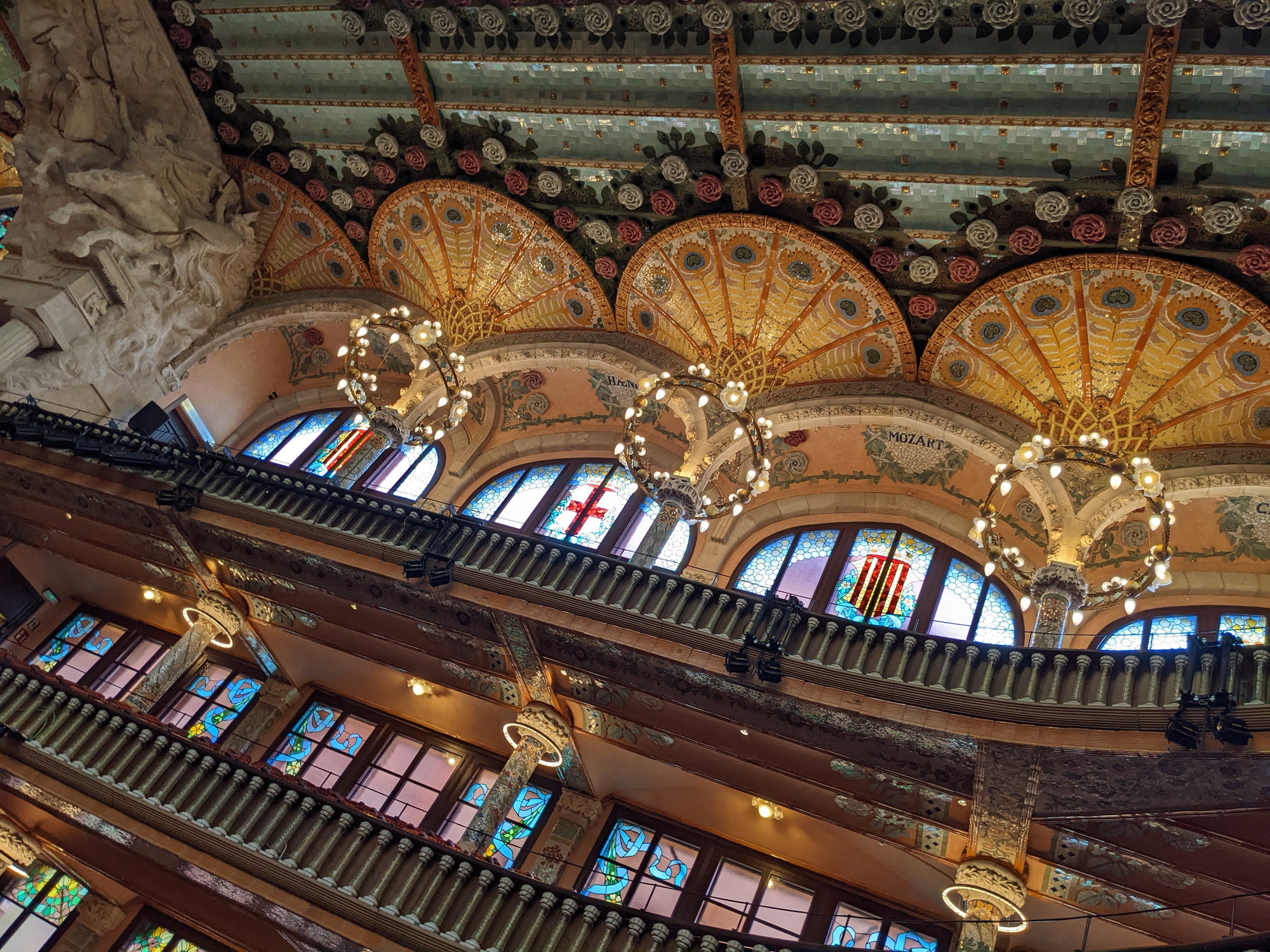
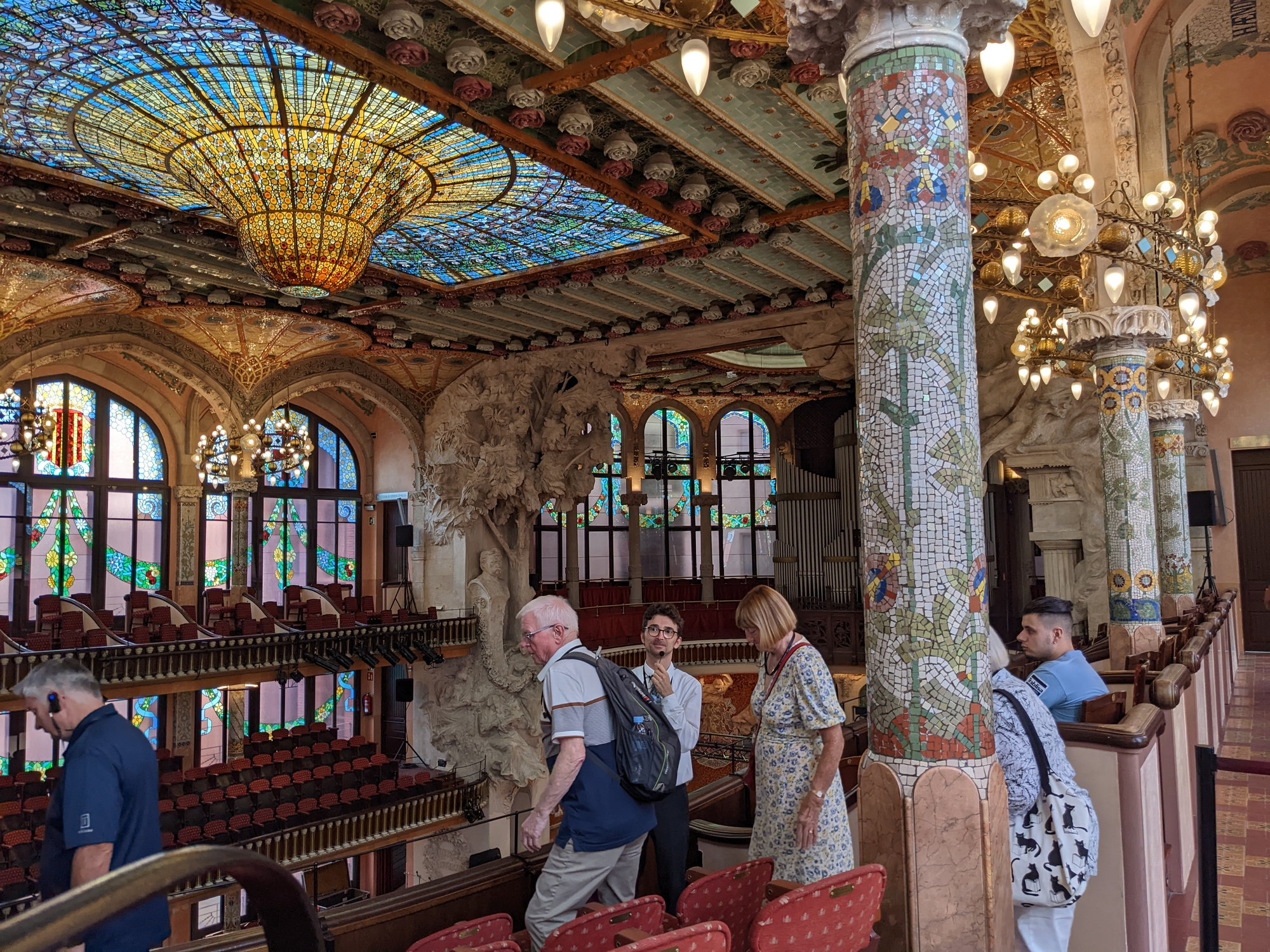
After our tour of the Palau, we walked to the Santa Caterina market....
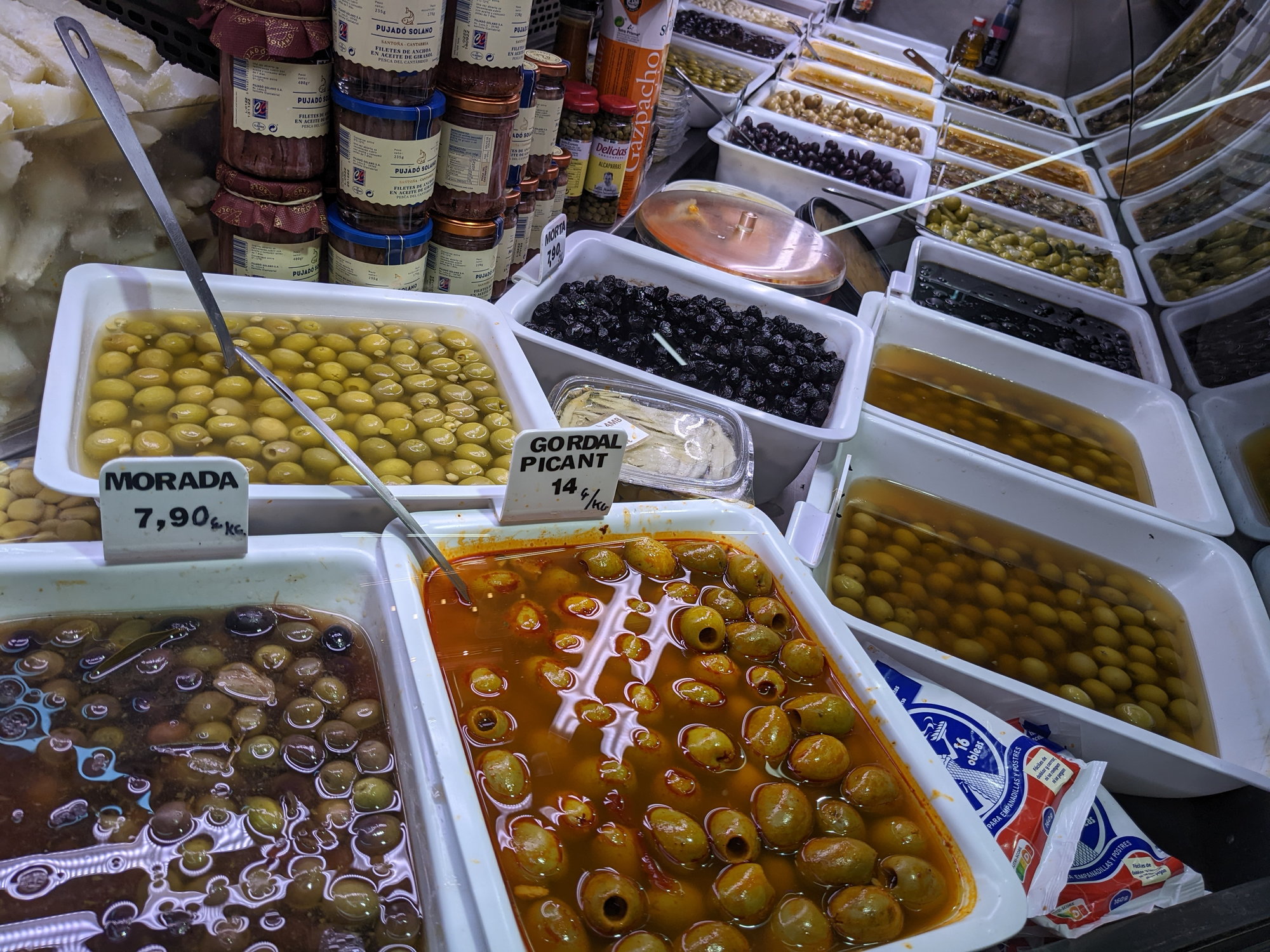
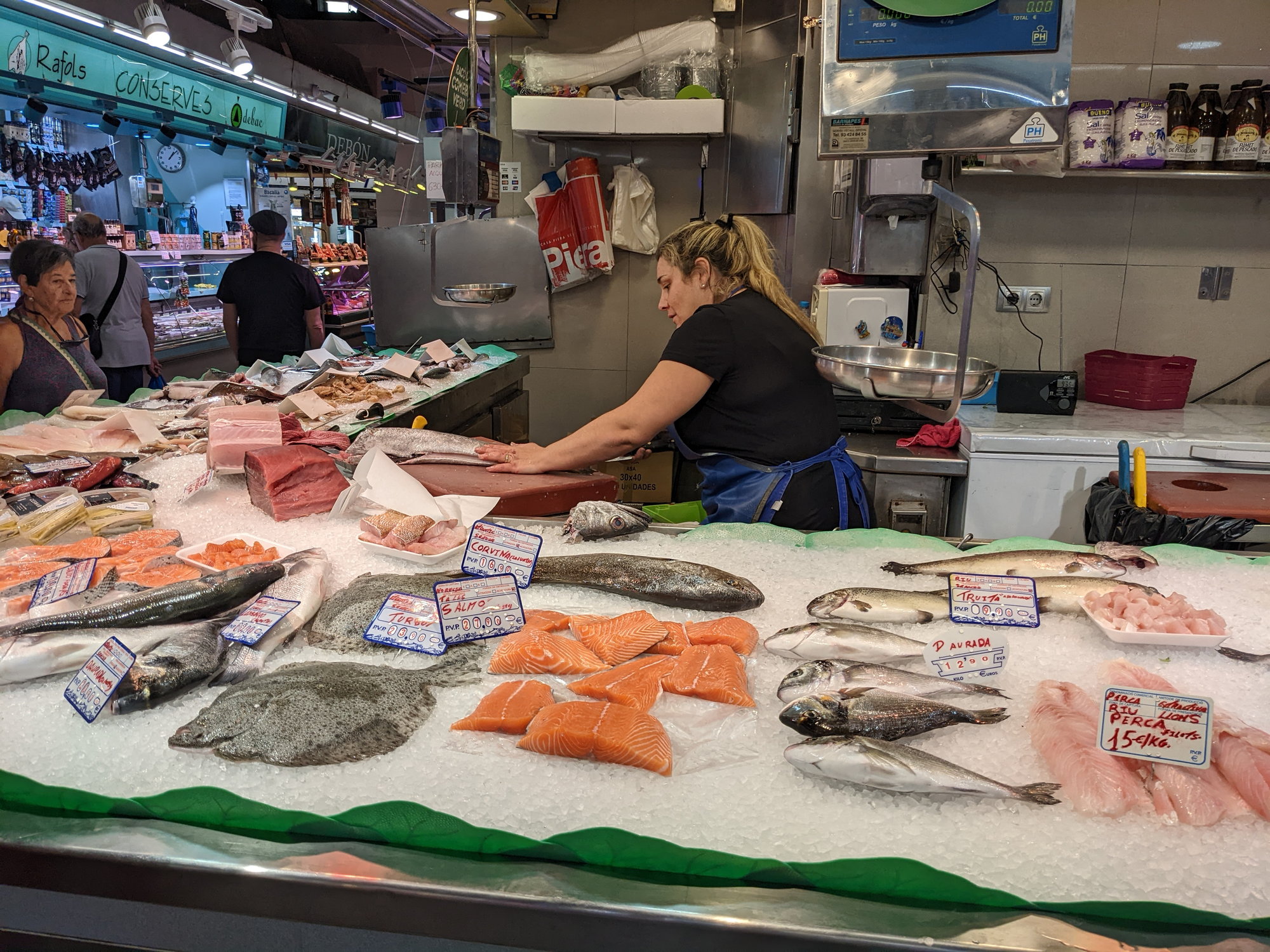
...meeting some doggie friends along the way...
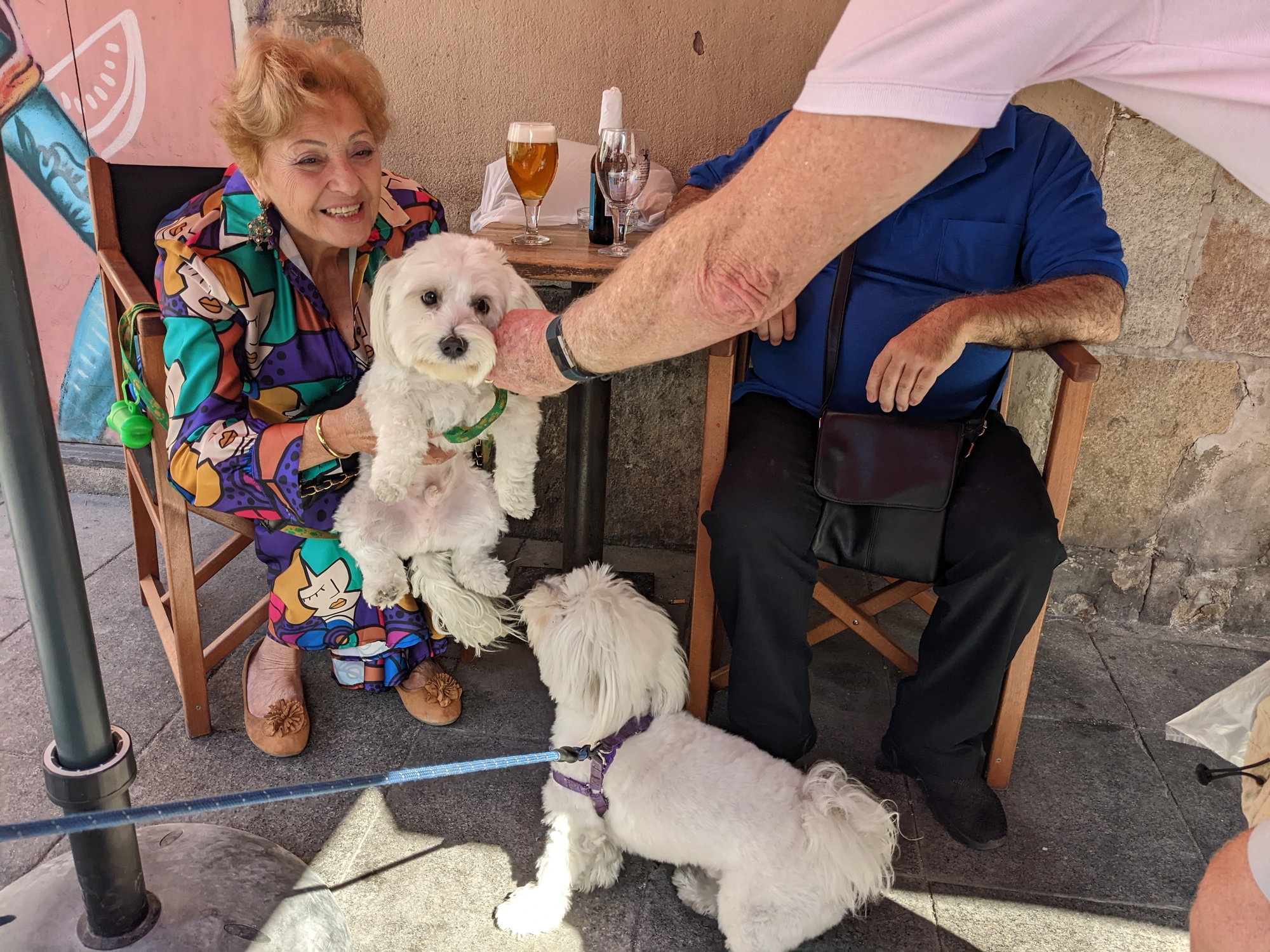
...and then to Santa Maria del Mar...
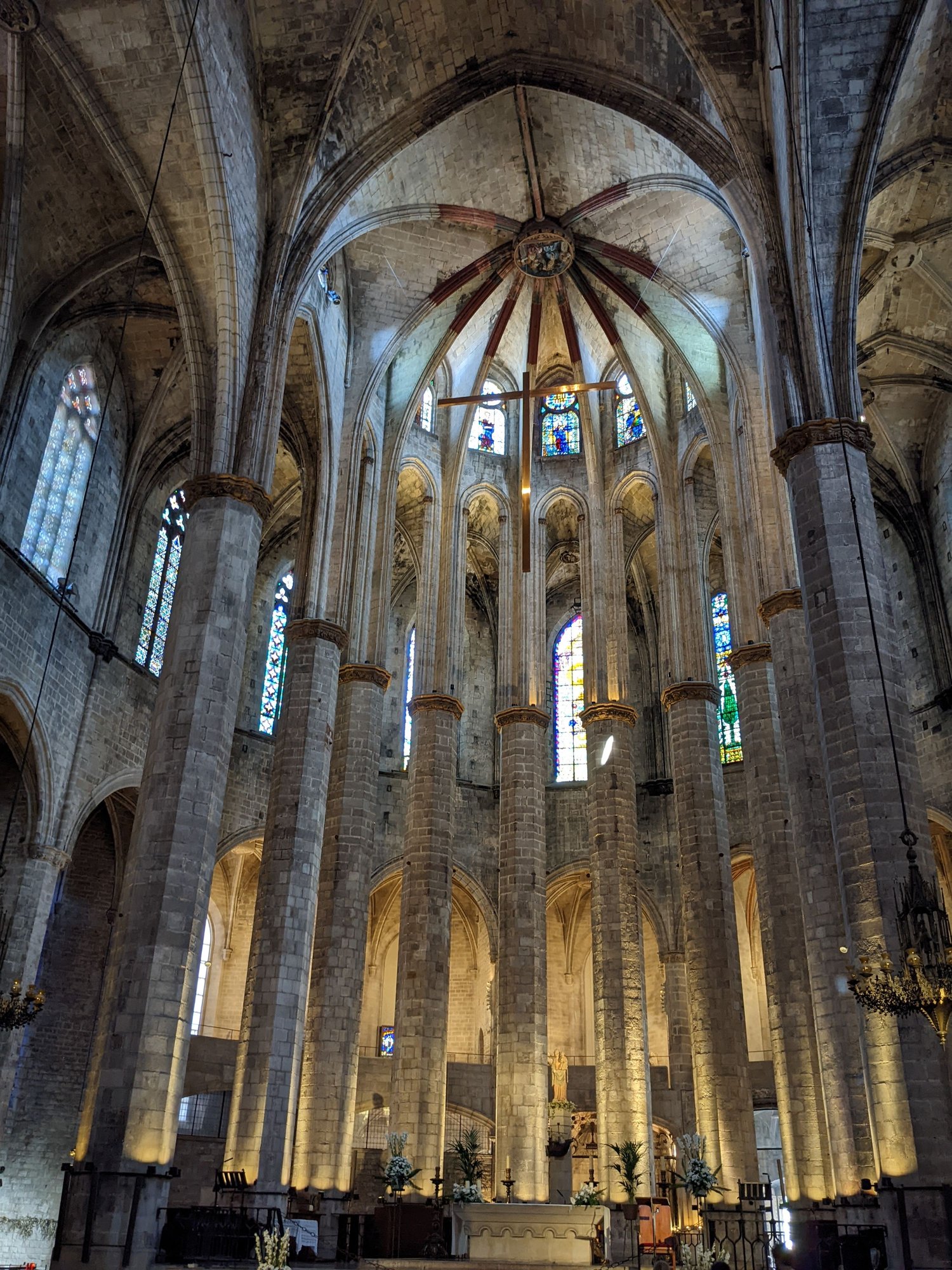
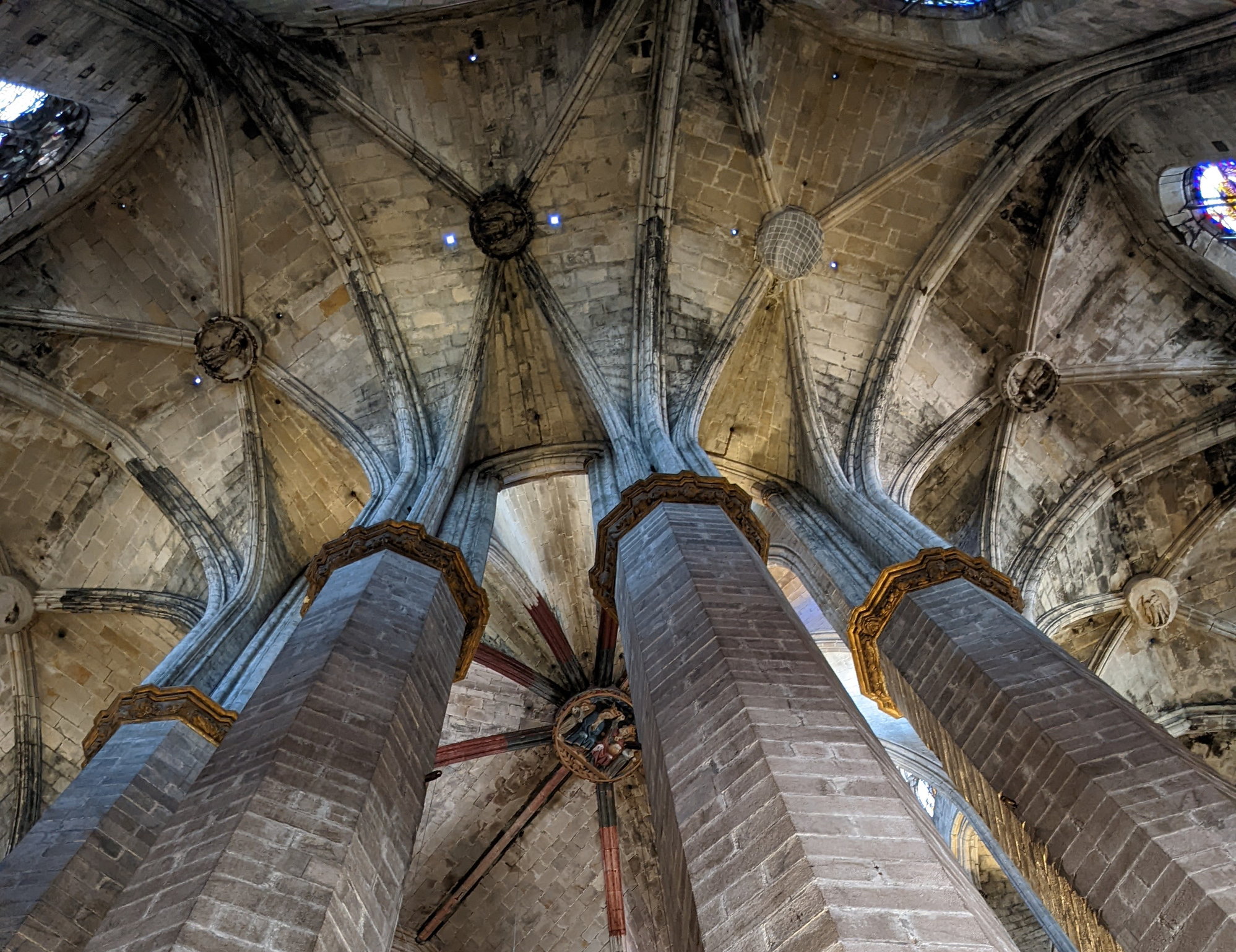
The building shows the signs of the attack by anti-clerical rioters in 1936; the church burned for days and all of the statues and decorations were destroyed
As we continued to walk through the Barri Gotic, we saw signs of Catalonia's struggle for independence...
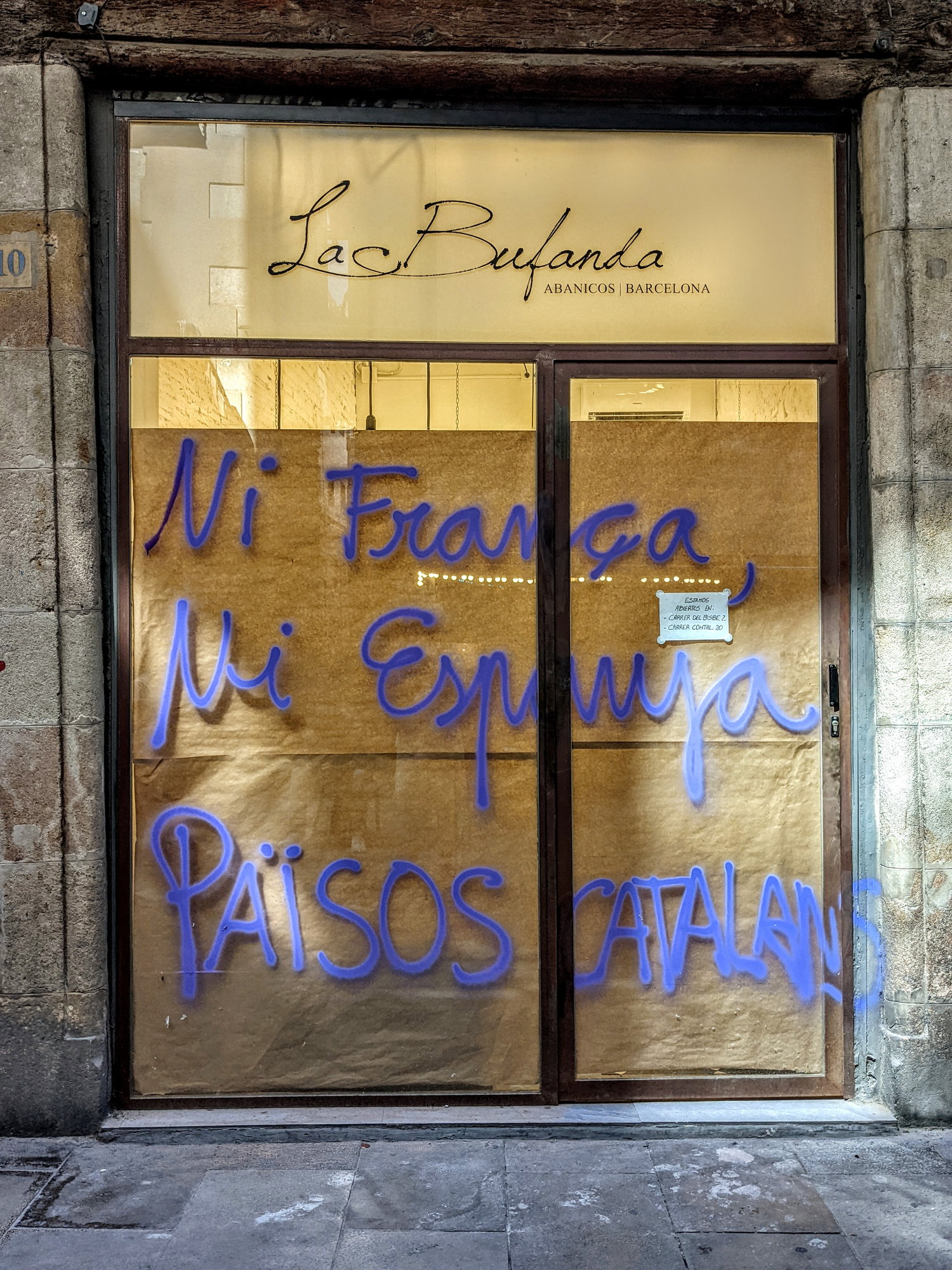
"Not France, Not Spain, Catalonia!"
After four days in Barcelona, we hopped the bus to Tossa de Mar on the Costa Brava, a little more than an hour's ride.
Next: Tossa de Mar

Our group assembles in the foyer for the tour

The columns on the porch outside the foyer

The interior with the sunburst skylight

The stage with the great organ, which has 3,000 pipes according to our guide


After our tour of the Palau, we walked to the Santa Caterina market....


...meeting some doggie friends along the way...

...and then to Santa Maria del Mar...


The building shows the signs of the attack by anti-clerical rioters in 1936; the church burned for days and all of the statues and decorations were destroyed
As we continued to walk through the Barri Gotic, we saw signs of Catalonia's struggle for independence...

"Not France, Not Spain, Catalonia!"
After four days in Barcelona, we hopped the bus to Tossa de Mar on the Costa Brava, a little more than an hour's ride.
Next: Tossa de Mar
#17
Original Poster
Join Date: Aug 2013
Posts: 747
Likes: 0
Received 0 Likes
on
0 Posts
We arrived in Tossa de Mar in the early afternoon and walked through the narrow streets of the "new" town (about 18th century, whitewashed buildings, reminded me of my image of Greece, where I've never been). Our hotel was the Hotel Diana, also shown on the tourist map as the Casa Sans. It was originally a mansion built in the early 20th century for Joan Sans y More, a wealthy businessman who made his fortune in Latin America, as was the case with many Catalan entrepreneurs such as the father of Eusebi Guell, the patron of Gaudi. The architect was Antoni de Figuera whose work was very much in the "modernisme" tradition. Today it is a protected historic structure. There is some fascinating information about the design of the mansion.
The facade facing the Mediterranean is white stucco with beautiful ornamentation. It includes a statue of Diana, goddess of the hunt, created some years after the building itself. The statue has been attributed to Frederic Mares, who also created the statue of "Barcelona" in the Placa de Catalunya.
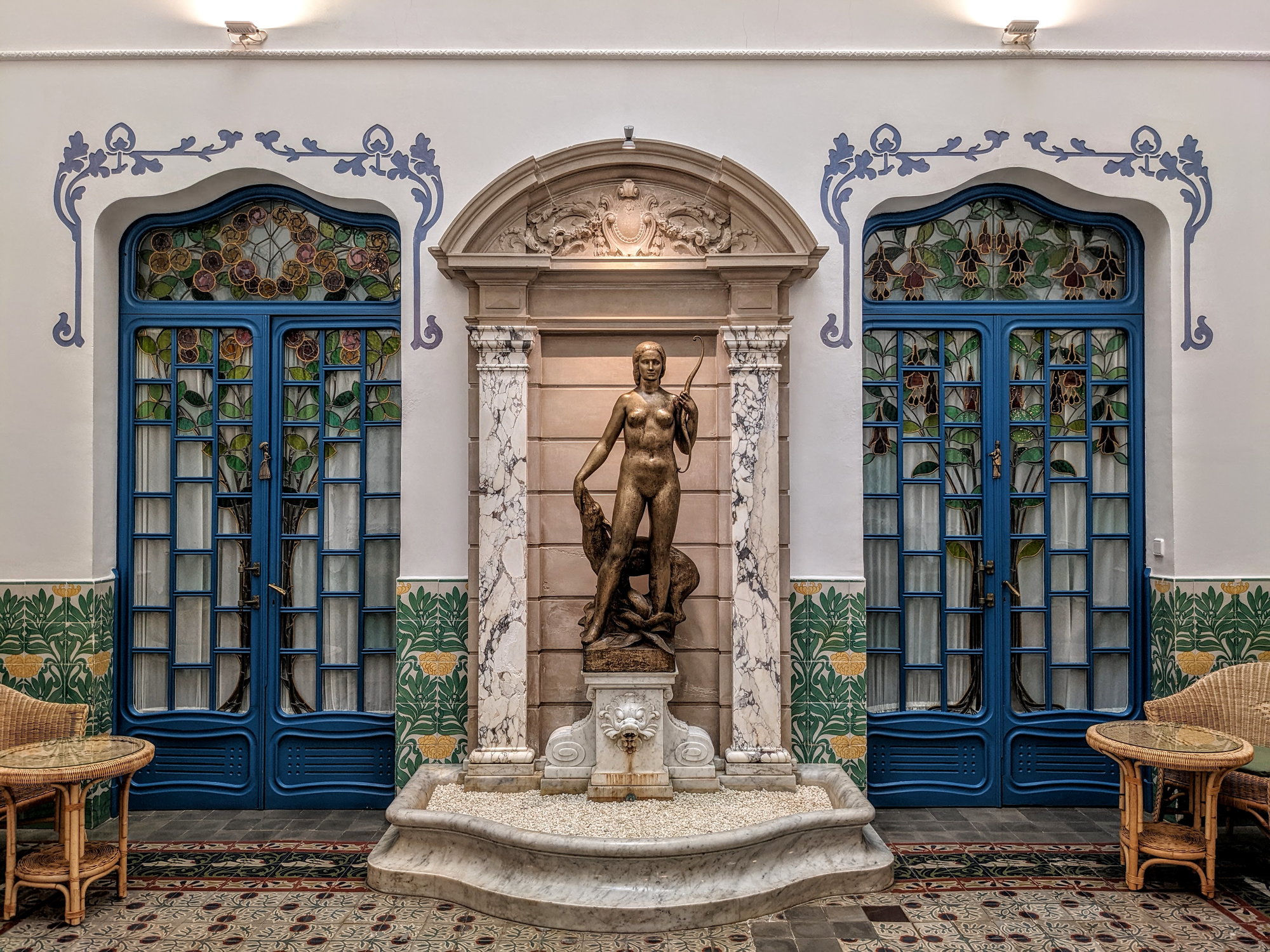
The statue of Diana
Our room was on the third floor with a little patio looking out to the sea and also to a big palm tree, shown in the photo below...

Our room and "our" palm tree; note the gargoyles, by sculptor Alfons Juyol
We enjoyed lounging on the little patio. It looked directly at the beach below and over to the right we could see the tower of the walled Old Town, the Vila Vella.
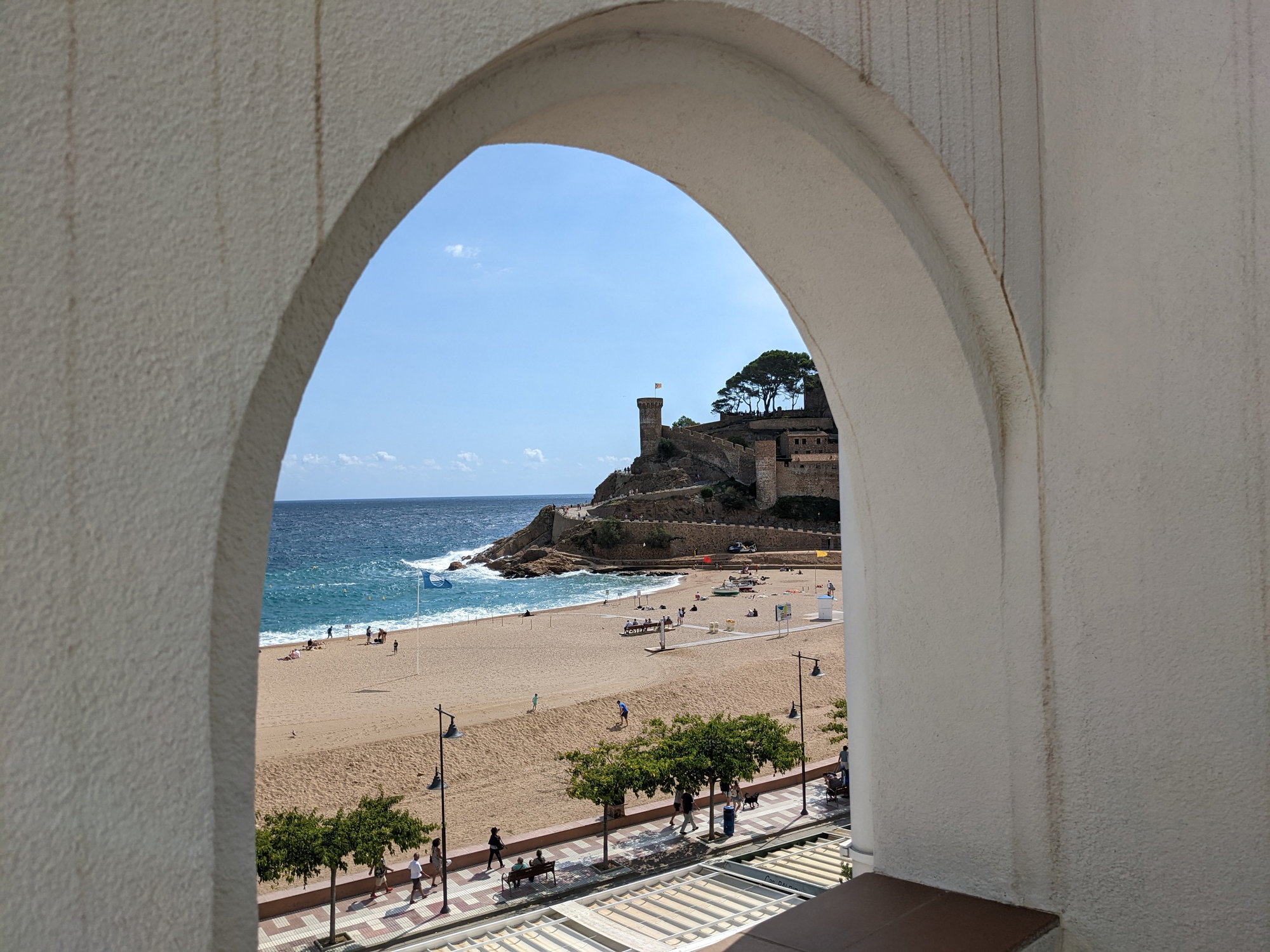

The views in the early evening were beautiful, as lights came on little by little along the coast...
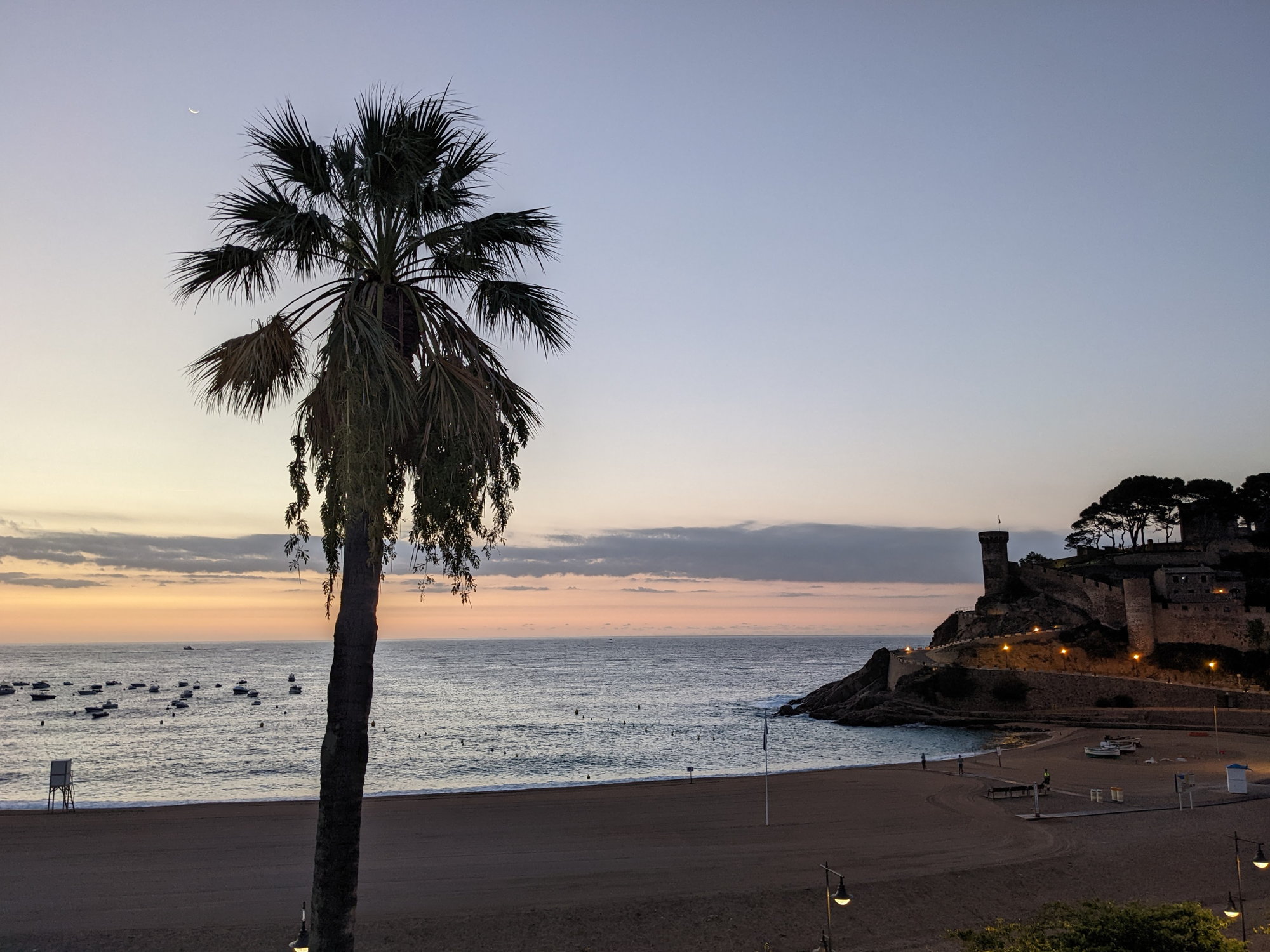

The interior of the main floor has lots of color, and the glass in the doors and windows glow in the sunlight...



In the evening the features of the building really came alive....
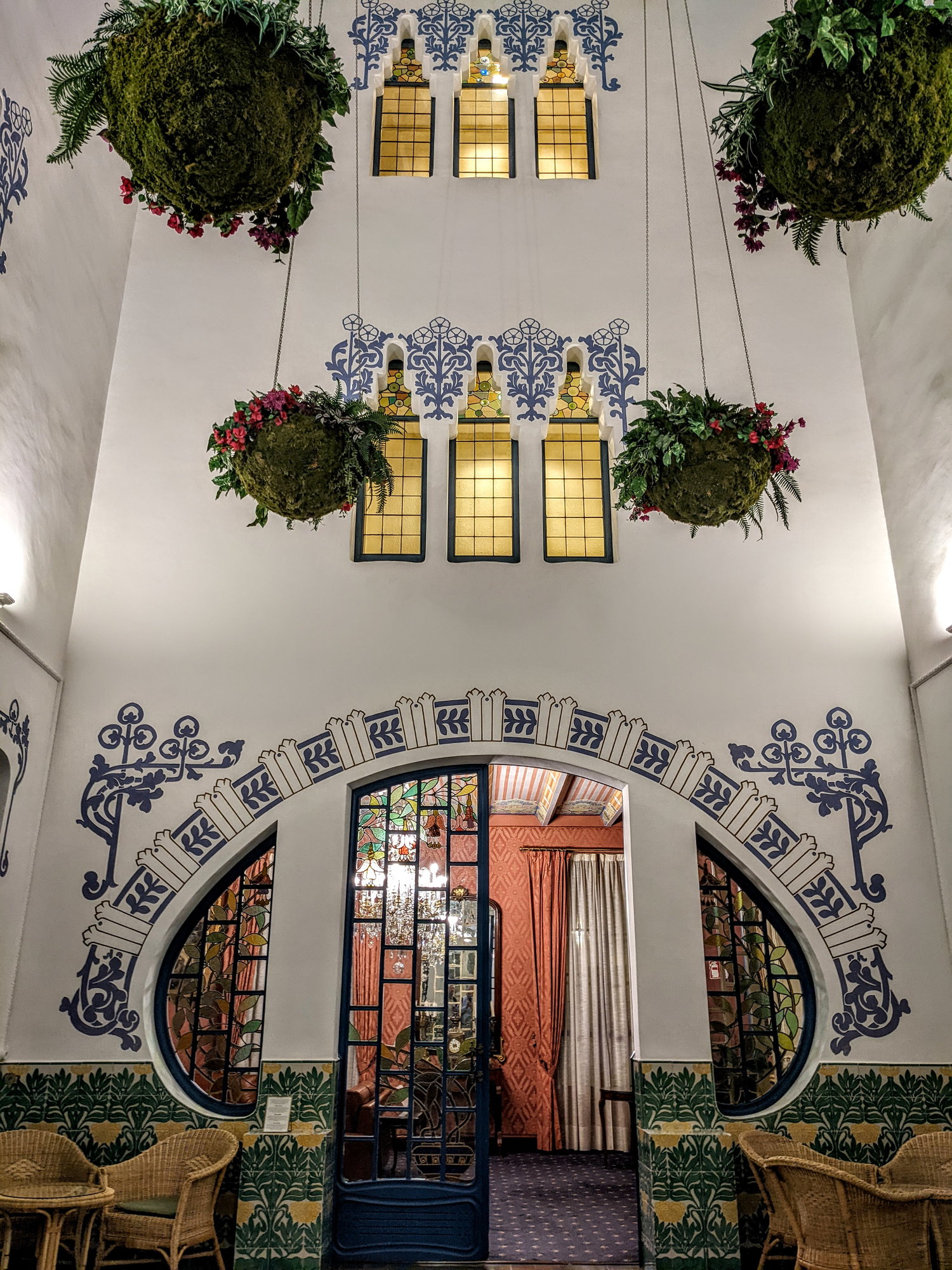
The facade facing the Mediterranean is white stucco with beautiful ornamentation. It includes a statue of Diana, goddess of the hunt, created some years after the building itself. The statue has been attributed to Frederic Mares, who also created the statue of "Barcelona" in the Placa de Catalunya.

The statue of Diana
Our room was on the third floor with a little patio looking out to the sea and also to a big palm tree, shown in the photo below...

Our room and "our" palm tree; note the gargoyles, by sculptor Alfons Juyol
We enjoyed lounging on the little patio. It looked directly at the beach below and over to the right we could see the tower of the walled Old Town, the Vila Vella.


The views in the early evening were beautiful, as lights came on little by little along the coast...


The interior of the main floor has lots of color, and the glass in the doors and windows glow in the sunlight...



In the evening the features of the building really came alive....

#18
Join Date: Mar 2014
Posts: 4,403
Likes: 0
Received 0 Likes
on
0 Posts
Your photos and TR remind me of our trip from 2010. But your photos are more beautiful than ours! We stopped in Tossa on our way to Cadaques, but we didn't stay overnight in Tossa. Your hotel is stunning. How many nights did you spend in Tossa? How many in Girona? We spent one night in Cadaques and 2 nights in Girona. Loved both places. Love the Costa Brava!
#19
Original Poster
Join Date: Aug 2013
Posts: 747
Likes: 0
Received 0 Likes
on
0 Posts
Hi Karen,
We stayed 2 nights in Tossa and loved the place, wished we could have added more nights. We spent 3 nights in Girona and really were fascinated by this city, so much history and the medieval quarter in particular was so interesting. Lots more photos coming...
We stayed 2 nights in Tossa and loved the place, wished we could have added more nights. We spent 3 nights in Girona and really were fascinated by this city, so much history and the medieval quarter in particular was so interesting. Lots more photos coming...
#20
Original Poster
Join Date: Aug 2013
Posts: 747
Likes: 0
Received 0 Likes
on
0 Posts
Tossa has a very interesting Roman ruin, a villa which lasted from about 100 BC to 400 AD, when the Roman empire collapsed and after that point there is little evidence about the people living in the villa and running the farming operation. In its heyday, the owner was a powerful lord. He controlled the bay of Tossa (or Turissa, as it was called). The villa controlled extensive vineyards, produced wine and exported it from docks in the harbor.
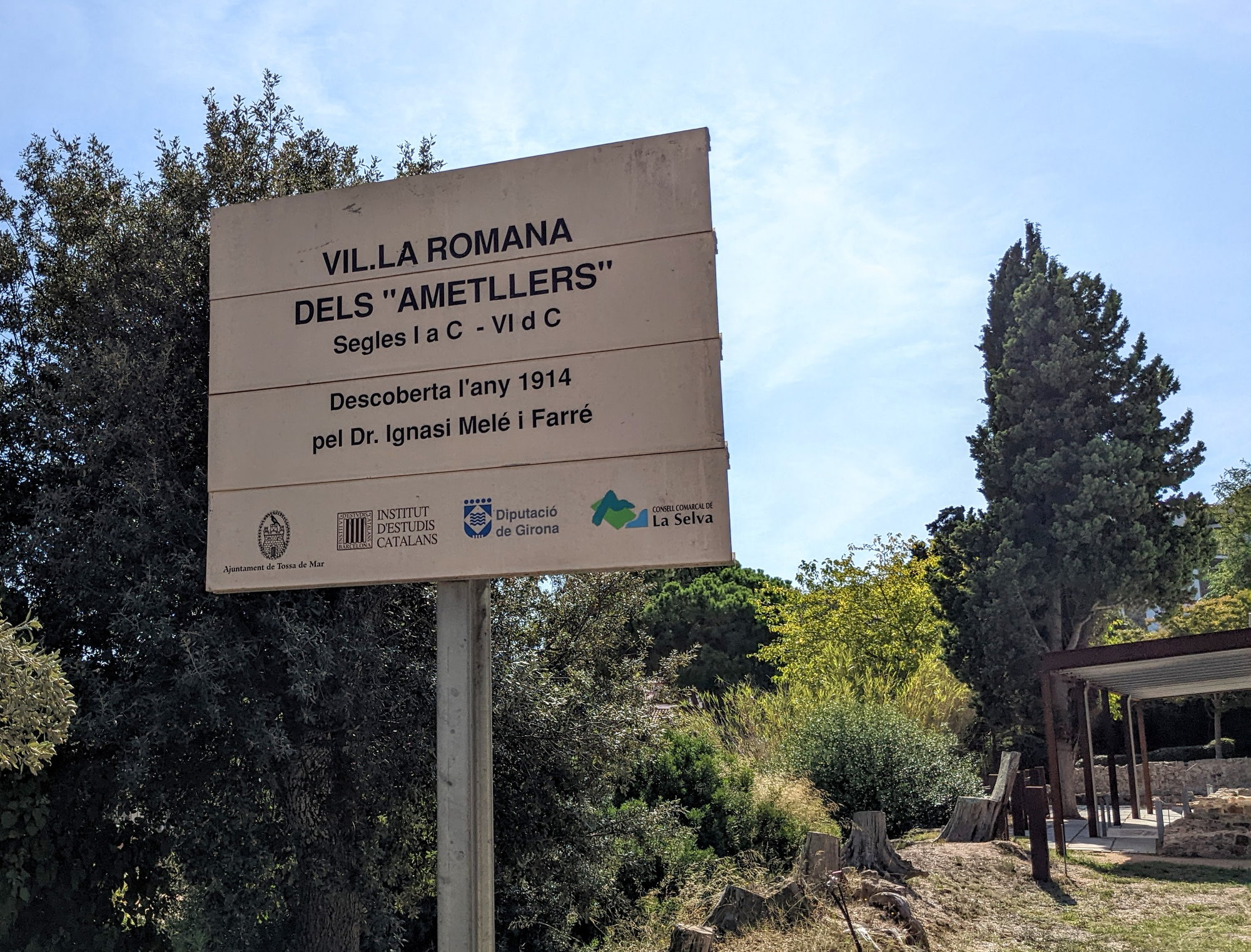
The entrance to the site of the villa
The foundations of many of the rooms survive, as do complex mosaics.
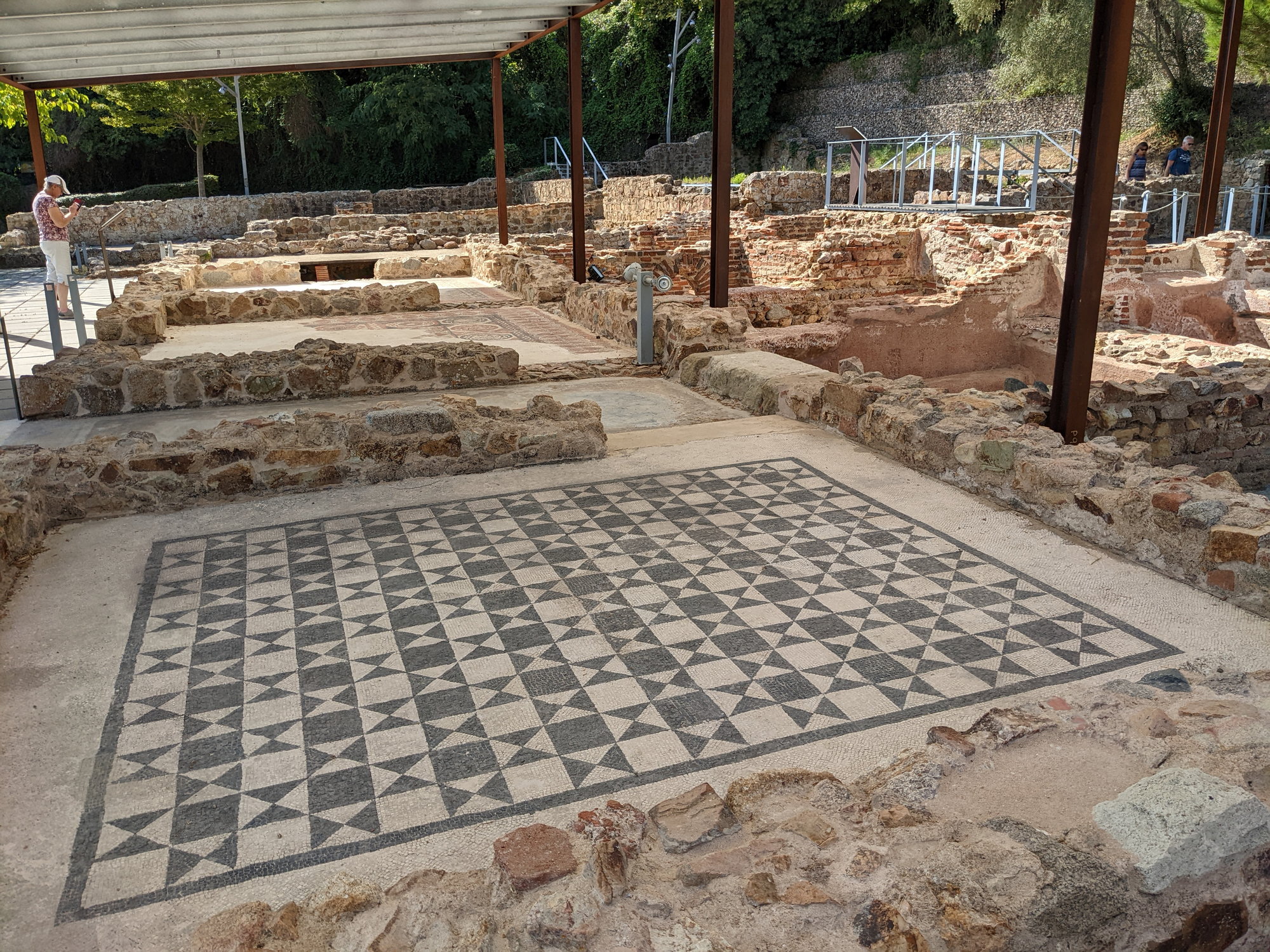
The mosaic floor, above, was one of the public rooms of the villa for receiving guests and dining.
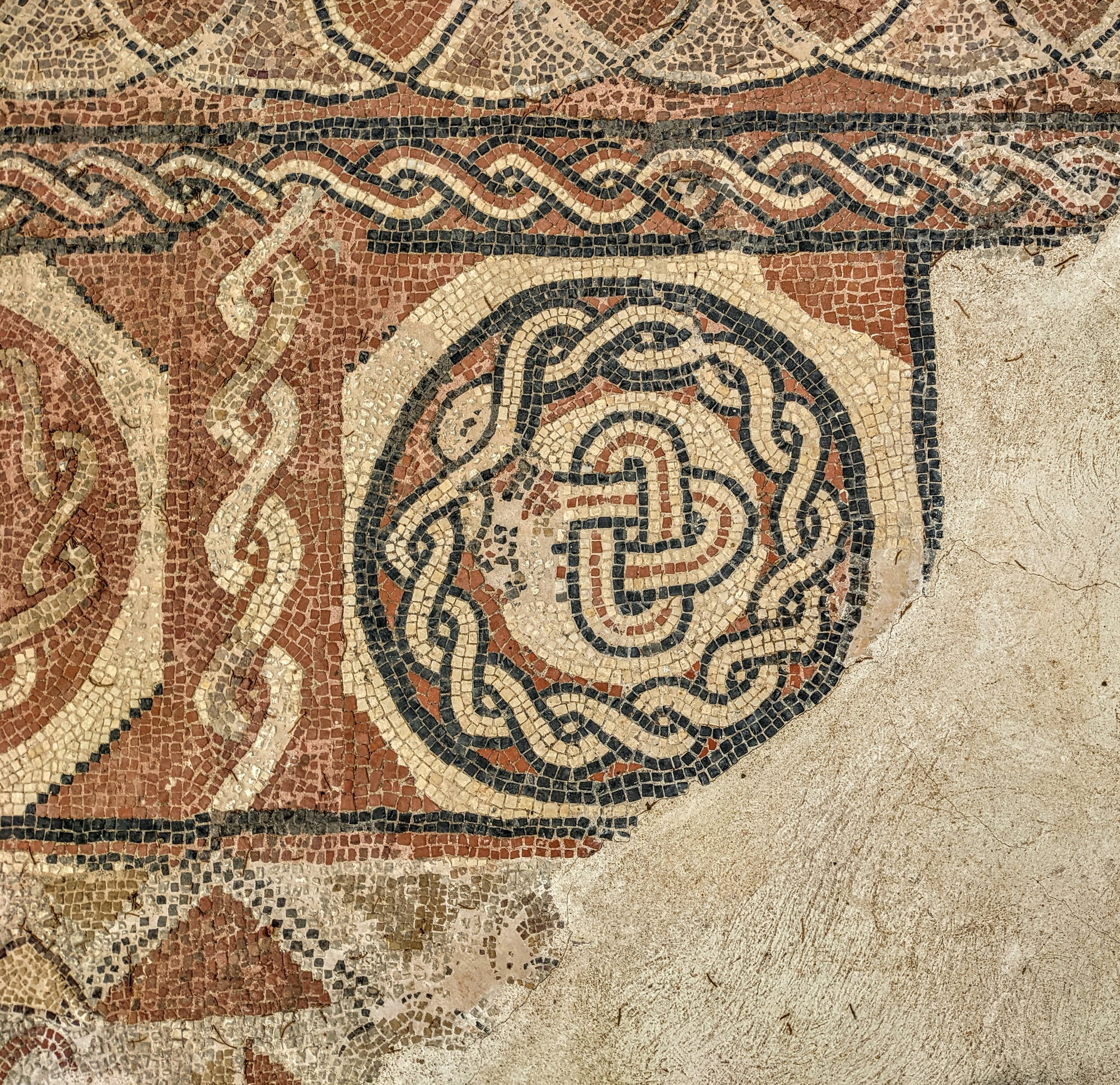
Above is a detail of the mosaic floor of one of the public rooms.
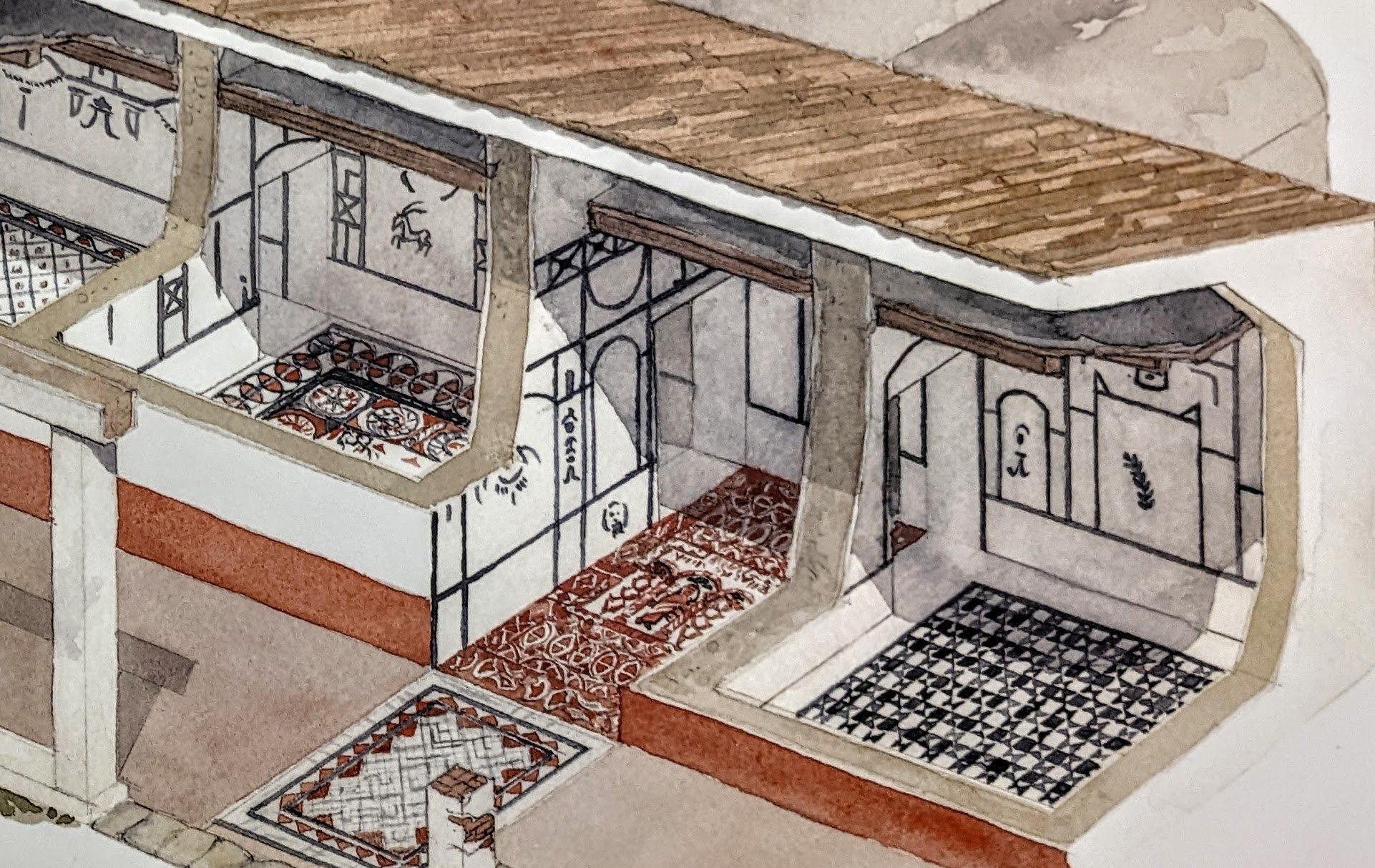
A reconstruction of some of the public rooms; the surviving floors of these rooms are shown in the mosaic photos above
The archeology museum of Tossa has a very large, intact mosaic from the villa, shown below. It sheds a little light on the powerful lord named Vitalis who lived in the villa, late 300s - early 400s AD. The inscription reads "Salvo Vitalis Felix Turissa Ex Officina Felices," which means "If Vitalis is well, Tossa will be fine, from the workshop of Felix [maker of the mosaic]".
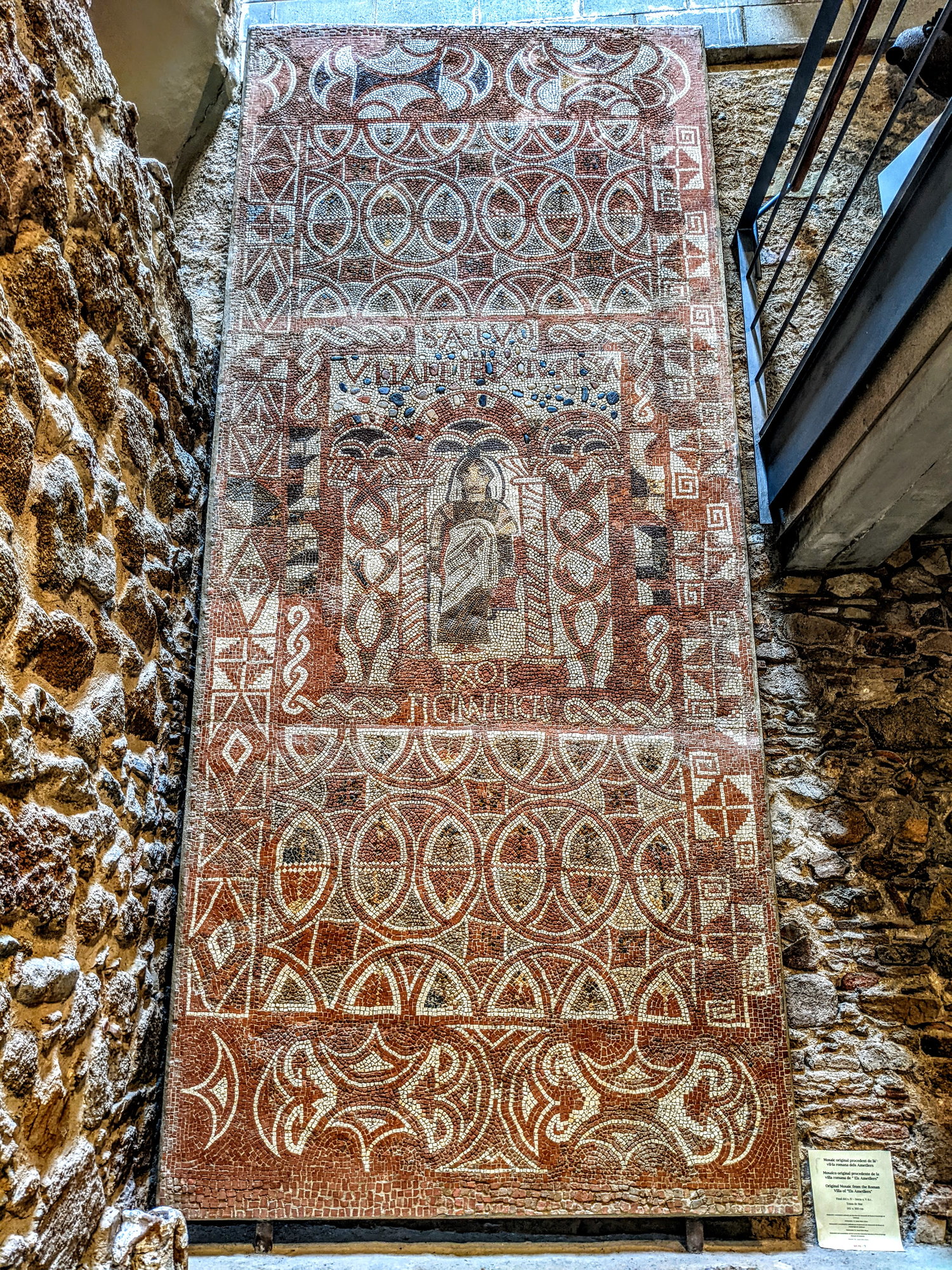
The wealth of the villa's owner is indicated by a few of the sculptures which were excavated...
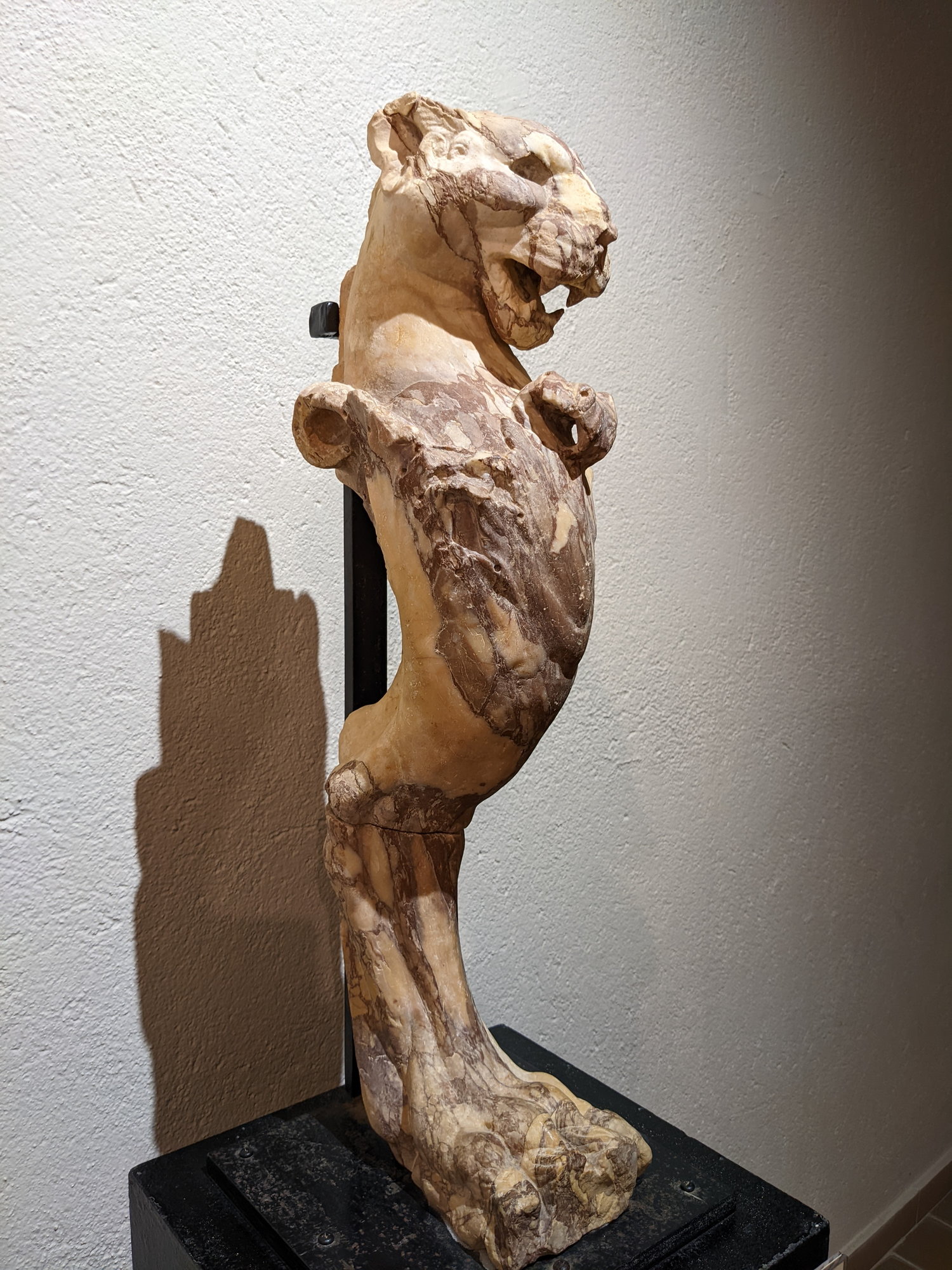
This is the elaborately sculpted leg of a table, made of Tunisian marble
This entire archeological site was a pleasant surprise. We stumbled across it on our arrival when we were walking from the bus station to our hotel.

The entrance to the site of the villa
The foundations of many of the rooms survive, as do complex mosaics.

The mosaic floor, above, was one of the public rooms of the villa for receiving guests and dining.

Above is a detail of the mosaic floor of one of the public rooms.

A reconstruction of some of the public rooms; the surviving floors of these rooms are shown in the mosaic photos above
The archeology museum of Tossa has a very large, intact mosaic from the villa, shown below. It sheds a little light on the powerful lord named Vitalis who lived in the villa, late 300s - early 400s AD. The inscription reads "Salvo Vitalis Felix Turissa Ex Officina Felices," which means "If Vitalis is well, Tossa will be fine, from the workshop of Felix [maker of the mosaic]".

The wealth of the villa's owner is indicated by a few of the sculptures which were excavated...

This is the elaborately sculpted leg of a table, made of Tunisian marble
This entire archeological site was a pleasant surprise. We stumbled across it on our arrival when we were walking from the bus station to our hotel.



